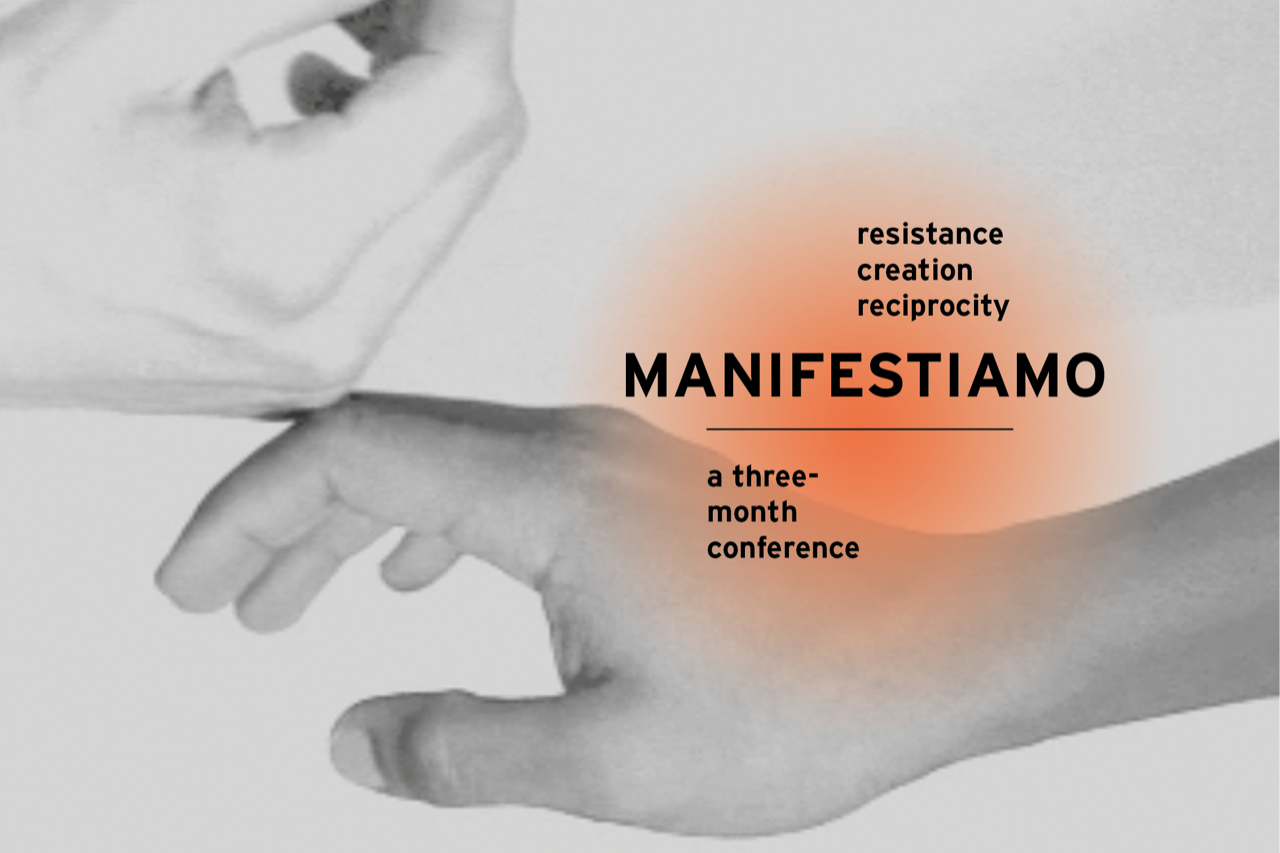MANIFESTIAMO is a collective format including installations, workshops, round tables, films and talks by more than 70 artists and researchers addressing issues of artistic practice and its current conditions over the course of three months. It is an open format that—following the Scuola Popolare in the summers of 2020 and 2021—shuns hierarchies and strategies of dominance, proposing institutional work as a collaborative process.
Since its beginnings, Villa Romana has been a space devoted to artistic thought and action, generating resonant spaces. A ‘protected’ space of this kind raises questions: who is protecting whom from what? Which space is allocated to art and from which is art excluded and separated? Is it possible to imagine an institutional practice that— in both its inner structure and its public work—does not aim for distance, consumption and canonisation, but seeks alliances that welcome all languages and speechlessness, all bodies and inadequacies? That creates or simply uses spaces to learn from and with each other, to exchange, to listen?
MANIFESTIAMO invites you to events with different thematic focuses every week from May to July. Participants are former Villa Romana fellows, artist-members of the Villa Romana Association, artists and collaborators from our neighbourhoods, researchers and artists invited to specific panels, as well as the HKW in Berlin and ADCF as collaborating partners.
We want to use the house and garden in the warm months for a multitude of encounters and experiences. We want to express and reflect the need for change.
Manifestare signifies that through the hands (mani) something becomes visible and audible.
You are all invited to be part of it!
Angelika Stepken, Luca Puri, Davood Madadpoor
All events are free of charge. During the events Villa Romana is open from 4 pm to midnight, on all other days the exhibition rooms are open Tuesday to Friday from 2 pm to 6 pm.
Villa Romana, Via Senese 68, 50124 Florence
OPENING
EXHIBITION
Giorgio Griffa
Unitiseparati
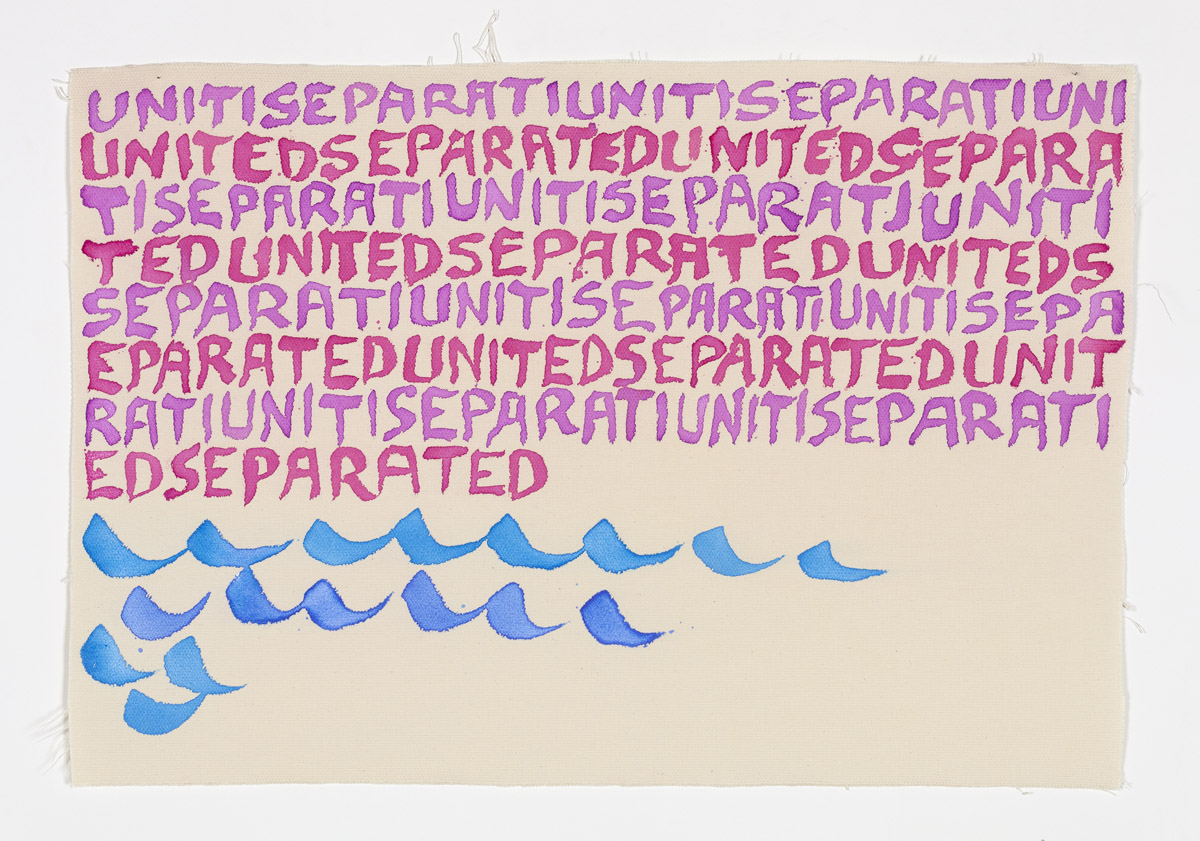
Introduction: Martin Holman, British art historian and writer
We are delighted to be hosting an exhibition by the painter Giorgio Griffa in the Salon of the Villa Romana. Griffa sees his selection of paintings from his last two years of work as a reflection on the relationship between the individual and the collective, between the thoughts that the 90 billion neurons generate in every individual of the eight billion humans currently living on this planet and those thought by the 100 billion humans who have lived before us. If it is true that the total amount of energy in the universe remains the same, then it circulates continuously between a state of indistinguishability on the one hand and a state of individual identity on the other. Griffa believes that painting is the search for fragments of this immense collective memory.
Giorgio Griffa was born in 1936 in Turin, where he still lives today. Since the late 1960s he has practised painting as a kind of punctuation, as an act that brings colour to the fore. The rhythm of the marks on the canvas is inspired by the rhythm of breathing, the rhythm of a way of writing before the advent of text. Its chromaticity is drenched in light; each and every colour appears as an intermediate hue. It was early in his career, in the 1960s, that he – having seen the frescoes in the Sistine Chapel – switched from oil to acrylic paint, because he felt that it reflected the light of the world more freely. Just as in watercolour painting, Griffa applies the paint in clear, characteristic marks on an unstretched canvas. When the painting is temporarily not on view (in collections or exhibitions), the canvas is folded and stored away. The folds remain visible as traces of this intermediate state.
Giorgio Griffa’s painting has been connected to Informel, Arte Povera, analytical, and even conceptual painting, but it is absolutely unique in its openness, its sensitive, yet deliberate approach and nonhierarchical materiality. It stands as a form of painting that always returns to the painting’s beginnings – the hand, the colour, the support, the light.
Since the late 1960s, the various groups of works to which Giorgio Griffa repeatedly refers and which he continues to develop have been shown around the world in over 150 solo exhibitions and many more group exhibitions. However, this is the first time in 45 years – since his 1977 exhibition at the Galeria Il Piramide – that his painting has been displayed in Florence.
Giorgio Griffa, Unitiseparati, 2020, acrylic on canvas; photo: Giulio Caresio, courtesy Archivio Giorgio Griffa
imagesCOLLECTIVE NEEDS – NEED FOR COLLECTIVES
INSTALLATION
Viron Erol Vert
Atoms, Soul, Senses
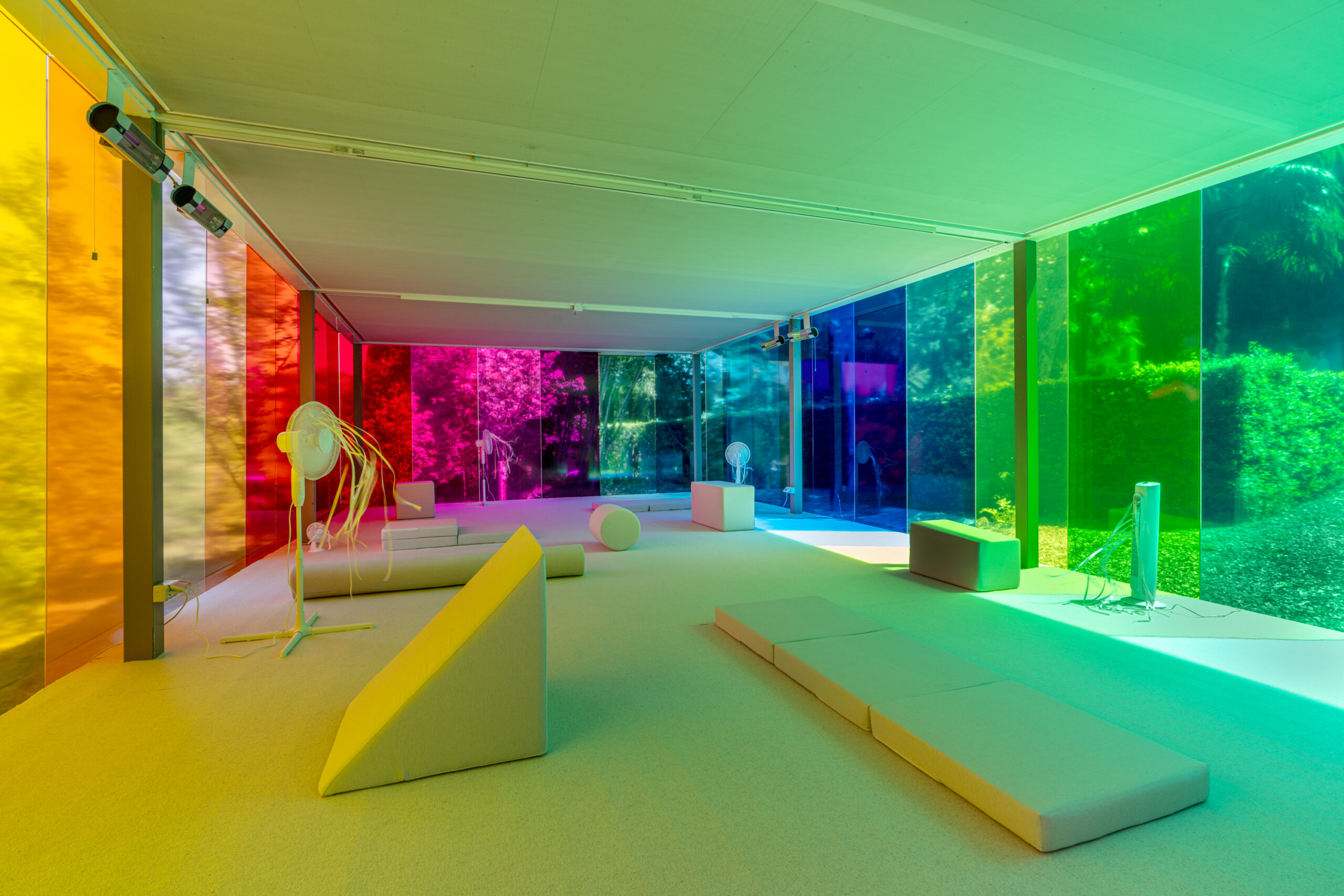
Viron Erol Vert uses the garden pavilion of the Villa as a light relationship space. The glass fronts are covered with 32 different coloured foils, in the interior six geometric bodies act as contact organs and as many fans let velvet ribbons flutter. On them are quotations from Lucretius’s De Rerum Natura. Viron Erol Vert read this book during his stay in Florence in 2018. Written in the 1st century B.C., this ‘instructional poem’ in six volumes is a critical religious text about the construction of society and culture in a world of atoms. Viron Erol Vert takes up the impetus of the Roman poet and philosopher to set ‘calmness of mind’ against fear and creates a minimalist space for it.
Viron Erol Vert, artist, born in Berlin, lives in Berlin and Istanbul, Villa Romana Fellow 2018.
Events inside Atoms, Soul, Senses:
13.05. 19:00 Concert: Anna Aurigi, soprano; Stefano Poli, pianoforte
12.06. 17:00 Poetry reading: Silvia Guasti (in Italian)
02.07. 21:30 Performance: Autumn Night
06.07. 21:00 Concert: Gea Brown
21.07. 18:00 Podcast listening: Gian Piero Frassinelli. Pensare e vivere la radicalità dell’architettura (in Italian)
Viron Erol Vert, Atoms, Souls and Senses, 2022, installation view, Villa Romana, IT. photo Ela Bialkowska OKNOstudio
imagesEXHIBITION
Heide Hinrichs
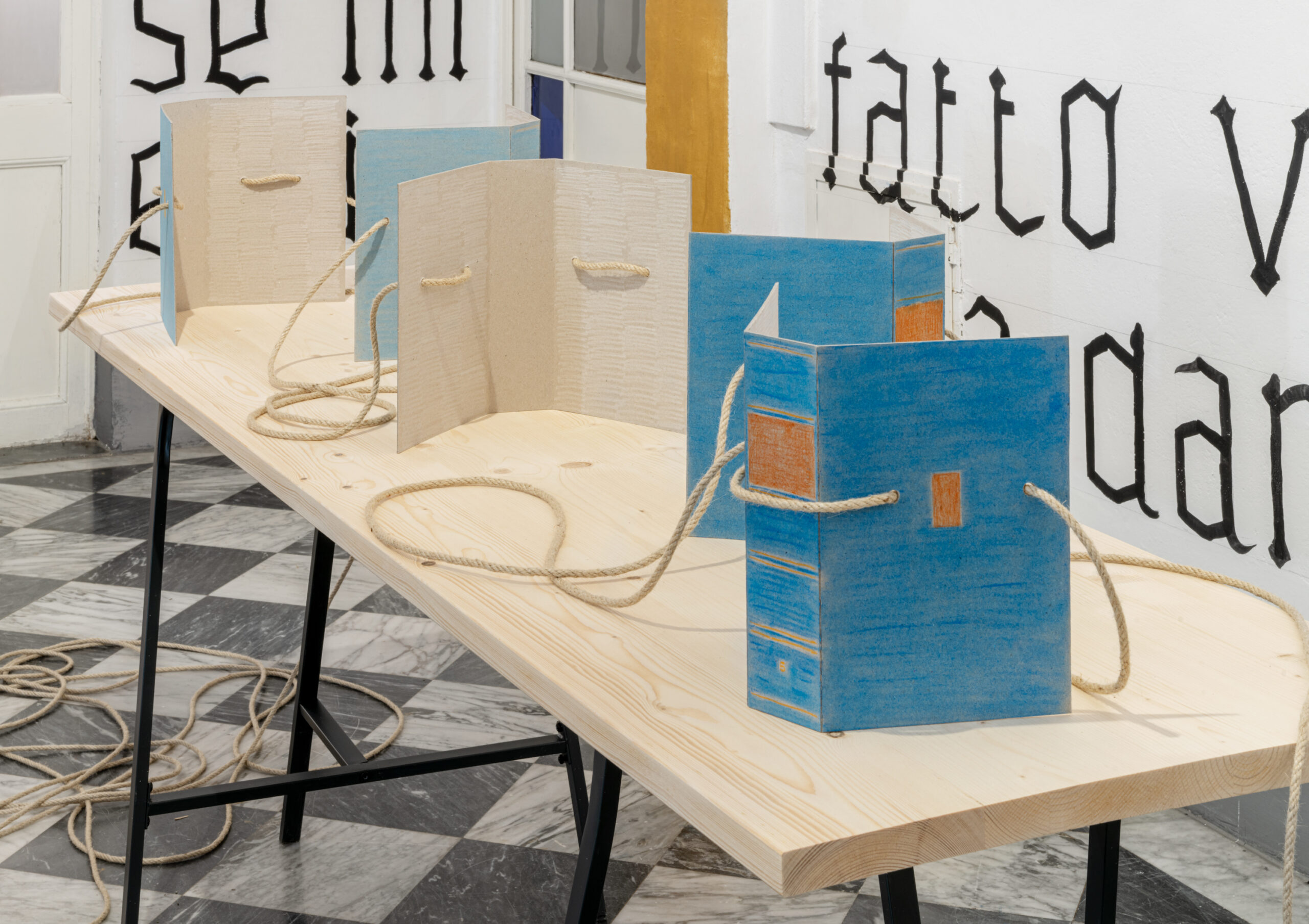
How to weave with canonical books? How to digest world history? Heide Hinrichs is cloning volumes of The Propylaea of World History weaving ropes through the simulated book covers. Covers that no longer hold content, but are secured like ruins and physically represent the absence of a narration and a loosening.
Heide Hinrichs, artist, lives and works in Brussels. She currently teaches at the Royal Academy of Fine Arts in Antwerp. Villa Romana Fellow 2011
Courtesy the artist
imagesCONCERT
Anna Aurigi, soprano
Stefano Poli, pianoforte
Music by Händel, Frescobaldi, Bellini, Gershwin.
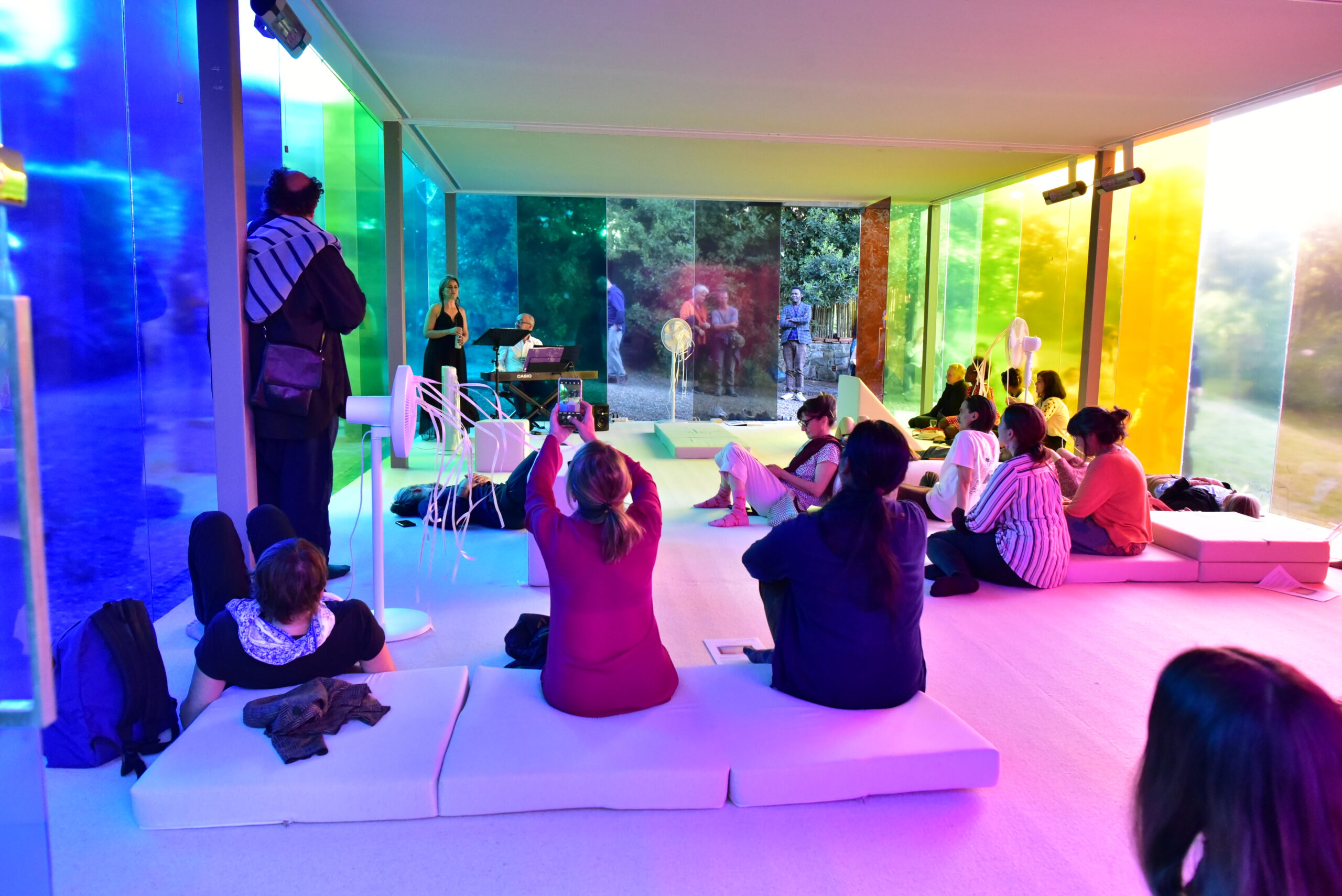
Anna Aurigi trained under the guidance of Lala Sarsowska and Anastasia Tomacewska.
After the classical maturity she graduated at the Conservatory Luigi Cherubini in Florence in Singing (1992) and in Vocal Chamber Music (1997 diploma, 2007 two-year specialist course) with Liliana Poli and Leonardo De Lisi. She then studied at the Accademia Chigiana in Siena with Shirley Verret and Alfredo Kraus, and in Germany with Julia Hamari. She studied the French repertoire with Sousanne Danco, and the Lieder repertoire with Irwin Gage at the Amici della Musica in Florence. She later studied the baroque repertoire with Jill Feldmann.
In 1996 she graduated with honors in History of Music at the Faculty of Arts and Philosophy in Florence with a thesis on the Venetian Barbara Strozzi, of whom she wrote the first complete modern edition of the First Book of Madrigals (Venice, 1644).
In the operatic field she has interpreted in particular roles belonging to operas of the seventeenth and eighteenth centuries (Serpina in Pergolesi’s Serva Padrona, Siena – 1992 – and Florence – 1993; Erminia in Michelangelo Rossi’s Erminia sul Giordano at the Teatro Manzoni in Pistoia – 2000; Roxanne in Rebel and Fancoeur’s Scanderberg in Lecce and Tirana – 2006), while in the oratorio and symphonic repertoire she ranges from the Baroque to the 20th century (Sances – Stabat Mater; Vivaldi – Gloria, Beatus Vir, Magnificat; Pergolesi – Stabat Mater; Bach – Cantata 51; Mozart – Requiem; Beethoven – Ninth Symphony; Saint Saens – Christmas Oratorio; Orff – Carmina Burana).
In addition to her concert activity, she also teaches, paying particular attention to issues related to singing technique and physiology of phonation, as well as to musicology.
She was recently (April 2021) at the Opera of Massy (Paris) and at the Conservatory of Toulouse (February 2022) where she taught an Italian diction course for opera singers, an activity she has been doing regularly for years collaborating with foreign singers, both students and professionals.
Since 2015 she has been teaching Renaissance and Baroque singing at the Conservatorio Giuseppe Verdi in Milan.
Stefano Poli graduated in piano in 1991 from the Luigi Cherubini Conservatory in Florence. He then continues to broaden his field of interest to polyphonic music of the Renaissance with studies and publications on treatises and unpublished repertoire especially in relation to the Florentine polyphonic lauda. He continued his studies in Choral Conducting and Composition at the Cherubini University and has been.
collaborating with various groups of ensemble music, record companies and music publishers. In the field of music publishing he is among the first to introduce digital musical writing in the transcription and publication of unpublished Renaissance reprints. Currently his interests as a composer and performer are directed to the jazz compositional language as a universe and complex and inexhaustible harmonic experimentation.
ROUND TABLE
YGBI: una risposta secca
With Christian Offman, Raziel Perin, Kelly Costigliolo, Ismael Lo, Jermay Michael Gabriel Cappelin – moderated by Justin Randolph Thompson

The YGBI Research Residency was designed as a platform that incentivizes collectivity, develops strategies for mutual support and fosters frameworks for discourse in relation to young artists of African descent within the context of Italy. Through its three editions, twelve artists have come together under four separate mentors; Andrea Fatona, Leaf Jerlefia, Arlette Louise Ndakoze and SA Smythe.
This round table is the first convening of the twelve artists all together and is structured to elaborate a tool kit for addressing collective needs while taking on institutional and societal obstacles. The talk addresses the power of the individual in attending to collective needs and the importance of looking across the table. It employs the quote from Cécile Kyenge as an invitation to be blunt and precise in advancing collective demands. The talk is moderated by Justin Randolph Thompson, director of Black History Month Florence and is coordinated by The Recovery Plan.
In collaboration with The Recovery Plan and Numeroventi
CONVIVIALITY / ARTIST BOOK
Andrea d’Amore
Luogo convivio atmosfera
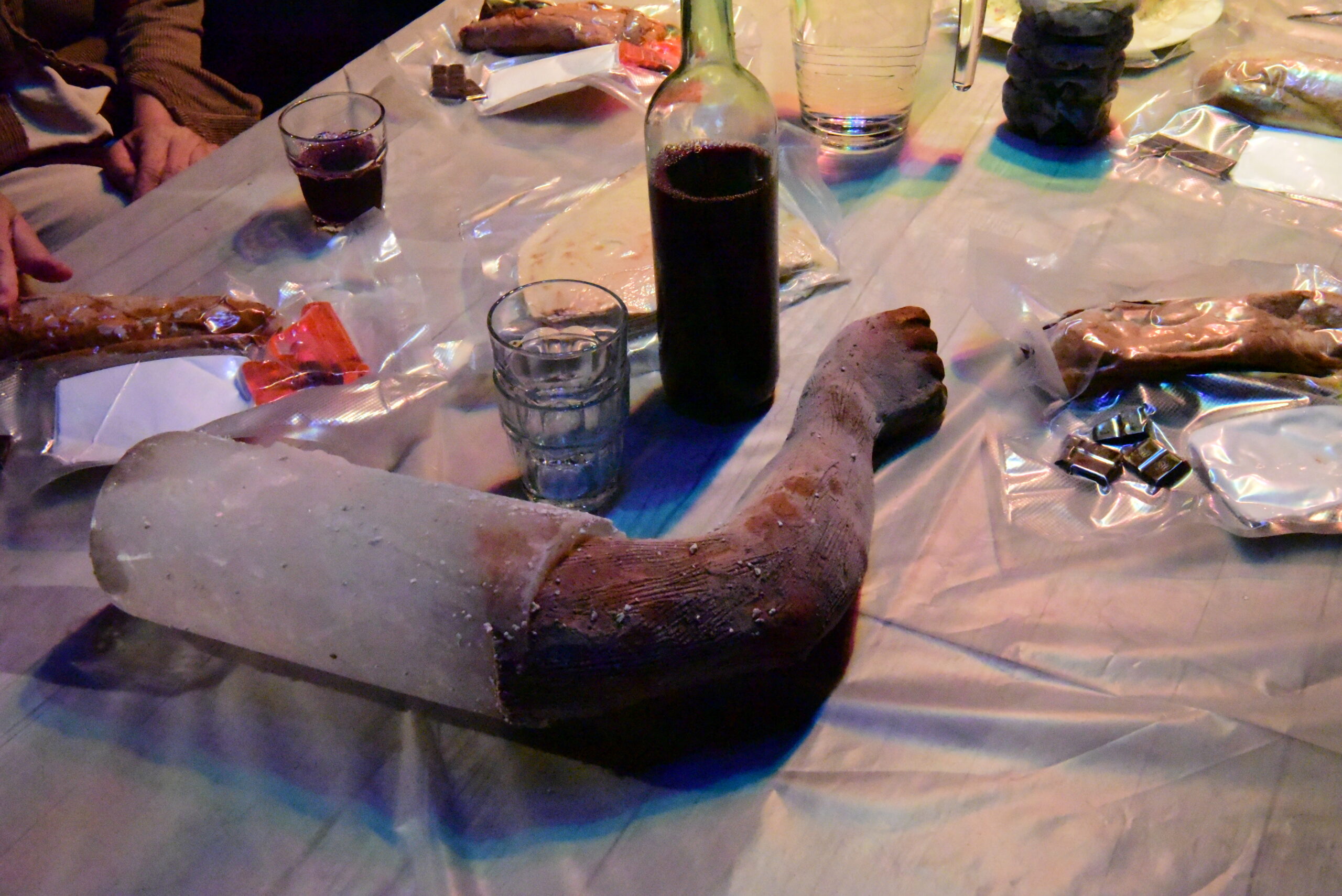
Haptic is feeling/thinking with what happens. Haptic perception also means hearing through sight, smelling through hearing, seeing through taste and tasting through sight. Haptic means relation, implication, participation and engagement. It is correspondence and resonance; hence it is exposure and listening, the in-between of action and passion. Feeling/thinking with signifies experiencing a sociality with the world prior to all objectual fragmentation, an attitude of intimacy, trepidation and conscious bewilderment along a space made up not of objects but of processes. (Nicola Perullo)
Andrea d’Amore, lives in Livorno, his work is focused on practices of conviviality.
CONNECT: ARTISTIC RESEARCH PLATFORMS IN THE MEDITERRANEAN
EXHIBITION
Michael Baers & Thomas Kilpper
Footnotes to the Disappearance of the Right to Have Rights

Michael Baers and Thomas Kilpper are developing a new joint project with drawings that will deal with the issue of migration to Europe, primarily in the period between May 2021 and December 2021. The artists will follow the thread outlining the ideology of ‘Fortress Europe’ (and the militarization of migration policy), linking the influx of migrants to Ceuta at the end of May 2021 with events in autumn and winter 2021 at the border between Belarus and the European Union as refugees attempt to cross from Belarus into the EU. They will make a series of drawings based on media images of these phenomena (with digressions on related topics such as the return of the Benin bronzes by France in November, developments in asylum policy in Denmark, and recent paramilitary and state violence against migrants in the Balkans, Greece and Italy). Each drawing will be numbered and accompanied by a caption describing its origin and context. These will be published in a small booklet accompanying the installation, which exhibition visitors will receive free of charge.
Michael Baers is a Berlin-based artist and writer known for his research-based comics and drawing projects. Since 2010 much of his work has focused on the fraught relationship between the MENA region and the West: ongoing research concerns the mass media and the Western Sahara conflict. He received his PhD from the Academy of Fine Art Vienna in 2014 and since 2020 is an affiliated researcher at Leibniz-Zentrum Moderner Orient (ZMO) in Berlin. Baers has exhibited his artistic work internationally in many institutions, including the Van Abbemuseum, Haus der Kulturen der Welt, and MAK Frankfurt am Main. He has also contributed to numerous books, journals, and publication projects. His 2014 graphic work, An Oral History of Picasso in Palestine was featured at the Third Berlin Documentary Forum.
Thomas Kilpper is an artist working preferably site-related and with a wide range of media – installation, sculpture, graphics, photography, video. He studied Fine Arts at the Staatliche Kunstakademie in Nürnberg, Düsseldorf and Frankfurt am Main where he accomplished his ‚Meisterschüler‘ exam at Städel; he received the Hap-Grieshaber Prize in 2003 and the Villa Romana Prize in 2011. Since 2008 he has been developing his long-term project A Lighthouse for Lampedusa!, he lives and works in Berlin. Projects include: The Ring, London (2000), State of Control, Stasi HQ Berlin 2009), SPEECH MATTERS, Pavilion for Revolutionary Free Speech, Danish Pavilion, 54th Venice Biennale (2011), A Lighthouse for Lampedusa!, Museum Bozar, Brussels (since 2008, ongoing), War Traces, Pinakothek der Moderne, Munich (2017)
Installation view, Villa Romana, IT. Courtesy the artist, photo Ela Bialkowska OKNOstudio
imagesEXHIBITION
Bassel el Saadi
Model for a Monument
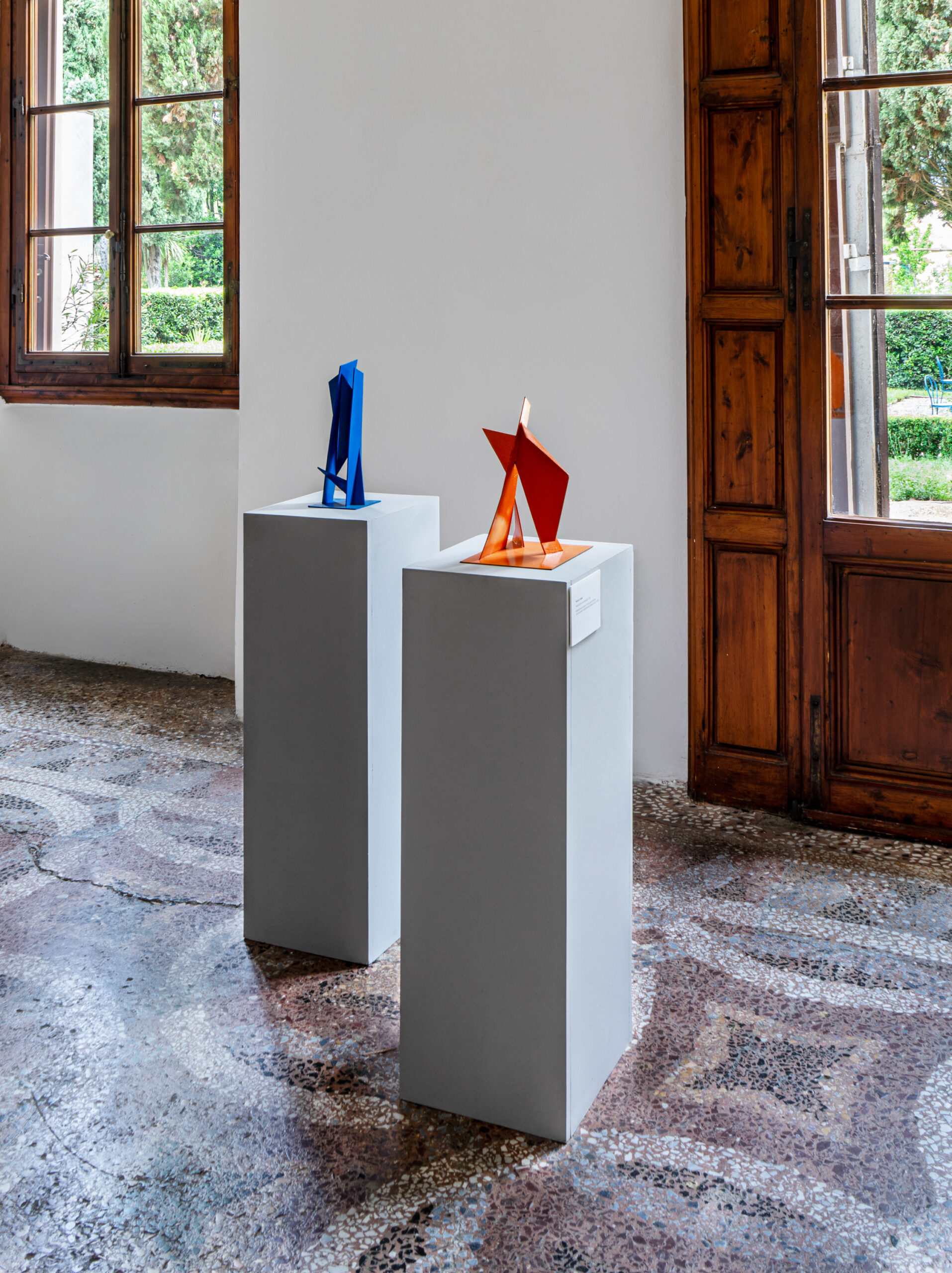
Sculpture is Associated with the Concept of Home
I was born in Beirut and we were displaced from our home there during the Lebanese civil war and we fled to Syria in 1976. The idea of a home has always been my obsession because we moved into many homes as a child. Art was my refuge to escape from school boredom when I was young. I used to draw on the notebook instead of following the teacher. I used to draw to pass the time and go home as quickly as possible.
After the age of 18 I chose to learn sculpting. I loved sculpting but there was still something boring and after years I discovered that I hate sculptural mass so I chose metal surfaces to define and shape space.
And after some years I went further, I made metal boxes and created complex geometric relationships and here I felt that I had reached home. Yes, the box was my home but the fears of losing the house did not end when the Syrian regime started its war on us in 2011. My children and I lost our home when we left it to escape the brutality of the Assad regime. After years of asylum in Italy, my children and I live together in one room. It was impossible to make a sculpture. Months ago, I was feeling sad because I hadn’t made a sculpture, but suddenly I got up at the small table and over the course of three days I made a small sculpture model that could be installed in large format in the public space. Then I felt like I’d found my home again.
The house. My children and I miss our house in Damascus, which was seized by the militias of the Assad regime. There is no better place than Villa Romana to display a sculpture model (that can be installed in the public space). When I arrived in Italy to escape the war in 2017, with two children, Villa Romana was the first home for my children in Italy, where Angelika and Claudia welcomed us with great generosity. We stayed for a year and the exhibitions were the back rooms for my children. They felt safe in the presence of art.
Villa Romana will always remain in the imagination of my children, the home that protected them from their fears.
Bassel el-Saadi (1971, Beirut), lived and worked in Damascus, now close to Florence. Guest artist at Villa Romana 2017 / 2018.
Bassel el Saadi, Model for a monument, 2021. Courtesy the artist, photo Ela Bialkowska OKNOstudio
imagesSYMPOSIUM
Connect: Artistic Research Platforms in the Mediterranean
Qalqalah (France), Platform HARAKAT (Spain), Dar Jacir (Palestine), Kayfa ta (Egypt/Jordan), THE ΤΕΛΟΣ SOCIETY (Greece), Le 18/QANAT (Morocco), Broken Archive (Italy)
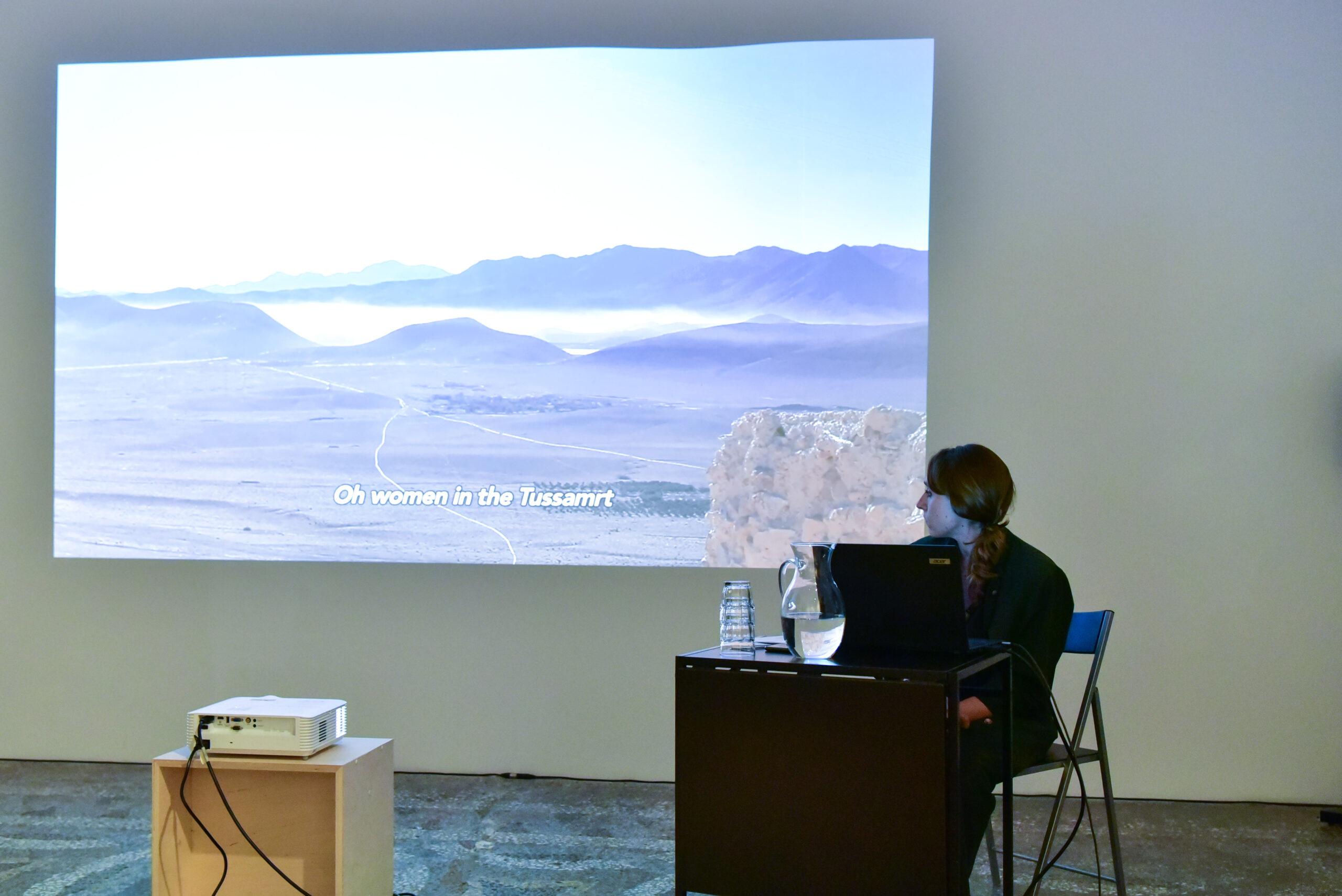
The Mediterranean region is a transcontinental space where many languages are spoken. Those who live in the countries around the Mediterranean feel connected to the entire region because of the climate (and its catastrophic development), the vegetation, shared histories and customs. Politically, the Mediterranean is a zone of diverse demarcations, crises and conflicts – not least between the European and the Arab and African states against the background of imperial and colonial occupations. Culturally, there are selective collaborations that reject the sea as a medium of distance, but often fail due to a lack of institutional and transnational support.
Since (digital) archives for the appropriation and rewriting of history have become virulent in artistic practice, new levels of exchange and collaboration between the different shore zones have become possible. They offer starting points to re-explore and revitalize a destroyed, negated or forgotten history of the cultural space.
By inviting six artistic research projects, we would like to further encourage networking and promote a rhizomatic exchange of knowledge and future joint strategies.
Qalqalah قلقلة
Platform Harakat
Dar Yusuf Nasri Jacir
Kayfa ta
THE ΤΕΛΟΣ SOCIETY | TTS
Le 18/QANAT
The Broken Archive
Qalqalah قلقلة is an editorial and curatorial platform dedicated to the production, translation and circulation of artistic, theoretical and literary research in three languages: French, Arabic and English. Founded in 2018 in France,Qalqalah قلقلة asserts a feminist, inclusive and intersectional stance. It relies on translation as a tool for the production and reception of situated knowledge, capable of making visible the relations of power and the possibilities of invention and affection that are at play between languages, temporalities and contexts that are marked by the colonial legacy, conflicts and contemporary revolts.
Named after the word movements in Arabic, Platform HARAKAT embodies the inherent contradictions of travelling: movements occur despite and because of a paradox simultaneously promoting, impeding, and forcing mobility. Adopting a cross-disciplinary perspective to curatorial practice and artistic research, Platform HARAKAT proposes to retrace the past and contemporary mobility of knowledge(s), bodies and practices focusing in the Mediterranean region. The purpose of Platform HARAKAT is to reflect upon different approximations to the journey, the heritage of its traditions and its erasures. We want to set in motion concepts and practices derived from mobility and its shadows, to document forgotten histories and invisible stories, to stress the important connections that shape these territories, while providing a space for critical reflection and action.
Dar Yusuf Nasri Jacir for Art and Research is a grass-roots independent artist–run initiative founded in 2014 and is located in a 19th century family home in Bethlehem. The site serves as a place in which the history and contemporary conditions of Bethlehem meet, enabling the exchange and production of new art works and visions towards the future. Knowledge production and research are the key pillars behind Dar Jacir. Workshops, seminars and master classes are conducted to facilitate the circulation of creative and intellectual endeavors across a range of disciplines and media in particular art and cinema. In the future, we plan on hosting scholars in Ottoman studies from around the world in addition to artists, academics, musicians and filmmakers to use these archives.
Kayfa ta is a publishing initiative that uses the popular form of how-to manuals (how=kayfa, to=ta) to respond to some of today’s perceived needs; be they the development of skills, tools, thoughts, or sensibilities. These books situate themselves in the space between the technical and the reflective, the everyday and the speculative, the instructional and the intuitive, the factual and the fictional. Kayfa ta was founded in 2012 by Maha Maamoun and Ala Younis.
THE ΤΕΛΟΣ SOCIETY | TTS, Arts & Culture Research Lab Observatorium takes from the work of Deleuze, particularly pursuing a creative method of ‘virtual pragmatics’ and ‘topological thinking’ – TTS is oriented to discovering the means to sculpt the virtual space of societies, systems, and ecosystems. That is, the telos – the innate coordinating forces or ‘phase space’ of a distributed and layered dynamical systems. Transdisciplinary at its core, TTS embraces the notion of metamodernism, as expressed by David Foster Wallace.
QANAT is a collective platform initiated and curated by Francesca Masoero and hosted by the cultural space LE 18 (Marrakech) that explores the politics and poetics of water in Morocco and beyond to reflect and act upon the multiple contextual understandings and forms of (re)production of the commons. Mirroring the rhizomatic structure of the khettara system, QANAT is a methodologically diverse platform, a collective network in becoming composed of artists, cultural activists, community practitioners and researchers, which swings fluidly between artistic practices, social action and spatial research, and grounds itself on a praxis meant as inclusive, sustainable, radical and rhizomatic.
The Broken Archive. Artistic Practices Bridging the Mediterranean was launched last year at Villa Romana and brings together artistic projects that investigate the history of and present-day life in the Mediterranean region. A variety of artistic projects is organized into twelve cluster terms. These projects are presented with images, texts, PDFs, and films or trailers on the corresponding artists’ pages. Keywords and a search function offer additional orientation and a range of references. The Broken Archive seeks to create rhizomatic references across the transcontinental Mediterranean region. Artistic works and texts emerge like archipelagos in search of community, resonance, connection.
Eva Sauer, Livorno, 40.09 N, 17.1 E, from the series Beyond the Visible. Ships, 2020. Courtesy the artist.
imagesPUBLIC WORKING GROUP
Connect: Artistic Research Platforms in the Mediterranean
Qalqalah (France), Platform HARAKAT (Spain), Dar Jacir (Palestine), Kayfa ta (Egypt/Jordan), THE ΤΕΛΟΣ SOCIETY (Greece), Le 18/QANAT (Morocco), Broken Archive (Italy)
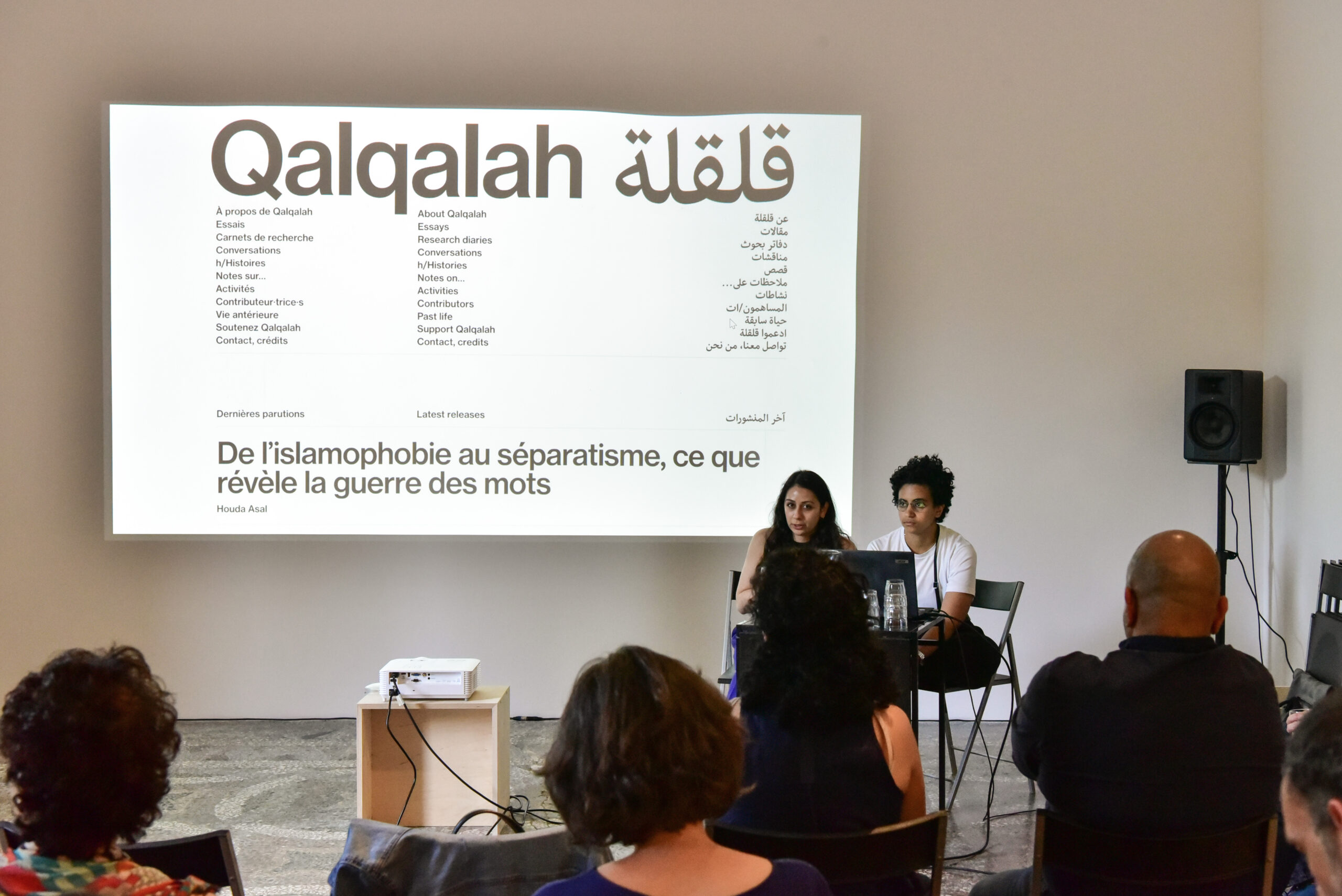
10 am – 5pm
The Mediterranean region is a transcontinental space where many languages are spoken. Those who live in the countries around the Mediterranean feel connected to the entire region because of the climate (and its catastrophic development), the vegetation, shared histories and customs. Politically, the Mediterranean is a zone of diverse demarcations, crises and conflicts – not least between the European and the Arab and African states against the background of imperial and colonial occupations. Culturally, there are selective collaborations that reject the sea as a medium of distance, but often fail due to a lack of institutional and transnational support.
Since (digital) archives for the appropriation and rewriting of history have become virulent in artistic practice, new levels of exchange and collaboration between the different shore zones have become possible. They offer starting points to re-explore and revitalize a destroyed, negated or forgotten history of the cultural space.
By inviting six artistic research projects, we would like to further encourage networking and promote a rhizomatic exchange of knowledge and future joint strategies.
Qalqalah قلقلة
Platform Harakat
Dar Yusuf Nasri Jacir
Kayfa ta
THE ΤΕΛΟΣ SOCIETY | TTS
Le 18/QANAT
The Broken Archive
Qalqalah قلقلة is an editorial and curatorial platform dedicated to the production, translation and circulation of artistic, theoretical and literary research in three languages: French, Arabic and English. Founded in 2018 in France,Qalqalah قلقلة asserts a feminist, inclusive and intersectional stance. It relies on translation as a tool for the production and reception of situated knowledge, capable of making visible the relations of power and the possibilities of invention and affection that are at play between languages, temporalities and contexts that are marked by the colonial legacy, conflicts and contemporary revolts.
Named after the word movements in Arabic, Platform HARAKAT embodies the inherent contradictions of travelling: movements occur despite and because of a paradox simultaneously promoting, impeding, and forcing mobility. Adopting a cross-disciplinary perspective to curatorial practice and artistic research, Platform HARAKAT proposes to retrace the past and contemporary mobility of knowledge(s), bodies and practices focusing in the Mediterranean region. The purpose of Platform HARAKAT is to reflect upon different approximations to the journey, the heritage of its traditions and its erasures. We want to set in motion concepts and practices derived from mobility and its shadows, to document forgotten histories and invisible stories, to stress the important connections that shape these territories, while providing a space for critical reflection and action.
Dar Yusuf Nasri Jacir for Art and Research is a grass-roots independent artist–run initiative founded in 2014 and is located in a 19th century family home in Bethlehem. The site serves as a place in which the history and contemporary conditions of Bethlehem meet, enabling the exchange and production of new art works and visions towards the future. Knowledge production and research are the key pillars behind Dar Jacir. Workshops, seminars and master classes are conducted to facilitate the circulation of creative and intellectual endeavors across a range of disciplines and media in particular art and cinema. In the future, we plan on hosting scholars in Ottoman studies from around the world in addition to artists, academics, musicians and filmmakers to use these archives.
Kayfa ta is a publishing initiative that uses the popular form of how-to manuals (how=kayfa, to=ta) to respond to some of today’s perceived needs; be they the development of skills, tools, thoughts, or sensibilities. These books situate themselves in the space between the technical and the reflective, the everyday and the speculative, the instructional and the intuitive, the factual and the fictional. Kayfa ta was founded in 2012 by Maha Maamoun and Ala Younis.
THE ΤΕΛΟΣ SOCIETY | TTS, Arts & Culture Research Lab Observatorium takes from the work of Deleuze, particularly pursuing a creative method of ‘virtual pragmatics’ and ‘topological thinking’ – TTS is oriented to discovering the means to sculpt the virtual space of societies, systems, and ecosystems. That is, the telos – the innate coordinating forces or ‘phase space’ of a distributed and layered dynamical systems. Transdisciplinary at its core, TTS embraces the notion of metamodernism, as expressed by David Foster Wallace.
QANAT is a collective platform initiated and curated by Francesca Masoero and hosted by the cultural space LE 18 (Marrakech) that explores the politics and poetics of water in Morocco and beyond to reflect and act upon the multiple contextual understandings and forms of (re)production of the commons. Mirroring the rhizomatic structure of the khettara system, QANAT is a methodologically diverse platform, a collective network in becoming composed of artists, cultural activists, community practitioners and researchers, which swings fluidly between artistic practices, social action and spatial research, and grounds itself on a praxis meant as inclusive, sustainable, radical and rhizomatic.
The Broken Archive. Artistic Practices Bridging the Mediterranean was launched last year at Villa Romana and brings together artistic projects that investigate the history of and present-day life in the Mediterranean region. A variety of artistic projects is organized into twelve cluster terms. These projects are presented with images, texts, PDFs, and films or trailers on the corresponding artists’ pages. Keywords and a search function offer additional orientation and a range of references. The Broken Archive seeks to create rhizomatic references across the transcontinental Mediterranean region. Artistic works and texts emerge like archipelagos in search of community, resonance, connection.
Eva Sauer, Livorno, 40.09 N, 17.1 E, from the series Beyond the Visible. Ships, 2020. Courtesy the artist.
imagesUNTRANSLATABLE/ON CREATION AND ECONOMY
FOUR-DAYS WORKSHOP WITH PUBLIC INTERVENTIONS
L’INTRADUCIBILE [The Untranslatable]
With Leonora Bisagno, Bruno Baltzer, Cindy Coutant, Akim Pasquet, Anne-Sarah Huet, Helen Ibry, Jacopo Rasmi, Paca Rimbau Hernàndez
[Closed workshop day]
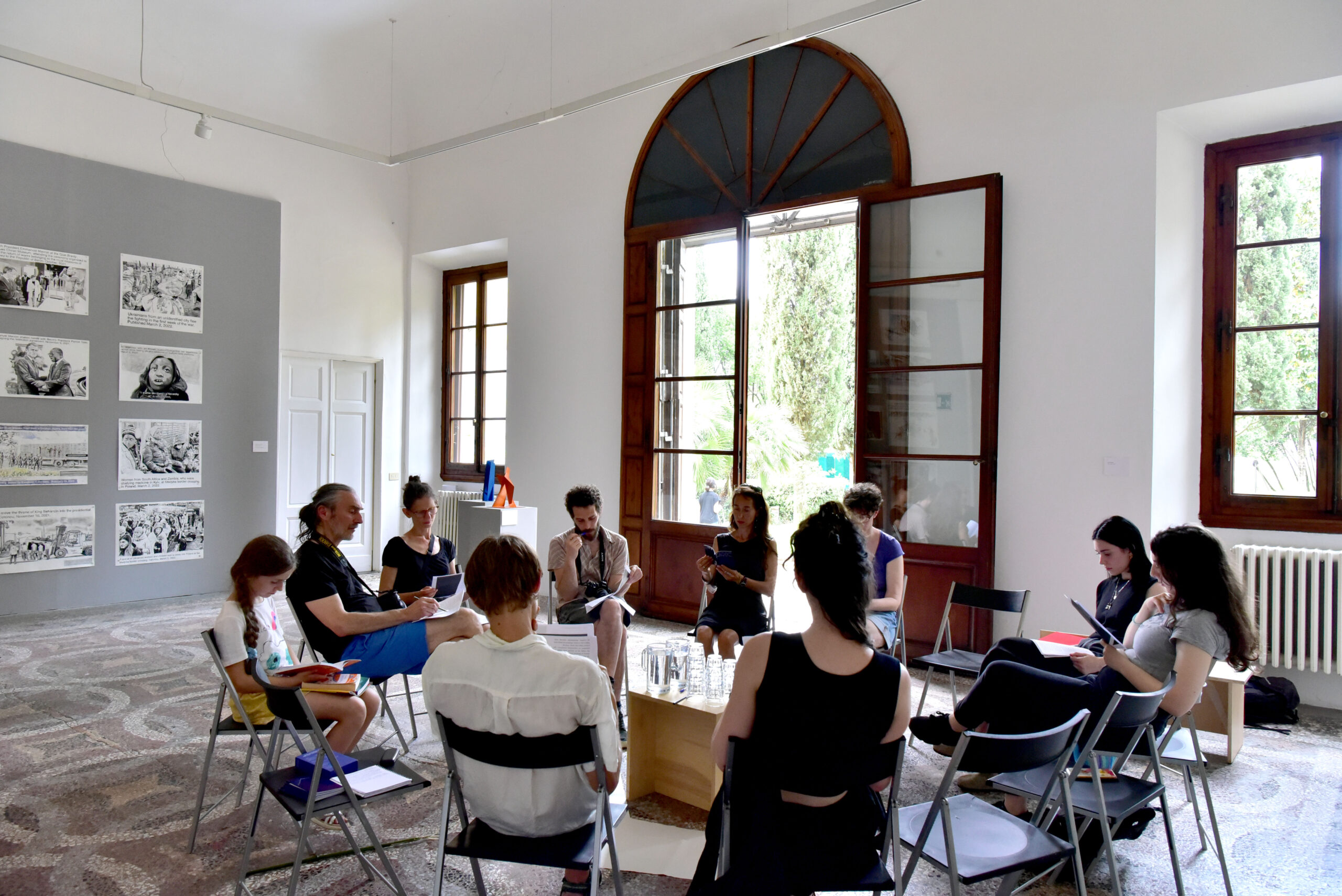
The Untranslatable three-day group is a collaborative and multidisciplinary project proposed by Bruno Baltzer, Leonora Bisagno, Cindy Coutant and Akim Pasquet together with other invited guests to explore the concept of untranslatable. Starting from a double image of translation-nomination, the group wishes to practice, through plural and heterogeneous approaches, the epistemic limits that are declared between a dominant translation, designating and circumscribing the world within parameters of legibility and that of the untranslatable as an act of resistance and transformation of the world, betraying the tyrant paradigm in a politics of differences and in an ecology of differences. The Untranslatable three-day group aims to be an open exercise spreading through different interventions, experimenting languages that are ultimately devoid of signifiers, acting vis-à-vis political invisibilisation, opening up to an emancipatory dimension as a necessary utopia for creating living communities.
PROGRAMME
TH 26.05
09:00
WORKSHOP – Intraducibile [The Untranslatable] – closed workshops day
FR 27.05
09:00
WORKSHOP – Intraducibile [The Untranslatable] – closed workshop morning
14:00
MANIFESTIAMO and Passaparola from Villa Romana to Piazza Tasso.
MANIFESTIAMO and Passaparola are two lively actions, which take place outside the Villa Romana at the encounter of people in the neighbourhood. Starting from the beautiful title given to the MANIFESTIAMO – on resistance, creation and reciprocity – three – month conference, the actions aim to open the institution spaces, to let circulate the words, to translate, reinvent, experiment languages in the public space.
17:30
LECTURES – Against translation and other lectures
Against Translation is a text by American poet Kenneth Goldsmith (born 1961) published in eight volumes–English, French, Spanish, German, Chinese, Japanese, Russian and Arabic. The author discusses the impasses and shortcomings of translation and the virtues of an unapologetic linguistic – displacement.
SA 28.05
09:00
WORKSHOP – Vulnerable text (on inscription – register till 27.05: office@vilaromana.org)
workshop and (a) fanzine production investigating the idea of vulnerability as the affect of a text.
14:00
WORKSHOP – A word-collective story workshop (on inscription – register till 27.05: office@vilaromana.org)
A workshop exploring and sharing the experience of transmission on identities, relationships, love, conflict. Single words and stories mix to share a collective experience of intimacy.
16:00
BOOK PRESENTATION – Ulésilar – MAC Lyon
Feedback on the Ulésilar experience – collective residence at Mac Lyon 2021
16:30
BOOK/PLATFORM PRESENTATION/WORKSHOP Ecologies of studies – Book of secrets
Studying doesn’t take place only in the educational institutions where the society tends to frame, acknowledge and reward it. Secrets students are everywhere, black study is hidden in plain sight. Such scattered and situated creations of knowledge cannot be translated in the linear and universal diagram of the intellectual progress. We heard about ancient compilations of recipes that, as early as medieval times, were written down, tweaked and passed on in notebooks from one person to another: the book of secrets. It could be a good vehicle to move around and encounter stories about alternative situations of studying, but also to carry these stories elsewhere and disseminate them. We will present, discuss and maybe activate together this editorial object, a work in progress that started within the online exhibition After progress.
21:30
CINE’- CLUB – Le plein pays (Antoine Boutet) + Floral Cocktail
Somewhere in the French countryside lives a man who leads an unusual life. He is called Jean-Marie Massou, he could be called in many other ways: artist, hermit, man of the woods, mad, Sisyphus, a Beckett character, mystic. Antoine Boutet doesn’t judge him, he just follows him with his camera while Jean Marie is stubbornly digging up enormous stones, recording prophetic messages on old tapes and singing in a weird language. Presentation, screening, discussion, maybe a surprise.
SU 29.05
09:00
WORKSHOP – Intraducibile [The Untranslatable] – closed workshop morning
14:00
PUBLIC LECTURE – Open public lectures, encounters, actions, gestures, performances, listening – 4 hours long.
Among them: The interpreter, an online – live exchange with Paca Rimbau Hernàndez, Lithotherapy sensibilisation, an experiment to feel different energetic qualities of minerals, close to a guided meditation, in small groups, Letture ad arte, a multilinguistic playful participative lecture on art – with the support of Casino Luxembourg – Forum d’art contemporain, écoutes, listening to some untranslatables and other surprises!
18:00
PUBLIC PRESENTATION – Untraslatable [The Untranslatable] + Floral Cocktail
Presentation of the four-day Untranslatable workshop, talk, discussion
Leonora Bisagno and Bruno Baltzer have been working as an artist duo since 2014. Visual artists, their practice is oriented towards site-specific actions. They live in Luxembourg and in Italy.
Akim Pasquet is interested in questions of affect and energy, their circulation in intimacies and in ensembles. He is sometimes a curator, sometimes an artist, sometimes a teacher. He directs the art space Limbes & the Biennale Carbone.
Cindy Coutant is a visual artist, editor and researcher. She co-founded the art & research duo l4bouche in 2020 with Estelle Benazet. She teaches at la HEAD – Genève.
Helen Ibry is a social anthropologist and a language teacher. She is a researcher, a trainer and an activist working in various contexts. She focuses on gender, sexuality, migration, and identity. She lives in Milano.
Anne-Sarah Huet is a poet and visual artist, as well as a teacher and researcher in economics. She is completing a practice based PhD in fine art at ESAA-Annecy, where she mainly writes about money (coins, token), art and identity.
Jacopo Rasmi, teacher and researcher at the Université Jean Monnet (Saint Etienne). He lives in France, but comes back as often as possible to his home country Italy.
Paca Rimbau Hernández is a translator and an interpreter. Spanish by origin, she lives in Luxembourg.
PARTNERS:
Kultur | lx – Arts Council Luxembourg
Les Limbes, espace d’art et de recherche. With the support of : DRAC Rhône Alpes, Auvergne Rhône Alpes region and the city of Saint Étienne
jusquici a.s.b.l. – Luxembourg
![]()
![]()
![]()
FOUR-DAYS WORKSHOP WITH PUBLIC INTERVENTIONS
L’INTRADUCIBILE [The Untranslatable]
With Leonora Bisagno, Bruno Baltzer, Cindy Coutant, Akim Pasquet, Anne-Sarah Huet, Helen Ibry, Jacopo Rasmi, Paca Rimbau Hernàndez
[Closed workshop morning]
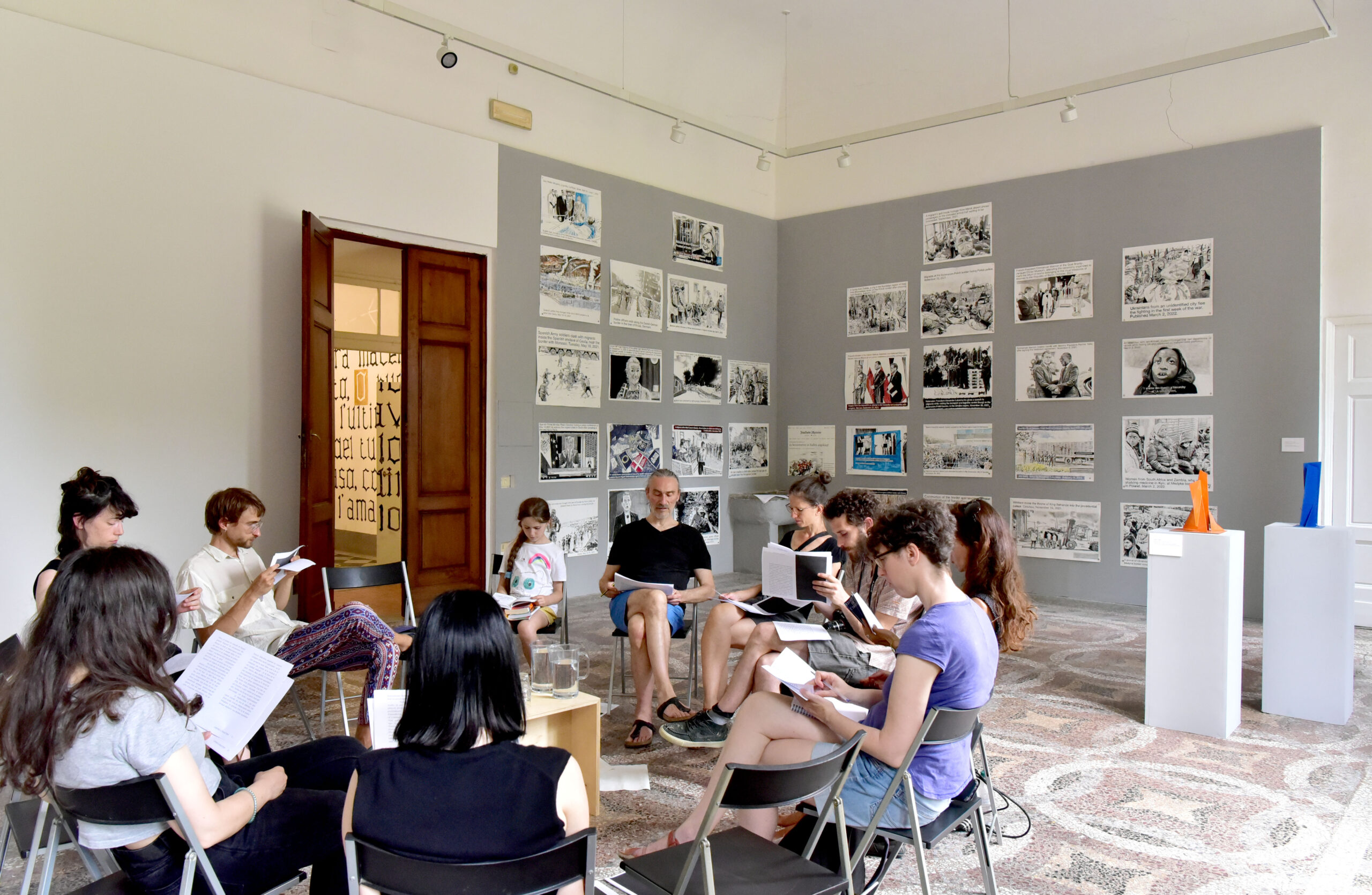
The Untranslatable three-day group is a collaborative and multidisciplinary project proposed by Bruno Baltzer, Leonora Bisagno, Cindy Coutant and Akim Pasquet together with other invited guests to explore the concept of untranslatable. Starting from a double image of translation-nomination, the group wishes to practice, through plural and heterogeneous approaches, the epistemic limits that are declared between a dominant translation, designating and circumscribing the world within parameters of legibility and that of the untranslatable as an act of resistance and transformation of the world, betraying the tyrant paradigm in a politics of differences and in an ecology of differences. The Untranslatable three-day group aims to be an open exercise spreading through different interventions, experimenting languages that are ultimately devoid of signifiers, acting vis-à-vis political invisibilisation, opening up to an emancipatory dimension as a necessary utopia for creating living communities.
PROGRAMME
TH 26.05
09:00
WORKSHOP – Intraducibile [The Untranslatable] – closed workshops day
FR 27.05
09:00
WORKSHOP – Intraducibile [The Untranslatable] – closed workshop morning
14:00
MANIFESTIAMO and Passaparola from Villa Romana to Piazza Tasso.
MANIFESTIAMO and Passaparola are two lively actions, which take place outside the Villa Romana at the encounter of people in the neighbourhood. Starting from the beautiful title given to the MANIFESTIAMO – on resistance, creation and reciprocity – three – month conference, the actions aim to open the institution spaces, to let circulate the words, to translate, reinvent, experiment languages in the public space.
17:30
LECTURES – Against translation and other lectures
Against Translation is a text by American poet Kenneth Goldsmith (born 1961) published in eight volumes–English, French, Spanish, German, Chinese, Japanese, Russian and Arabic. The author discusses the impasses and shortcomings of translation and the virtues of an unapologetic linguistic – displacement.
SA 28.05
09:00
WORKSHOP – Vulnerable text (on inscription – register till 27.05: office@vilaromana.org)
workshop and (a) fanzine production investigating the idea of vulnerability as the affect of a text.
14:00
WORKSHOP – A word-collective story workshop (on inscription – register till 27.05: office@vilaromana.org)
A workshop exploring and sharing the experience of transmission on identities, relationships, love, conflict. Single words and stories mix to share a collective experience of intimacy.
16:00
BOOK PRESENTATION – Ulésilar – MAC Lyon
Feedback on the Ulésilar experience – collective residence at Mac Lyon 2021
16:30
BOOK/PLATFORM PRESENTATION/WORKSHOP Ecologies of studies – Book of secrets
Studying doesn’t take place only in the educational institutions where the society tends to frame, acknowledge and reward it. Secrets students are everywhere, black study is hidden in plain sight. Such scattered and situated creations of knowledge cannot be translated in the linear and universal diagram of the intellectual progress. We heard about ancient compilations of recipes that, as early as medieval times, were written down, tweaked and passed on in notebooks from one person to another: the book of secrets. It could be a good vehicle to move around and encounter stories about alternative situations of studying, but also to carry these stories elsewhere and disseminate them. We will present, discuss and maybe activate together this editorial object, a work in progress that started within the online exhibition After progress.
21:30
CINE’- CLUB – Le plein pays (Antoine Boutet) + Floral Cocktail
Somewhere in the French countryside lives a man who leads an unusual life. He is called Jean-Marie Massou, he could be called in many other ways: artist, hermit, man of the woods, mad, Sisyphus, a Beckett character, mystic. Antoine Boutet doesn’t judge him, he just follows him with his camera while Jean Marie is stubbornly digging up enormous stones, recording prophetic messages on old tapes and singing in a weird language. Presentation, screening, discussion, maybe a surprise.
SU 29.05
09:00
WORKSHOP – Intraducibile [The Untranslatable] – closed workshop morning
14:00
PUBLIC LECTURE – Open public lectures, encounters, actions, gestures, performances, listening – 4 hours long.
Among them: The interpreter, an online – live exchange with Paca Rimbau Hernàndez, Lithotherapy sensibilisation, an experiment to feel different energetic qualities of minerals, close to a guided meditation, in small groups, Letture ad arte, a multilinguistic playful participative lecture on art – with the support of Casino Luxembourg – Forum d’art contemporain, écoutes, listening to some untranslatables and other surprises!
18:00
PUBLIC PRESENTATION – Untraslatable [The Untranslatable] + Floral Cocktail
Presentation of the four-day Untranslatable workshop, talk, discussion
Leonora Bisagno and Bruno Baltzer have been working as an artist duo since 2014. Visual artists, their practice is oriented towards site-specific actions. They live in Luxembourg and in Italy.
Akim Pasquet is interested in questions of affect and energy, their circulation in intimacies and in ensembles. He is sometimes a curator, sometimes an artist, sometimes a teacher. He directs the art space Limbes & the Biennale Carbone.
Cindy Coutant is a visual artist, editor and researcher. She co-founded the art & research duo l4bouche in 2020 with Estelle Benazet. She teaches at la HEAD – Genève.
Helen Ibry is a social anthropologist and a language teacher. She is a researcher, a trainer and an activist working in various contexts. She focuses on gender, sexuality, migration, and identity. She lives in Milano.
Anne-Sarah Huet is a poet and visual artist, as well as a teacher and researcher in economics. She is completing a practice based PhD in fine art at ESAA-Annecy, where she mainly writes about money (coins, token), art and identity.
Jacopo Rasmi, teacher and researcher at the Université Jean Monnet (Saint Etienne). He lives in France, but comes back as often as possible to his home country Italy.
Paca Rimbau Hernández is a translator and an interpreter. Spanish by origin, she lives in Luxembourg.
PARTNERS:
Kultur | lx – Arts Council Luxembourg
Les Limbes, espace d’art et de recherche. With the support of : DRAC Rhône Alpes, Auvergne Rhône Alpes region and the city of Saint Étienne
jusquici a.s.b.l. – Luxembourg
![]()
![]()
![]()
INSTALLATION
Veit Stratmann
Reading Place
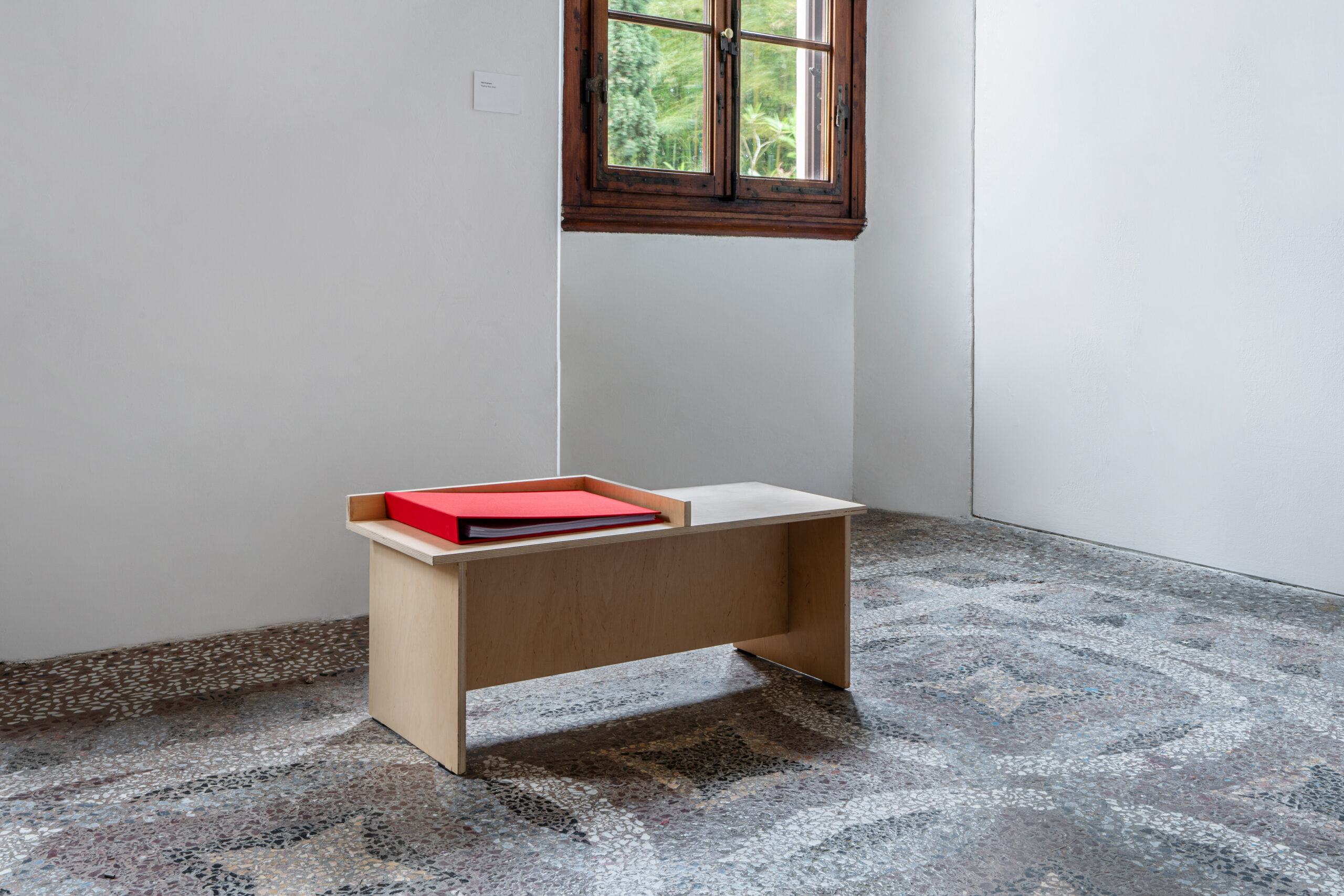
The „Reading Place“ is a setting that allows for the materialization and consultation of the corpus of the „Unrealizable Works“. This corpus previously existed only in the virtual space of the Internet. The Reading Place addresses itself to the individual.
The „Unrealizable Works“ refer to geographical spaces that have been detached from the social and political sphere by a superimposition of historical, economic, social, even geological conditions and have „fallen out of time“. These spaces have become non-places, beyond the reach of democracy and politics. Although they remain a physical part of the world, they are outside of the world and of time.
However, the places described are real and locatable – despite their “non-existence”, their “absence”. As each of them occupies a considerable geographical range, they affect the freedom of movement, of human activities and of thought in their immediate surroundings.
Furthermore, the nature of these non-places demands objective change: the formulation of solutions and, the „cessation of debate.“ Art, however, is a tool for opening debates and it does not have a mandate. Art cannot act „on behalf of“ a collective. Rather it treats the other as an individual. Moreover, the changes required for these non-spaces lie outside the realm of art.
Thus, any attempt by art to find solutions to problems outside its own realm is destined to fail because art would have to grant itself a mandate over which it cannot dispose and would arrogate itself a social function and a prerogative of interpretation that it does not possess. If art were to strive for objective solutions outside its own realm, it would lose its ethical validity. In the end, it would simply disappear.
In order to be able to act in this context and to fulfill my responsibility as an artist to myself and to society, I can only attempt to create form if I take the risk of stretching my thinking to a point of rupture. This point of rupture describes the point at which the inherent fragility or potential ineffectiveness of my position as an artist, in relation to the places the „Unrealizable Works“, becomes the main material of my project. And I accept that this process may be fraught with anxiety – because of the sheer scale of the places I am dealing with and precisely because they have fallen out of time and out of the world – since I am alive, thus anchored in time and situated in the world.
Reading Place, 2022, Courtesy of the artist, photo Ela Bialkowska OKNOstudio
imagesPERFORMANCE
Farkhondeh Shahroudi
ich denke an meiner knie, 2022

I went around everywhere, across the towns with burgerking, towns with burgherkilling, across the autobahn 1, across service areas with free urinating, 70 cents or a voucher worth just 50 cents, wash hands with warm water, soap dispensers that make big bubbles. across kid-friendly playgrounds, sandpits with no needles.
I rode in subway all lines with poemless newspaper sales: I am pleased with each spend.
I drag shoe soles on every pavement, hug my knee, if you can’t find anyone you can hug yourself.
I have everything in my cart, little dreams, big dreams, weaving, gardening dreaming, poems, kayal, dictionary.
I can sew your little dreams together so that they become big dreams.
oh, pole star shows me the route i should go, my dog wants to go everywhere.
I’m starving, is there a soup kitchen near here.
I can’t sell myself well.
I think on my knee without thinking on my every step.
I can cut your hair; I can treat roots and serve black tea with cardamom at the same time.
ice blocks melt 25 meters deep I had frozen my migraine attacks there.
I have a flower for migraine that doesn’t contain histamine, as you know.
I want to go to Mexico, but I don’t know how.
it is not picturesque to let a sun drown on the horizon.
carry plant soil from a to z very cheap, collect beer bottles, porcelain vases, butterflies, tasty chunkenwings from the five-star restaurant near tauben strasse berlin center, advise artists suffering from chicken eyes, who steal candy.
I think on my knee, have no roof over my head, but a sky so beautiful I could cry.
Farkhondeh Shahroudi
Farkhondeh Shahroudi, artist, born in Teheran, lives in Berlin, Villa Romana Fellow 2017.
Farkhondeh Shahroudi, ich denke an meiner knie (I think of my knees), 2022. Courtesy the artist
imagesPERFORMATIVE DINNER
Yorgos Sapountzis
Zucchini Dance on Fabric Stage
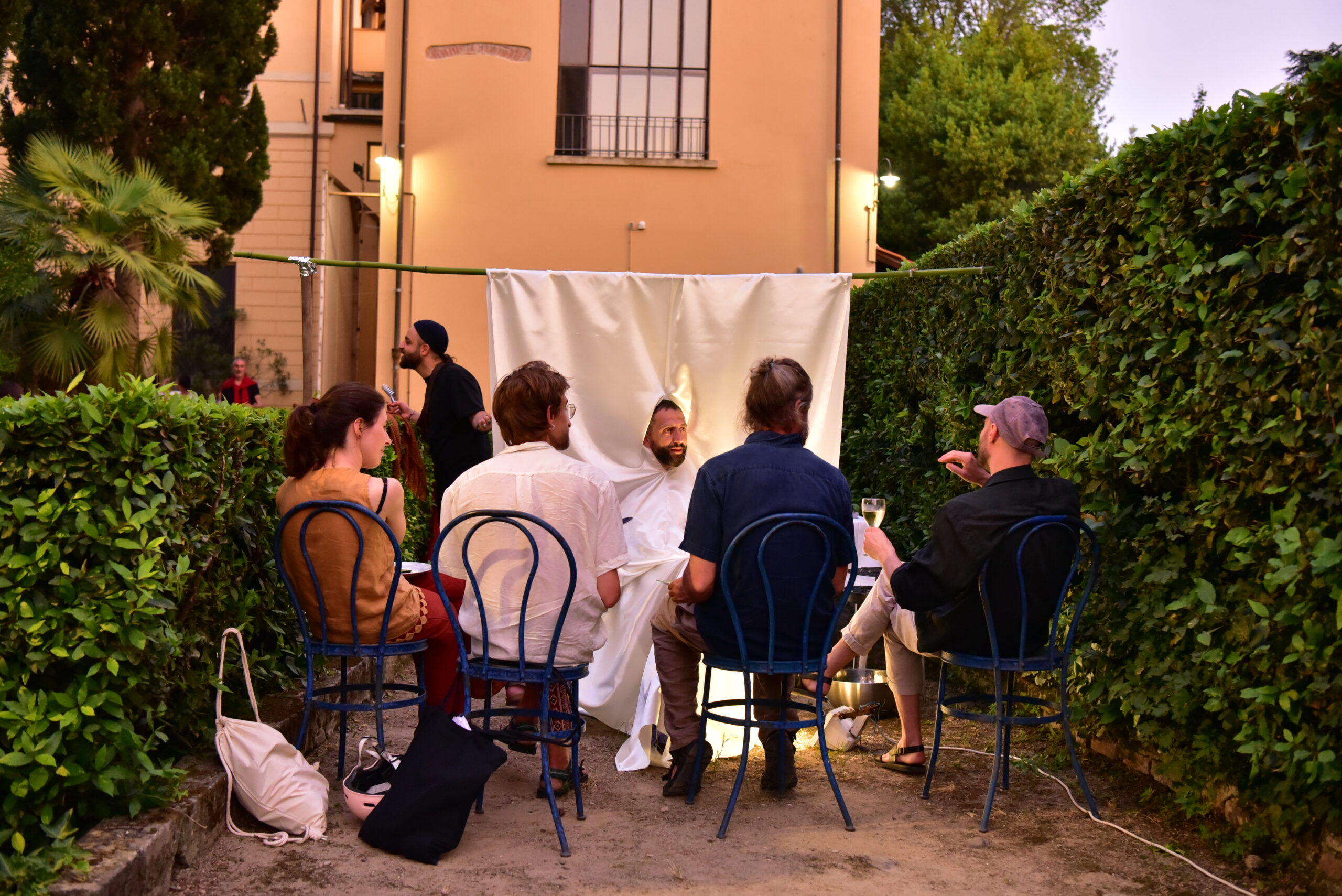
A performative dinner with grilled vegetables.
Yorgos Sapountzis, artist, born in Athens, lives in Berlin, Villa Romana Fellow 2012
VIDEO INSTALLATION
Nina Fischer & Maroan el Sani
Die Alchemie der Wolken – Art, Activism and Splitting Communites
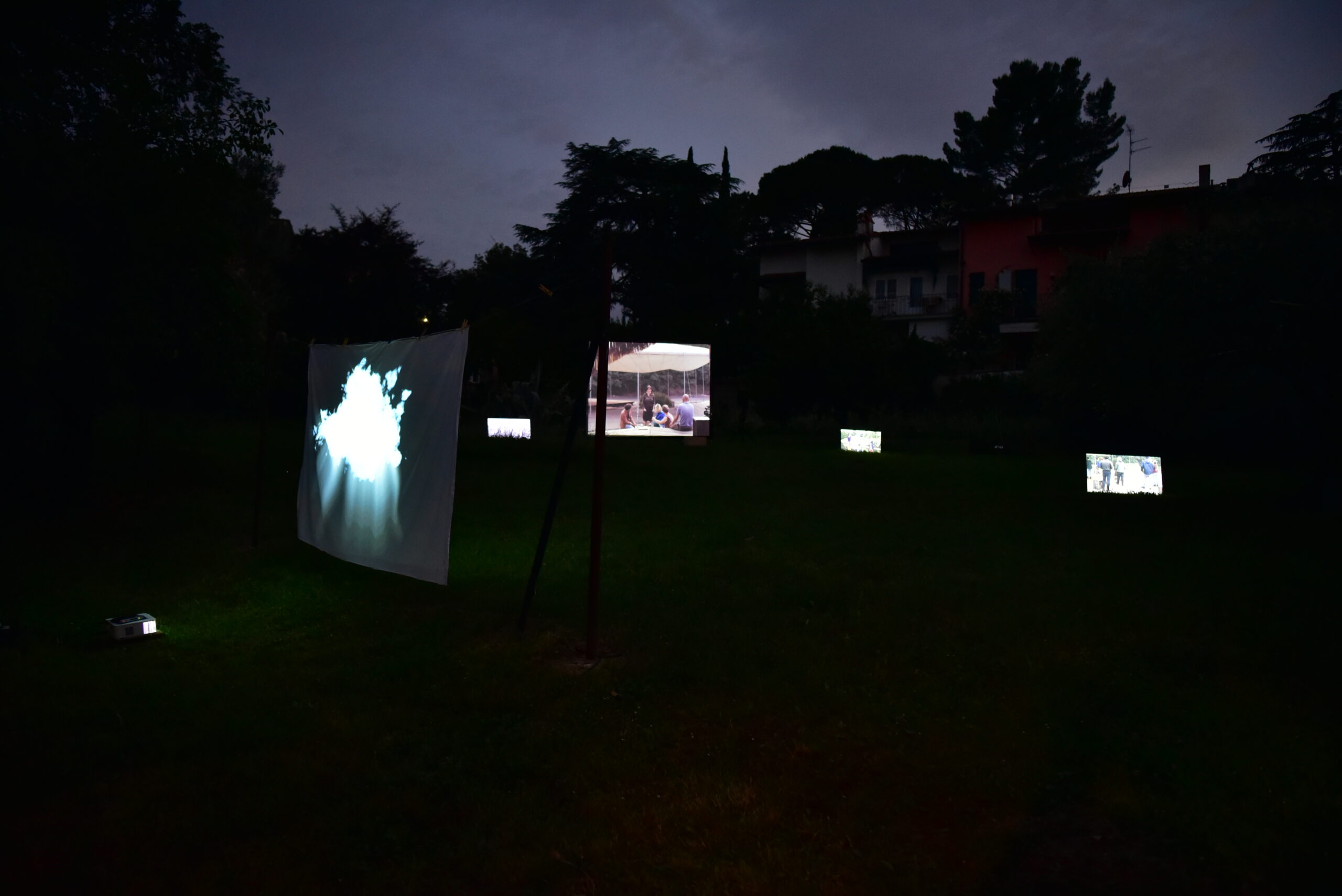
Fischer & el Sani’s artistic practice is inspired by situationist and interventionist methods. They use performative, process-oriented strategies and develop their art projects in dialogue with local communities. Their latest project Cloud Alchemy – Art, Activism and Splitting Communities is posing key questions in relation to climate change and its potential to split society.
Die Alchemie der Wolken – Art, Activism and Splitting Communites, 2021
6 channel video installation,
Colour, Sound, Duration variable,
Timber structure
Co-produced by LWL-Museum für Kunst und Kultur
Funded by Ministerium für Kultur und Wissenschaft des Landes NRW
Courtesy the artists
Nina Fischer & Maroan el Sani frequently develop their video projects in workshops and by employing performative scenes with actresses and actors. For the Cloud Alchemy project, the artists have staged a simulation game in the rainwater collection basin at Berlin’s abandoned Tempelhof Airport. Like the venue itself, the protagonists find themselves in a transitional situation. Referring to a text by Japanese author Toshiki Okada, a glowing cloud hovering over a village becomes the catalyst for an ominous social divide. This cloud forces people to decide whether they want to try radically new ways of living and types of housing and drastically curtail their consumption, or whether everything should remain as it is. The natural phenomenon is illustrative of a global problem, and represents differences and tensions. Fischer & el Sani pose key questions about the non-historical occurrence of division that paralyses and undermines societies around the world: Do we feel called to immediate action? Or do we want to limit our perception to one of a mere natural phenomenon and not draw any consequences?
Nina Fischer & Maroan el Sani, artists, film makers, living in Berlin, since 1995 they work as a duo.
imagesFOUR-DAYS WORKSHOP WITH PUBLIC INTERVENTIONS
L’INTRADUCIBILE [The Untranslatable]
With Leonora Bisagno, Bruno Baltzer, Cindy Coutant, Akim Pasquet, Anne-Sarah Huet, Helen Ibry, Jacopo Rasmi, Paca Rimbau Hernàndez
[On inscription – register till 27.05: office@vilaromana.org]
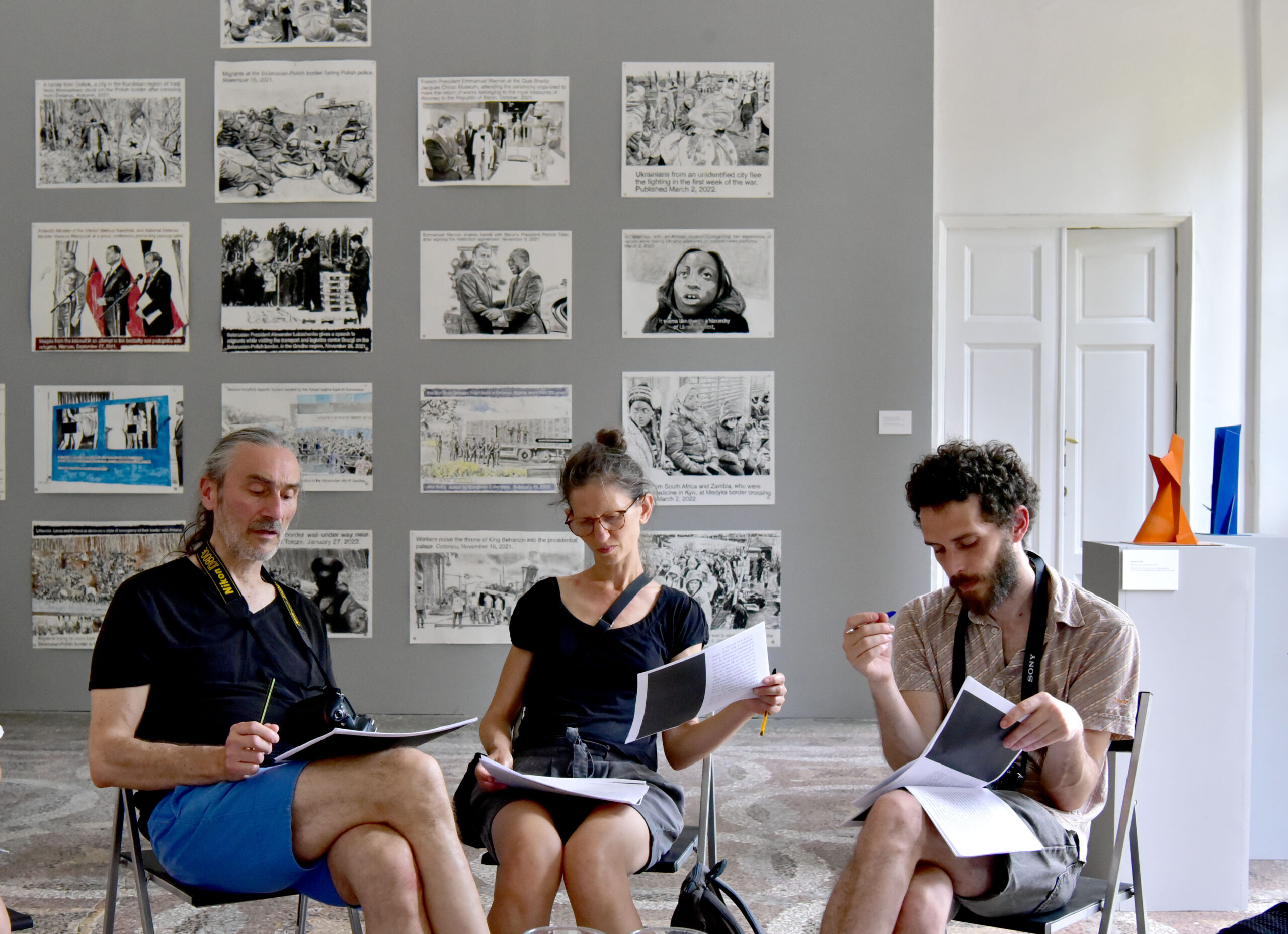
The Untranslatable three-day group is a collaborative and multidisciplinary project proposed by Bruno Baltzer, Leonora Bisagno, Cindy Coutant and Akim Pasquet together with other invited guests to explore the concept of untranslatable. Starting from a double image of translation-nomination, the group wishes to practice, through plural and heterogeneous approaches, the epistemic limits that are declared between a dominant translation, designating and circumscribing the world within parameters of legibility and that of the untranslatable as an act of resistance and transformation of the world, betraying the tyrant paradigm in a politics of differences and in an ecology of differences. The Untranslatable three-day group aims to be an open exercise spreading through different interventions, experimenting languages that are ultimately devoid of signifiers, acting vis-à-vis political invisibilisation, opening up to an emancipatory dimension as a necessary utopia for creating living communities.
PROGRAMME
TH 26.05
09:00
WORKSHOP – Intraducibile [The Untranslatable] – closed workshops day
FR 27.05
09:00
WORKSHOP – Intraducibile [The Untranslatable] – closed workshop morning
14:00
MANIFESTIAMO and Passaparola from Villa Romana to Piazza Tasso.
MANIFESTIAMO and Passaparola are two lively actions, which take place outside the Villa Romana at the encounter of people in the neighbourhood. Starting from the beautiful title given to the MANIFESTIAMO – on resistance, creation and reciprocity – three – month conference, the actions aim to open the institution spaces, to let circulate the words, to translate, reinvent, experiment languages in the public space.
17:30
LECTURES – Against translation and other lectures
Against Translation is a text by American poet Kenneth Goldsmith (born 1961) published in eight volumes–English, French, Spanish, German, Chinese, Japanese, Russian and Arabic. The author discusses the impasses and shortcomings of translation and the virtues of an unapologetic linguistic – displacement.
SA 28.05
09:00
WORKSHOP – Vulnerable text (on inscription – register till 27.05: office@vilaromana.org)
workshop and (a) fanzine production investigating the idea of vulnerability as the affect of a text.
14:00
WORKSHOP – A word-collective story workshop (on inscription – register till 27.05: office@vilaromana.org)
A workshop exploring and sharing the experience of transmission on identities, relationships, love, conflict. Single words and stories mix to share a collective experience of intimacy.
16:00
BOOK PRESENTATION – Ulésilar – MAC Lyon
Feedback on the Ulésilar experience – collective residence at Mac Lyon 2021
16:30
BOOK/PLATFORM PRESENTATION/WORKSHOP Ecologies of studies – Book of secrets
Studying doesn’t take place only in the educational institutions where the society tends to frame, acknowledge and reward it. Secrets students are everywhere, black study is hidden in plain sight. Such scattered and situated creations of knowledge cannot be translated in the linear and universal diagram of the intellectual progress. We heard about ancient compilations of recipes that, as early as medieval times, were written down, tweaked and passed on in notebooks from one person to another: the book of secrets. It could be a good vehicle to move around and encounter stories about alternative situations of studying, but also to carry these stories elsewhere and disseminate them. We will present, discuss and maybe activate together this editorial object, a work in progress that started within the online exhibition After progress.
21:30
CINE’- CLUB – Le plein pays (Antoine Boutet) + Floral Cocktail
Somewhere in the French countryside lives a man who leads an unusual life. He is called Jean-Marie Massou, he could be called in many other ways: artist, hermit, man of the woods, mad, Sisyphus, a Beckett character, mystic. Antoine Boutet doesn’t judge him, he just follows him with his camera while Jean Marie is stubbornly digging up enormous stones, recording prophetic messages on old tapes and singing in a weird language. Presentation, screening, discussion, maybe a surprise.
SU 29.05
09:00
WORKSHOP – Intraducibile [The Untranslatable] – closed workshop morning
14:00
PUBLIC LECTURE – Open public lectures, encounters, actions, gestures, performances, listening – 4 hours long.
Among them: The interpreter, an online – live exchange with Paca Rimbau Hernàndez, Lithotherapy sensibilisation, an experiment to feel different energetic qualities of minerals, close to a guided meditation, in small groups, Letture ad arte, a multilinguistic playful participative lecture on art – with the support of Casino Luxembourg – Forum d’art contemporain, écoutes, listening to some untranslatables and other surprises!
18:00
PUBLIC PRESENTATION – Untraslatable [The Untranslatable] + Floral Cocktail
Presentation of the four-day Untranslatable workshop, talk, discussion
Leonora Bisagno and Bruno Baltzer have been working as an artist duo since 2014. Visual artists, their practice is oriented towards site-specific actions. They live in Luxembourg and in Italy.
Akim Pasquet is interested in questions of affect and energy, their circulation in intimacies and in ensembles. He is sometimes a curator, sometimes an artist, sometimes a teacher. He directs the art space Limbes & the Biennale Carbone.
Cindy Coutant is a visual artist, editor and researcher. She co-founded the art & research duo l4bouche in 2020 with Estelle Benazet. She teaches at la HEAD – Genève.
Helen Ibry is a social anthropologist and a language teacher. She is a researcher, a trainer and an activist working in various contexts. She focuses on gender, sexuality, migration, and identity. She lives in Milano.
Anne-Sarah Huet is a poet and visual artist, as well as a teacher and researcher in economics. She is completing a practice based PhD in fine art at ESAA-Annecy, where she mainly writes about money (coins, token), art and identity.
Jacopo Rasmi, teacher and researcher at the Université Jean Monnet (Saint Etienne). He lives in France, but comes back as often as possible to his home country Italy.
Paca Rimbau Hernández is a translator and an interpreter. Spanish by origin, she lives in Luxembourg.
PARTNERS:
Kultur | lx – Arts Council Luxembourg
Les Limbes, espace d’art et de recherche. With the support of : DRAC Rhône Alpes, Auvergne Rhône Alpes region and the city of Saint Étienne
jusquici a.s.b.l. – Luxembourg
![]()
![]()
![]()
PRESENTATION / TALK / READING
Juan Pablo Macías
International Society of Proudhonian Studies (I.S.P.S.)
With Edouard Jourdain, Massimo Mazzone, Franco Bunčuga
THE EVENT WILL BE STREAMED LIVE ON THE FACEBOOK PAGE OF VILLA ROMANA.
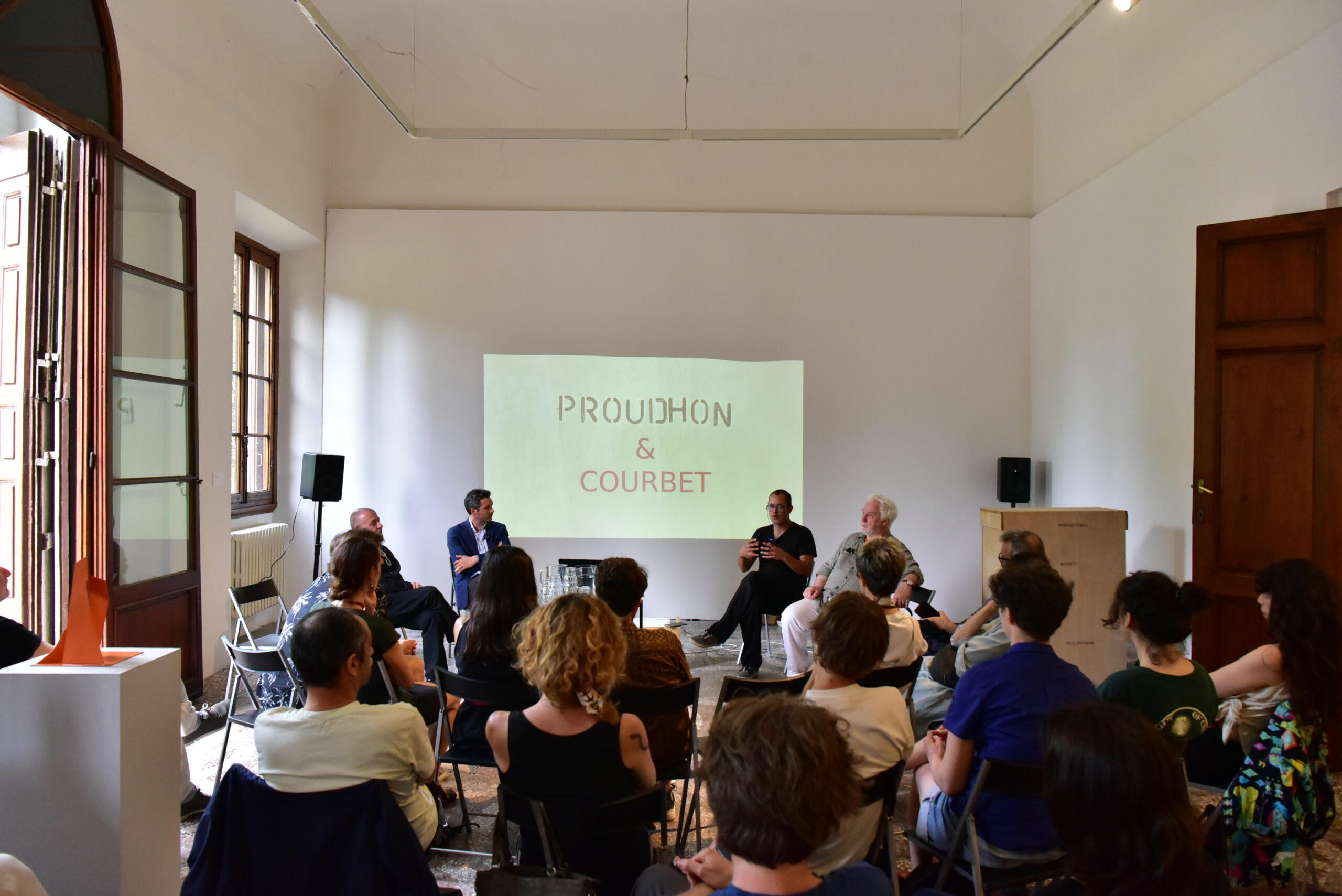
At the beginning of this summer, in the context of Manifestiamo at Villa Romana Florence, the International Society of Proudhonian Studies (I.S.P.S.) is to be founded more than 100 years after the burial of left’s diversity by Marxist totalitarianism.
I.S.P.S.’s objective is to revisit Pierre-Joseph Proudhon’s legacy through the creation of a floating institute that will carry out various activities such as reading-groups, encounters, research, publications, creation of floating libraries, to trigger a reflection on the concepts of creation, reciprocity, mutualism, liberty, and justice.
Proudhon foresaw an organization of society’s collective force through a decentralized federative system warranted by justice and reciprocity. He developed his theories by reflecting on the meaning of creation and society, envisaging society as the common administration of the products of creation. It follows that his thought is capital for our conceptions of art, and creative processes, but at the same time, it is important to start seeing human activities as a whole as part of creation itself.
Over these days the I.S.P.S. will be launched through a conversation with Franco Bunčuga, Edouard Jourdain and Massimo Mazzone, and the presentation of I.S.P.S.’s ongoing library.
Juan Pablo Macías, Mexican artist, living in Livorno.
Franco Bunčuga (Brescia, 1949), dopo essersi laureato in architettura nel 1974 all’IUAV di Venezia ha lavorato all’École Polytechnique d’Architecture et d’Urbanisme (EPAU) di Algeri in un progetto di cooperazione coordinato da Carlo Doglio e Giancarlo De Carlo. Ha poi insegnato Storia dell’Arte e Architettura nelle Scuole Superiori italiane. Attivo nel movimento anarchico sin dagli anni settanta è stato animatore del Centro Sociale Libertario di via Margheriti e del Gabinetto di Lettura Oskar Panizza a Brescia e partecipato alle attività del Centro Studi Libertari Pinelli di Milano. Collaboratore di varie testate anarchiche tra cui A rivista anarchica è stato redattore di Volontà, direttore del Seme Anarchico e tra i fondatori di Libertaria e di ApARTe° di cui è stato temporaneamente coordinatore redazionale. Riveste il ruolo di consulente per i settori di arte e architettura presso l’editore Eleuthèra per cui ha curato il libro Conversazioni con Giancarlo De Carlo. Architettura e libertà (Milano 2000, 2001) e Come vivere con gli altri senza essere né servi né padroni di Yona Friedman (Milano 2017). Si occupa principalmente delle relazioni che intercorrono tra arte e architettura da una parte e pensiero libertario e utopico dall’altra.
Massimo Mazzone (1967) artist and activist spokesperson for the Escuela Moderna/Ateneo Libertario collective; carries out research into the relationships between body, sculpture and architecture. He teaches Sculpture Techniques at the Brera Academy of Fine Arts; he participated in the Venice Biennale in 2000, 2001, 2002, 2006, 2008, 2016, 2017, 2018 and published books and articles with Stampa Alternativa, Mimesis, Libertaria, ApARTe, Artslife, Artribune, Hipo-Tesis, Catedra, Metalocus, UTET, Bordeaux, Milieu, Prospettive, Argòs.
Edouard Jourdain (1981) is a french political theorist, teaching political sciences at the University of Versailles Saint Quentin. Among several books he has written three books about Proudhon (Proudhon Dieu et la guerre, L’Harmattan, 2006, Proudhon un socialisme libertaire, Michalon, 2009, Proudhon contemporain, CNRS Editions, 2018) and his works are related to the actuality of contemporary political anarchism.
imagesFOUR-DAYS WORKSHOP WITH PUBLIC INTERVENTIONS
L’INTRADUCIBILE [The Untranslatable]
With Leonora Bisagno, Bruno Baltzer, Cindy Coutant, Akim Pasquet, Anne-Sarah Huet, Helen Ibry, Jacopo Rasmi, Paca Rimbau Hernàndez
[Closed workshop morning]
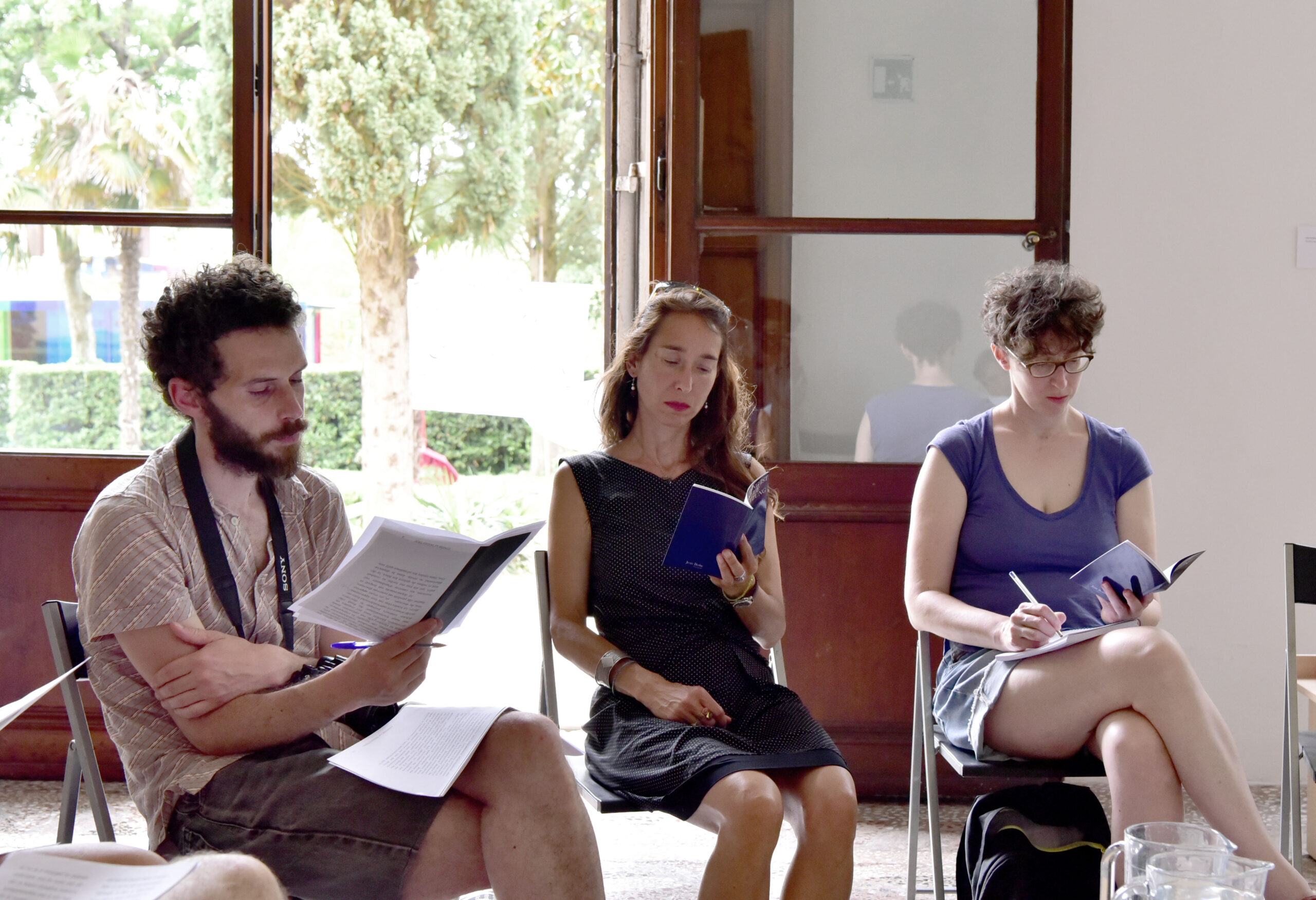
The Untranslatable three-day group is a collaborative and multidisciplinary project proposed by Bruno Baltzer, Leonora Bisagno, Cindy Coutant and Akim Pasquet together with other invited guests to explore the concept of untranslatable. Starting from a double image of translation-nomination, the group wishes to practice, through plural and heterogeneous approaches, the epistemic limits that are declared between a dominant translation, designating and circumscribing the world within parameters of legibility and that of the untranslatable as an act of resistance and transformation of the world, betraying the tyrant paradigm in a politics of differences and in an ecology of differences. The Untranslatable three-day group aims to be an open exercise spreading through different interventions, experimenting languages that are ultimately devoid of signifiers, acting vis-à-vis political invisibilisation, opening up to an emancipatory dimension as a necessary utopia for creating living communities.
PROGRAMME
TH 26.05
09:00
WORKSHOP – Intraducibile [The Untranslatable] – closed workshops day
FR 27.05
09:00
WORKSHOP – Intraducibile [The Untranslatable] – closed workshop morning
14:00
MANIFESTIAMO and Passaparola from Villa Romana to Piazza Tasso.
MANIFESTIAMO and Passaparola are two lively actions, which take place outside the Villa Romana at the encounter of people in the neighbourhood. Starting from the beautiful title given to the MANIFESTIAMO – on resistance, creation and reciprocity – three – month conference, the actions aim to open the institution spaces, to let circulate the words, to translate, reinvent, experiment languages in the public space.
17:30
LECTURES – Against translation and other lectures
Against Translation is a text by American poet Kenneth Goldsmith (born 1961) published in eight volumes–English, French, Spanish, German, Chinese, Japanese, Russian and Arabic. The author discusses the impasses and shortcomings of translation and the virtues of an unapologetic linguistic – displacement.
SA 28.05
09:00
WORKSHOP – Vulnerable text (on inscription – register till 27.05: office@vilaromana.org)
workshop and (a) fanzine production investigating the idea of vulnerability as the affect of a text.
14:00
WORKSHOP – A word-collective story workshop (on inscription – register till 27.05: office@vilaromana.org)
A workshop exploring and sharing the experience of transmission on identities, relationships, love, conflict. Single words and stories mix to share a collective experience of intimacy.
16:00
BOOK PRESENTATION – Ulésilar – MAC Lyon
Feedback on the Ulésilar experience – collective residence at Mac Lyon 2021
16:30
BOOK/PLATFORM PRESENTATION/WORKSHOP Ecologies of studies – Book of secrets
Studying doesn’t take place only in the educational institutions where the society tends to frame, acknowledge and reward it. Secrets students are everywhere, black study is hidden in plain sight. Such scattered and situated creations of knowledge cannot be translated in the linear and universal diagram of the intellectual progress. We heard about ancient compilations of recipes that, as early as medieval times, were written down, tweaked and passed on in notebooks from one person to another: the book of secrets. It could be a good vehicle to move around and encounter stories about alternative situations of studying, but also to carry these stories elsewhere and disseminate them. We will present, discuss and maybe activate together this editorial object, a work in progress that started within the online exhibition After progress.
21:30
CINE’- CLUB – Le plein pays (Antoine Boutet) + Floral Cocktail
Somewhere in the French countryside lives a man who leads an unusual life. He is called Jean-Marie Massou, he could be called in many other ways: artist, hermit, man of the woods, mad, Sisyphus, a Beckett character, mystic. Antoine Boutet doesn’t judge him, he just follows him with his camera while Jean Marie is stubbornly digging up enormous stones, recording prophetic messages on old tapes and singing in a weird language. Presentation, screening, discussion, maybe a surprise.
SU 29.05
09:00
WORKSHOP – Intraducibile [The Untranslatable] – closed workshop morning
14:00
PUBLIC LECTURE – Open public lectures, encounters, actions, gestures, performances, listening – 4 hours long.
Among them: The interpreter, an online – live exchange with Paca Rimbau Hernàndez, Lithotherapy sensibilisation, an experiment to feel different energetic qualities of minerals, close to a guided meditation, in small groups, Letture ad arte, a multilinguistic playful participative lecture on art – with the support of Casino Luxembourg – Forum d’art contemporain, écoutes, listening to some untranslatables and other surprises!
18:00
PUBLIC PRESENTATION – Untraslatable [The Untranslatable] + Floral Cocktail
Presentation of the four-day Untranslatable workshop, talk, discussion
Leonora Bisagno and Bruno Baltzer have been working as an artist duo since 2014. Visual artists, their practice is oriented towards site-specific actions. They live in Luxembourg and in Italy.
Akim Pasquet is interested in questions of affect and energy, their circulation in intimacies and in ensembles. He is sometimes a curator, sometimes an artist, sometimes a teacher. He directs the art space Limbes & the Biennale Carbone.
Cindy Coutant is a visual artist, editor and researcher. She co-founded the art & research duo l4bouche in 2020 with Estelle Benazet. She teaches at la HEAD – Genève.
Helen Ibry is a social anthropologist and a language teacher. She is a researcher, a trainer and an activist working in various contexts. She focuses on gender, sexuality, migration, and identity. She lives in Milano.
Anne-Sarah Huet is a poet and visual artist, as well as a teacher and researcher in economics. She is completing a practice based PhD in fine art at ESAA-Annecy, where she mainly writes about money (coins, token), art and identity.
Jacopo Rasmi, teacher and researcher at the Université Jean Monnet (Saint Etienne). He lives in France, but comes back as often as possible to his home country Italy.
Paca Rimbau Hernández is a translator and an interpreter. Spanish by origin, she lives in Luxembourg.
PARTNERS:
Kultur | lx – Arts Council Luxembourg
Les Limbes, espace d’art et de recherche. With the support of : DRAC Rhône Alpes, Auvergne Rhône Alpes region and the city of Saint Étienne
jusquici a.s.b.l. – Luxembourg
![]()
![]()
![]()
IN FLAMES – ACTING BODIES/SPEAKING SITES
TALK / ARTIST BOOK / SCREENING
Giacomo Zaganelli
The Artist for the Community. Acting as an Institution
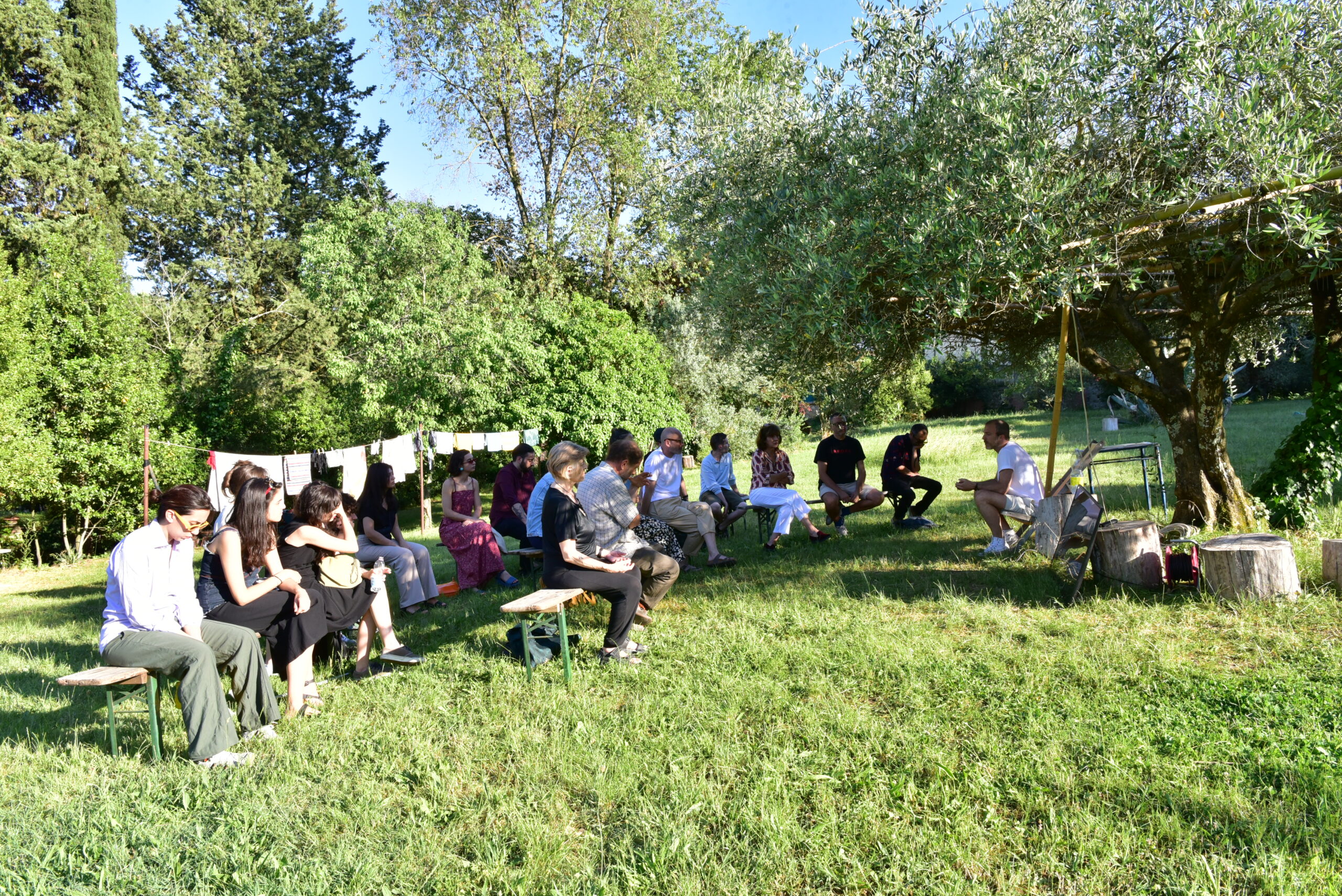
To investigate the potential offered today by the figure of the artist working for the community. A reflection on the opportunities represented by artists in terms of participation, involvement, vision and alternative to the dominant model and on how, today more than ever, collaborations with territories, companies and institutions are fundamental to define new paradigms of exchange and sharing between art and society. „The focus will be on the project that Zaganelli created for the Thailand Biennale Korat 2021: the Somsed Temporary Cultural Center“.
„Project supported by the Directorate-General for Contemporary Creativity by the Italian Ministry of Culture under the Italian Council program“
Giacomo Zaganelli (1983, Florence, Italy) lives and works between Florence and Berlin. Zaganelli is an author interested in the potential of things, inspired by looking at the world in terms of the possibilities that it offers rather than the limits that it imposes. As artist, curator and cultural organizer he works interdisciplinarily towards an idea of collectivity and community. Through his practice he investigates the social and public dimension of the concept of space, developing projects and actions based on the contexts. His production varies from monumental public operations to digital research, museum exhibitions, the production of series of books, curatorial projects and the organization of workshops and conferences. Among his recent projects the solo shows Grand Tourismo at the Uffizi Galleries in Florence (2018/2019) and Superficially at MOCA Taipei (2018); the Setouchi Triennale 2019 in Japan and the Thailand Biennale 2021 in Korat. In 2020 and 2021, he was awarded grants respectively in the IX and X edition of the Italian Council.
BOOK PRESENTATION / FILMS
In Fiamme. La performance nello spazio delle lotte (1967-1979)
With Annalisa Sacchi, Marion D’amburgo, Kinkaleri, Mario Lupano
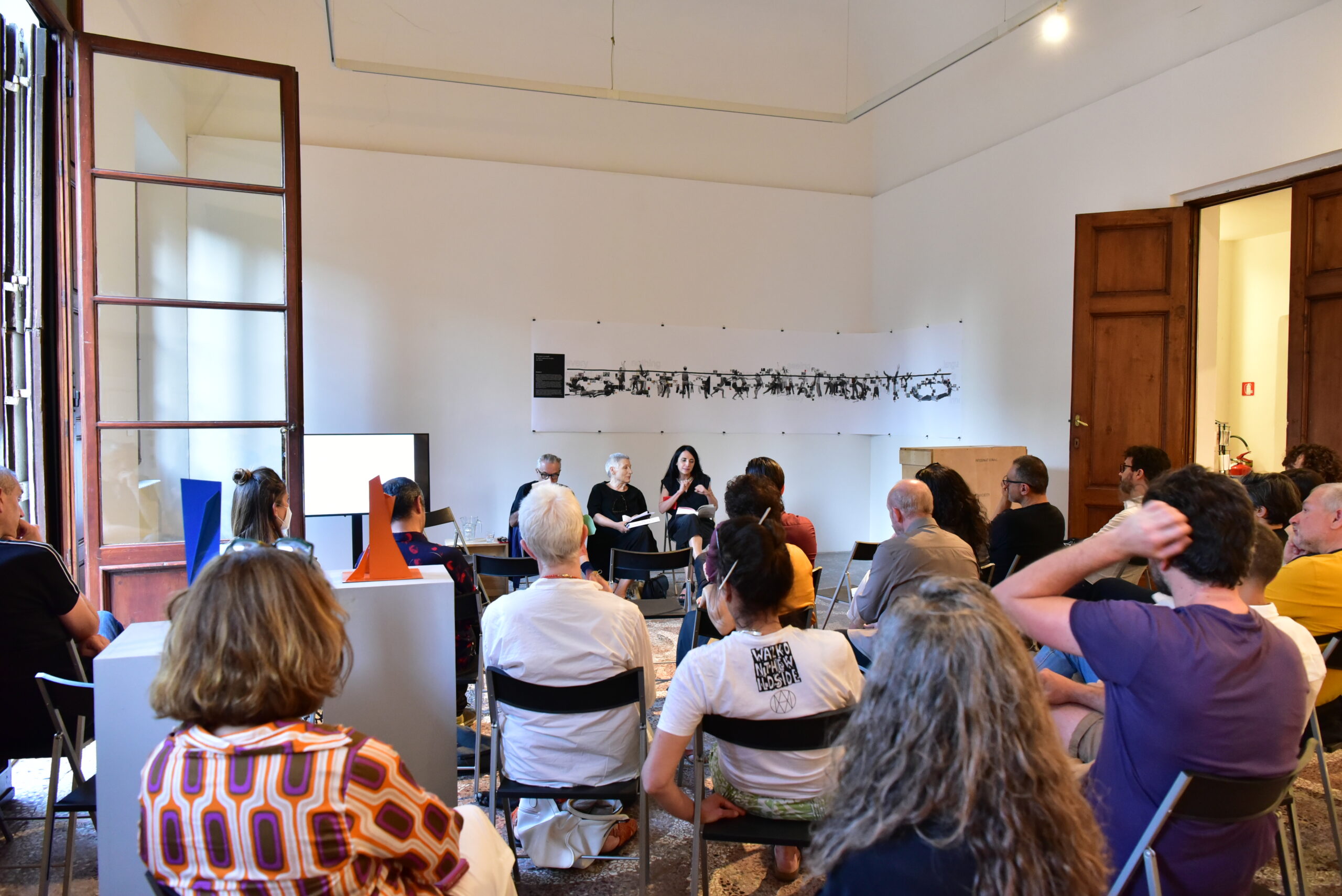
The book In Fiamme. La performance nello spazio delle lotte (1967-1979) edited by Annalisa Sacchi, Ilenia Caleo and Piersandra Di Matteo, interrogates the scene of the long 1968 in Italy at the crossroads between artistic experimentation and political struggle, in search of questions that still trouble the present: community, relational and affective ecosystems, processes of subjectification, relations between creation and production. The so-called Italian laboratory – radical, inventive and not lacking in contradictions – took shape through eccentric paths between the 1960s and 1970s, in that performance that was beginning to deflagrate in the space of the struggles – a legacy collected more by the international debate than by Italian theatre historiography. In Fiamme attempts to restore the complex dimension of performance as a field of production of the shared. In particular, this meeting will open a focus on the geography of Florence, a city of production and passage of inventions, imaginaries, writings and images.
Videos and documentation materials will be presented all through the day.
Leo de Berardinis and Perla Peragallo, To Charlie Parker, film, 1970
‘A desire for a downpour, for washing, even as a physical sensation of the smell and sound of rain, detached both from an objectivity and from a subjectivity in tension with the outside world, and from a subjectivity that is, if possible, autonomous’. The film presents Leo and Perla’s negative theatre, a communicative and systemic gap, an error that preludes Marigliano’s escape, his self-exile.
Kinkaleri, A world does not die if you can think of another one, print on paper, 2021
Print of the visual action produced for the publication In fiamme. La performance nello spazio delle lotte (1967-1979).
Kinkaleri, Umanesimo, Disumanesimo, Tourmanesimo, video, 2017
Documentation of the performance realized in collaboration with Villa Romana for the exhibition Humanism Inhumanism 1980/2017 Lara-Vinca Masini and the Sense of Crisis in European Art
Curated by Incommon and Kinkaleri
FILM INSTALLATION
Giovanni Cioni
Appunti per un’Iliade (Isola dell’Asinara, febbraio 2022)

A film installation based on surveys on the island of Asinara, a penal colony until 1998.
Like the scene of a war without end, a Trojan war, only traces remain. Traces of deported lives, of lives not lived, of life in death, destined to die far away. Mario Trudu, a lifelong shepherd. Hector and the heroes of the Trojan War. The Austro-Hungarian soldiers of 1914, deported after a long march through the Balkans, suffering from typhus. Princess Selassie, daughter of the Emperor of Ethiopia, deported in 1936 by Mussolini with her youngest children and dignitaries. Traces remain, stones, clouds, goats, donkeys and horses, witnesses and survivors of these epics. The installation is an expanded montage, in space, between projected fragments – the montage aims to open up gaps between the images, and to go through these gaps to try to see something beyond the shadows of Plato’s cave.
Giovanni Cioni, “cineasta dell’invisibile”, ha vissuto tra Bruxelles, Parigi, Lisbona, Napoli. Vive ora nel Mugello, in Toscana. Tra i suoi film selezionati e premiati in vari festival internazionali: DAL PIANETA DEGLI UMANI (in anteprima al Festival di Locarno 2021, vincitore al Festival dei Popoli e al Premio Corso Salani al Festival di Trieste, nella selezione ai David di Donatello), NON è SOGNO, VIAGGIO A MONTEVIDEO, DAL RITORNO, PER ULISSE, GLI INTREPIDI, IN PURGATORIO.
SELF PLEASURE – SELF EXHAUSTING – SELF GOVERNANCE
THREE-DAYS WORKSHOP
CampoBase
Exhausting until blossoming
[Closed workshop]
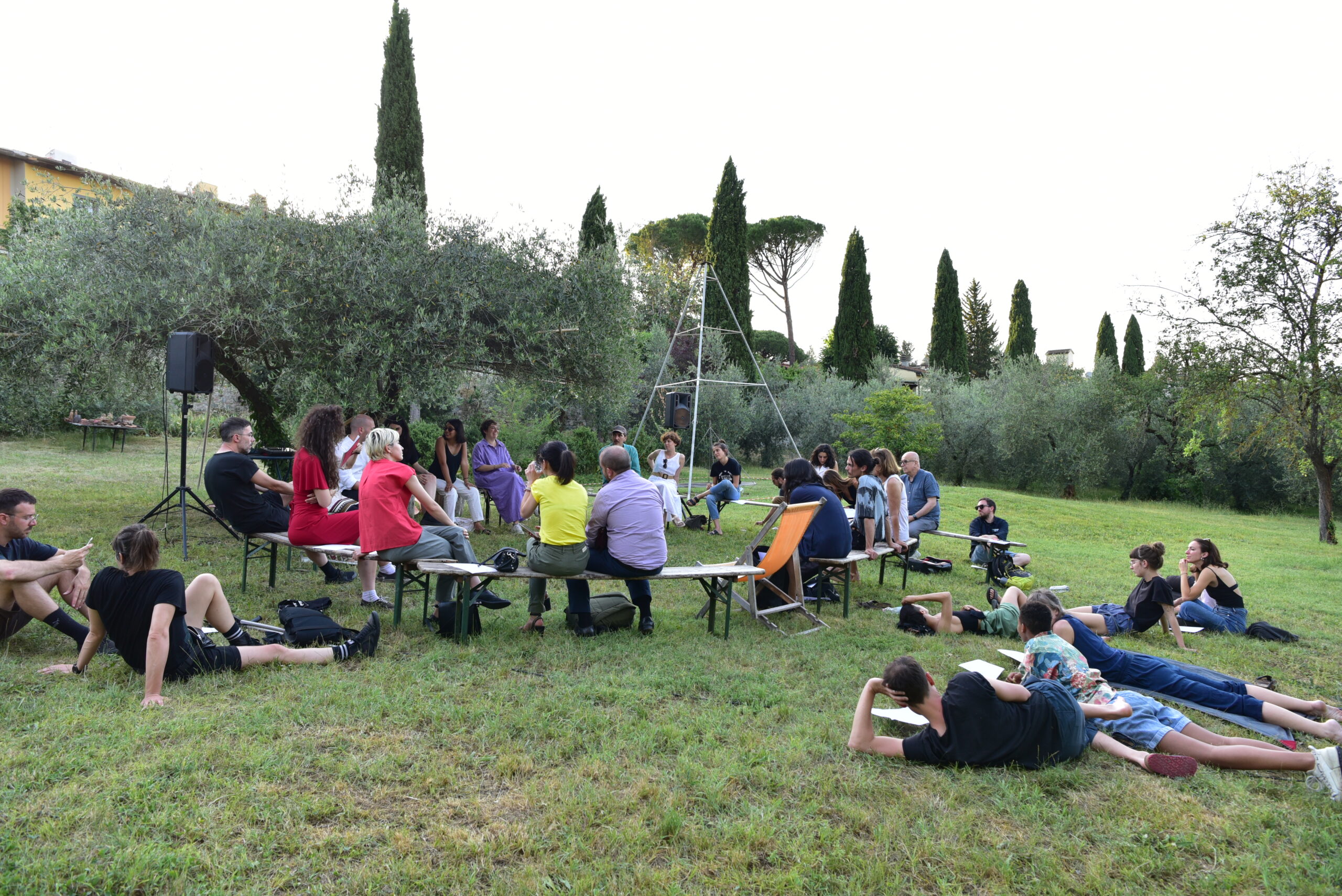
The different aspects of daily life are nowadays crossed by a certain kind of fatigue, an affective tonality in which we are immersed while we continue to move. From the work environment to the experience of public life, we are constantly driven by the logic of hyper-productivity and hyper-mobility. For MANIFESTIAMO at Villa Romana, CampoBase proposes a three-day workshop dedicated to the theme of exhaustion. In a moment in which people, resources and energy are being fully drained, how can we see the issue of exhaustion as an opportunity for action and not just as a limiting factor? Starting from these questions, CampoBase temporarily extends the collective and incorporates members from different disciplinary fields with the aim of triggering a collective reflection on the meaning and value of the term exhaustion. The research workshop sessions will lead to a third moment of shared discussion, open to the public. The contribution produced will be an attempt to imagine new ways through which exhaustion can become a creative technique that challenges or alters the redundant rhetoric that ‘there is no alternative’.
CampoBase is a multidisciplinary curatorial collective composed of researchers, philosophers, curators, mediators, art historians and writers that operates as an itinerant platform. CampoBase adopts discursive practices and experimental approaches in the realization of artistic events and projects, aiming to activate collective processes of knowledge through the creation of open environments that favour public occasions for meeting and dialogue. Its research is focused on several topics, including the condition of displacement, the transformative power of affection, the mechanisms of formation of temporary communities in the contemporary cultural context, exhaustion as a psychic, political and social condition of contemporaneity. The member of CampoBase are Irene Angenica, Bianca Buccioli, Gabriella Dal Lago, Ginevra Ludovici, Federica Torgano, Stefano Volpato. The collective has a fluid and inclusive nature: it expands and contracts, welcoming new members who become part of it for specific projects in a process of permanent self-constitution.
INTERVENTION / DISCUSSION / READING
Anike Joyce Sadiq
Strings Attached: the Structures of and Behind Art Institutions
with Simone Frangi, Justin Randolph Thompson, Lucrezia Cipitelli, Alessandra Ferrini and Andrea Scrima
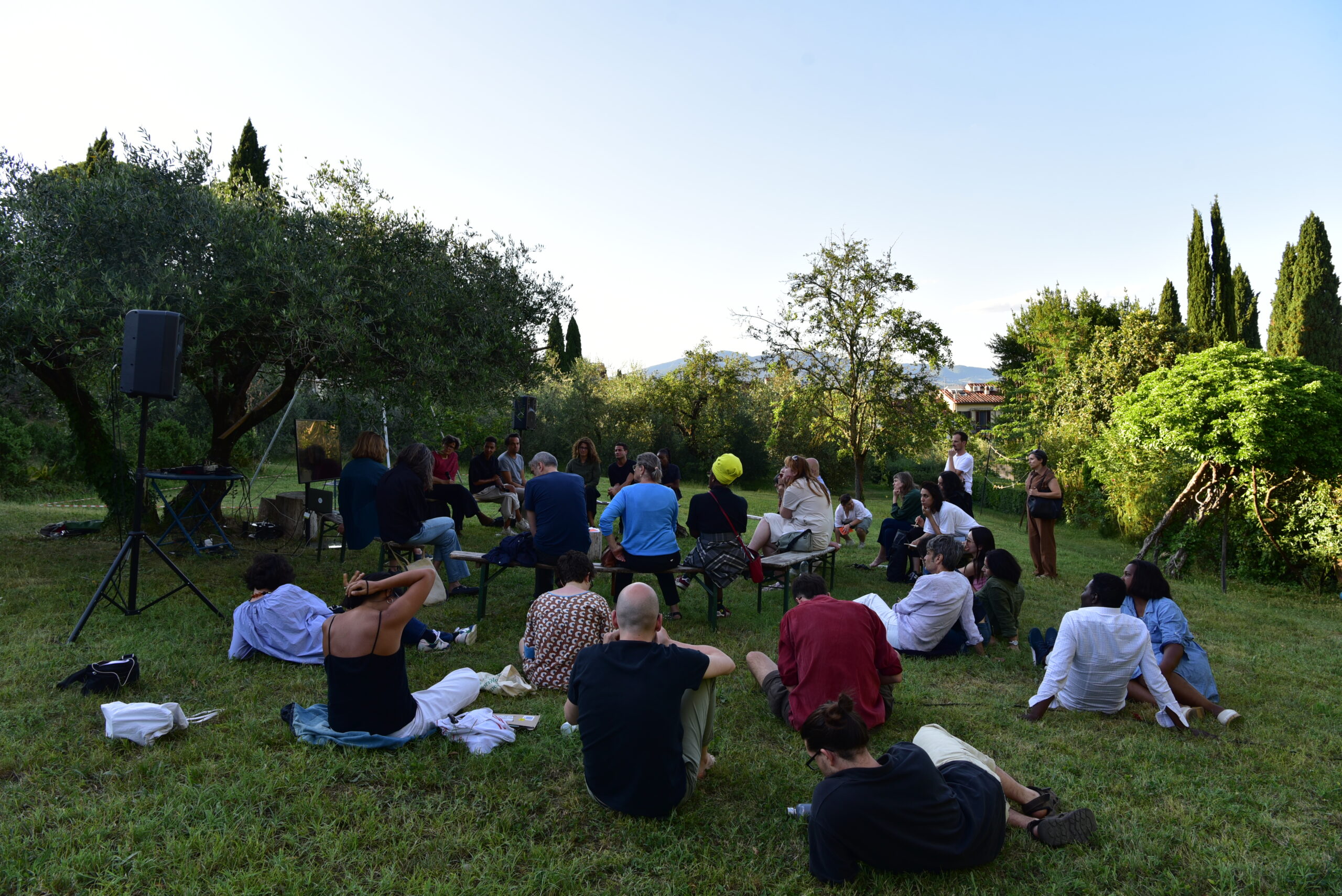
Looking at the actual economics and politics behind art institutions and their implications for the structures of these institutions, the following questions arise: how does art serve to a mask the so-called democratic state and private interests of the funding bodies? And how can artists work and acknowledge the gap between the exhibition of these values (i.e., ‘freedom of speech,’ ‘self-critical,’ ‘inclusive,’ ‘antiracist,’ etc.) and the often very contradictory politics and structures of and behind these very institutions?
The event will take place in the form of a talk /discussion with Anike Joyce Sadiq, Simone Frangi, Justin Randolph Thompson, Lucrezia Cipitelli, Alessandra Ferrini and Andrea Scrima; the presentation of a written conversation between Andrea Scrima & Anike Joyce Sadiq; and an artistic action in the premises of Villa Romana by Anike Joyce Sadiq.
Anike Joyce Sadiq, artist, lives in Berlin and Stuttgart, Villa Romana Fellow 2015.
SOUND, STORIES AND COCKTAIL BAR
SelfPleasurePublishing
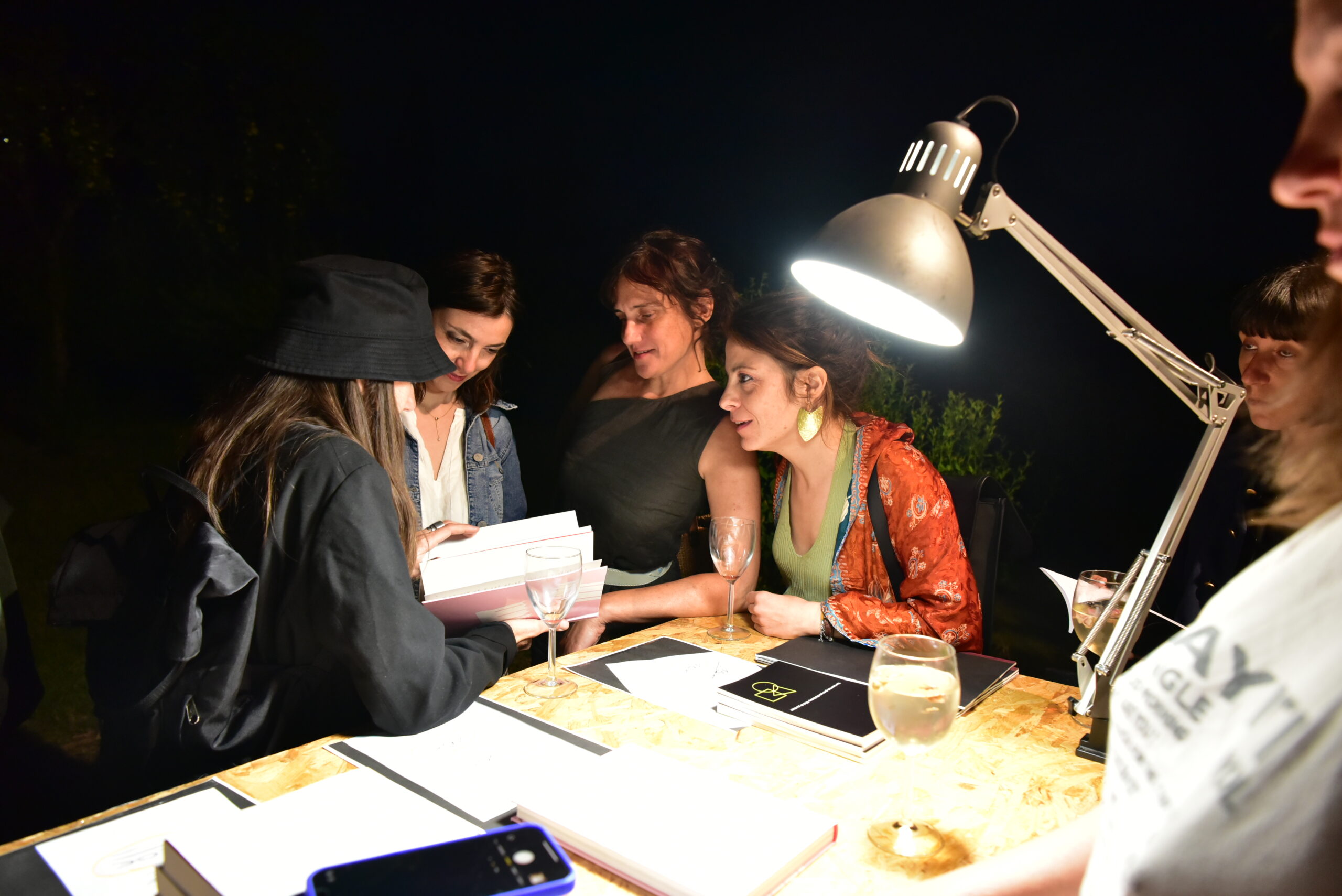
SelfPleasurePublishing, founded in 2014, is an independent publishing project by Italian artist Jacopo Miliani focusing on sexuality and language. He has collaborated with different authors to produce various publications and events. He published a book in Polari (a cryptic slang that appeared in the 19th century in the UK and was used by marginal communities including homosexuals), the transcription of Pier Paolo Pasolini’s Teorema using gay male dating applications, a study on the ‘whispering’ language of man-to-man love in Japan and a collection of photographs shot in the 90s by the dancer and artist Marco Mazzoni.
For MANIFESTIAMO SelfPleasurePublishing will present special discounts, whispered stories and special cocktails!
THREE-DAYS WORKSHOP
CampoBase
Exhausting Until Blossoming
[Closed workshop]

The different aspects of daily life are nowadays crossed by a certain kind of fatigue, an affective tonality in which we are immersed while we continue to move. From the work environment to the experience of public life, we are constantly driven by the logic of hyper-productivity and hyper-mobility. For MANIFESTIAMO at Villa Romana, CampoBase proposes a three-day workshop dedicated to the theme of exhaustion. In a moment in which people, resources and energy are being fully drained, how can we see the issue of exhaustion as an opportunity for action and not just as a limiting factor? Starting from these questions, CampoBase temporarily extends the collective and incorporates members from different disciplinary fields with the aim of triggering a collective reflection on the meaning and value of the term exhaustion. The research workshop sessions will lead to a third moment of shared discussion, open to the public. The contribution produced will be an attempt to imagine new ways through which exhaustion can become a creative technique that challenges or alters the redundant rhetoric that ‘there is no alternative’.
CampoBase is a multidisciplinary curatorial collective composed of researchers, philosophers, curators, mediators, art historians and writers that operates as an itinerant platform. CampoBase adopts discursive practices and experimental approaches in the realization of artistic events and projects, aiming to activate collective processes of knowledge through the creation of open environments that favour public occasions for meeting and dialogue. Its research is focused on several topics, including the condition of displacement, the transformative power of affection, the mechanisms of formation of temporary communities in the contemporary cultural context, exhaustion as a psychic, political and social condition of contemporaneity. The member of CampoBase are Irene Angenica, Bianca Buccioli, Gabriella Dal Lago, Ginevra Ludovici, Federica Torgano, Stefano Volpato. The collective has a fluid and inclusive nature: it expands and contracts, welcoming new members who become part of it for specific projects in a process of permanent self-constitution.
LECTURE
Mario Rizzi
Storytelling as an Art Form
The event will be streamed live on the Facebook page of Villa Romana.
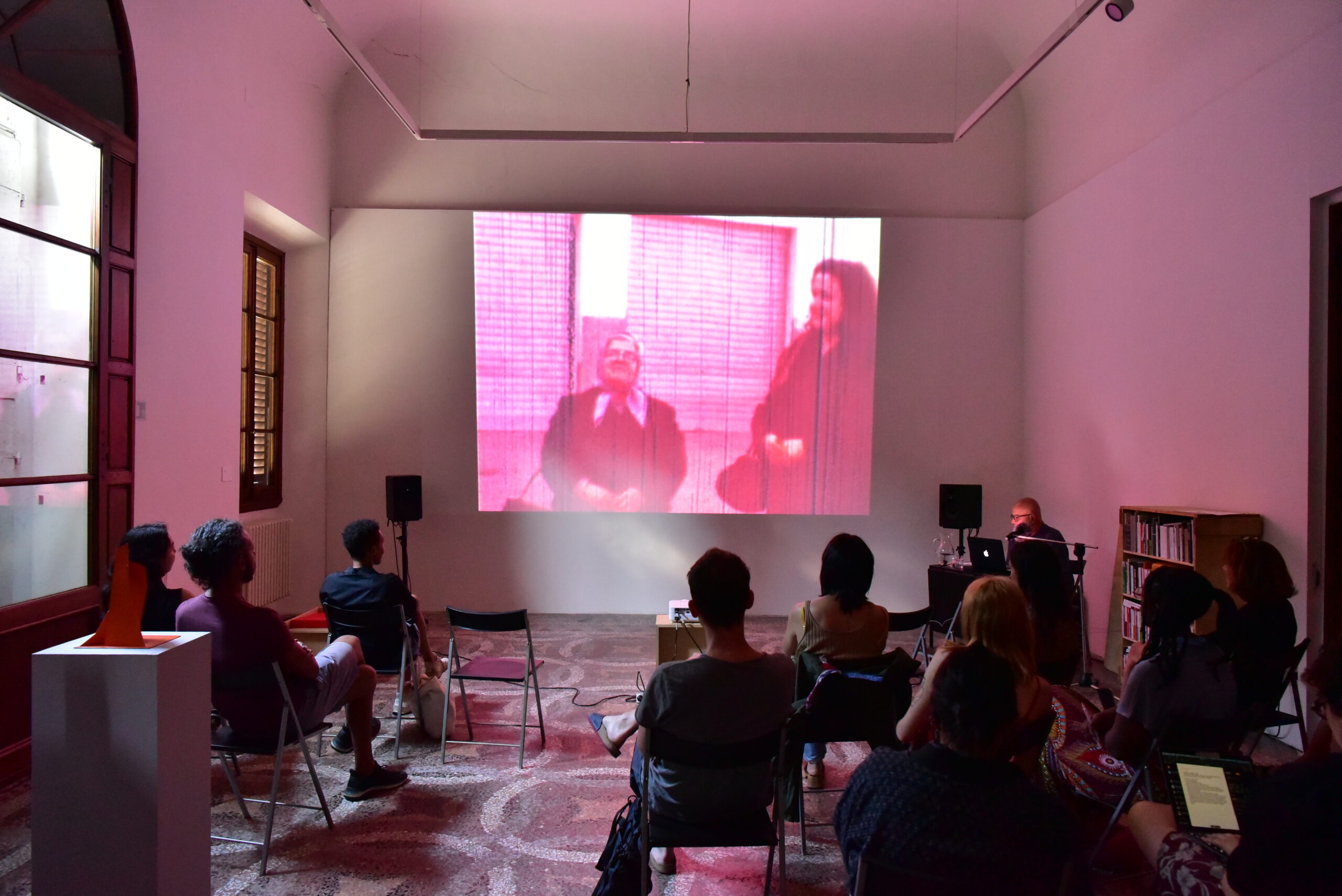
When we talk about oral history, we mainly refer to the research of a sociologist, an anthropologist or a historian. Also, the psychologist in the field of psychotherapy, the journalist, the documentary filmmaker, and of course many visual artists, often focus on telling the personal and family memories of an individual, using interviews and documents or the images and sounds of everyday life. All these professionals play an important role in preserving the oral tradition of an entire community, albeit with the epistemological principles of the discipline producing the research, oriented by the disciplinary context to which the scholar-producer refers.
So what are the semantic and methodological characteristics of the artist, what are the aspects of artists’ narrative and visual research, the points of contact and the differences from other forms of storytelling?
First of all, there is a big difference between understanding that the private is also political, as the cliché claims, between understanding that the uniqueness of a personal story is never separated from the events of a community in a specific historical moment, and exploiting the storytelling to demonstrate a sociological theory or, even more, a partisan political interpretation, or to indulge in journalistic sensationalism. An artist is always aware that it is different to ‘make a film politically from making a political film’, as Godard put it. Approaching the life of an individual for a contingent purpose is a ballast that cannot be reconciled with the universality of the work of art. A clear example of this is the different approach that can be taken to the story of a refugee by the media, often influenced by the selfishness of the majority and the need to gain an audience, or in the context of a socially committed artistic practice that focuses on their stories as human beings, to learn not about their past traumas but their present feelings, maintaining a creative balance between empathy and independence, between reality and the poetry of the everyday. Orson Welles wrote that ‘a film is never really good unless the camera is an eye in the head of a poet’.
It is just as different to focus on the historiographic objectivity of a story, a necessary aspect of a historian’s research, or to favour the intimate, subjective element of storytelling, the possibility of giving voice to unheard stories without worrying that sometimes memories undergo a necessary cathartic process of past traumas, or are hidden among the nuances of language for the modesty of the present. An obvious example are ‘al hawadith’, the private images of the events of the Lebanese civil war, totally deconstructed by official historiography and, on the contrary, rich in humanity and poetry in the images of Lebanese artists such as Akram Zaatari.
Telling the story of the protagonist of one’s own film certainly poses questions of method, narrative structure and communication for each artist (and often of the ‘lost in translation’ in the narration that arises from a dialogue). There are often the risks of an orientalist approach to the life of the other, and certainly also ethical and confidentiality problems both in the filming phase and in post-production. In the post-production phase, in fact, the images or words of a story are often combined or separated, creating a new fictional narrative that does not necessarily reflect the reality of the events, but only the creative freedom of the artist. The aspects of authorship must also be taken into account, since storytelling places two individuals in a dialogue, the artist and the protagonist, and these two authorial individualities are joined by the creative contributions of the production and post-production technicians.
Over the last 25 years, my artistic production has been that of a visual storyteller of stories of marginality or borders, of lives compromised by the impact of the dehumanising forces of globalisation, of women who have made a major contribution to their community while remaining in the shadows. These stories can sometimes be hidden within the structure of a fairy tale, as is the case of the Albanian Roma I lived with in 2003: their ‚paramisa‘ blend personal and family history into children’s stories with a semantic structure defined by tradition, thus ensuring that they are not lost.
In my work, storytelling is essentially defined in two ways. In films such as Murat ve Ismail (2005), or Al Intithar (2013), which may seem more documentary, the fictionalisation phase takes place at the moment of post-production. It is during editing that a story and a narrativity are created. While I’m shooting, I don’t give any kind of indication to the protagonists, but then the films have a structure in which everything seems to happen according to a precise script. So I start from pre-existing images and complete the writing process later.
In other works, such as Kauther (2014) and impermanent (2007), about the Palestinian exile Ali Akilah, it is the protagonist who narrates in the first person, in a form of direct testimony that makes it possible to fix and pass on a story that would otherwise be lost.
In The Little Lantern (2019), on the other hand, I felt it was important to give Anni Høver Kanafani the chance to tell her story and to highlight the salient moments in first person, but at the same time I felt it necessary to construct a narrative structure that would allow me to underline the educational and identity value of her action. I therefore combined the documentary and fictional elements through the children who attend one of the Kanafani Foundation’s kindergartens in the Burj el Barajneh camp.
My talk will reflect on various aspects of storytelling with the help of excerpts from my films and a filmic homage to the work of Brazilian documentary filmmaker Eduardo Coutinho, in particular his masterpiece film Master: A Building in Copacabana.
PERFORMATIVE LECTURE
Nine Budde
Coffee and Cigarettes – Gestures of the Past
The event will be streamed live on the Facebook page of Villa Romana.
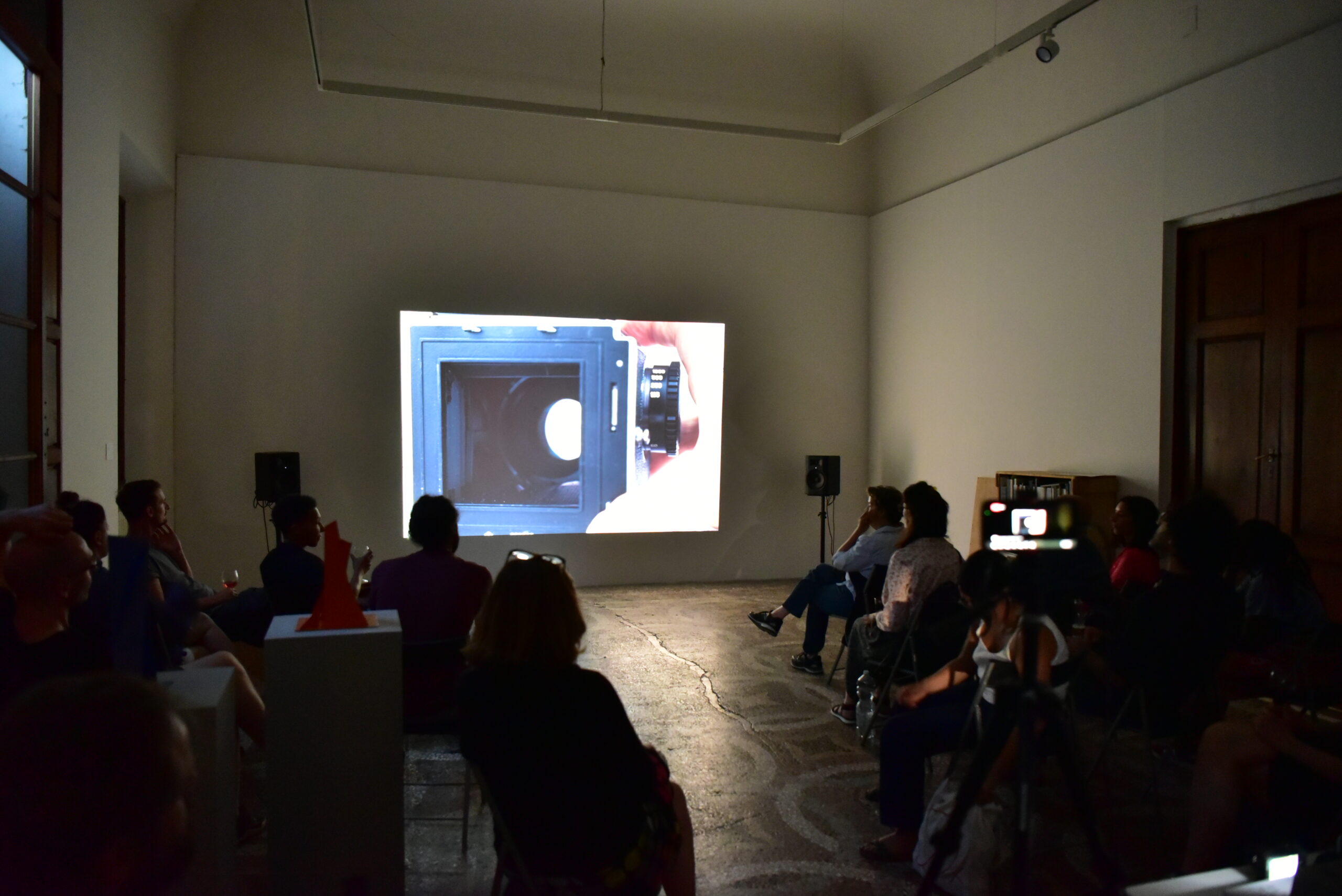
An analogue slide show by Nine Budde.
Coffee and Cigarettes – Gestures of the Past will refer to a text written by Budde on the topic of art as a vehicle from a photographer’s point of view. The presentation will also reflect on books in libraries, the Hopi tribe in New Mexico and the importance of doing nothing.
Nine Budde, artist, living in Berlin, Villa Romana Fellow 2012.
POETRY READING
Silvia Guasti (in Italian)
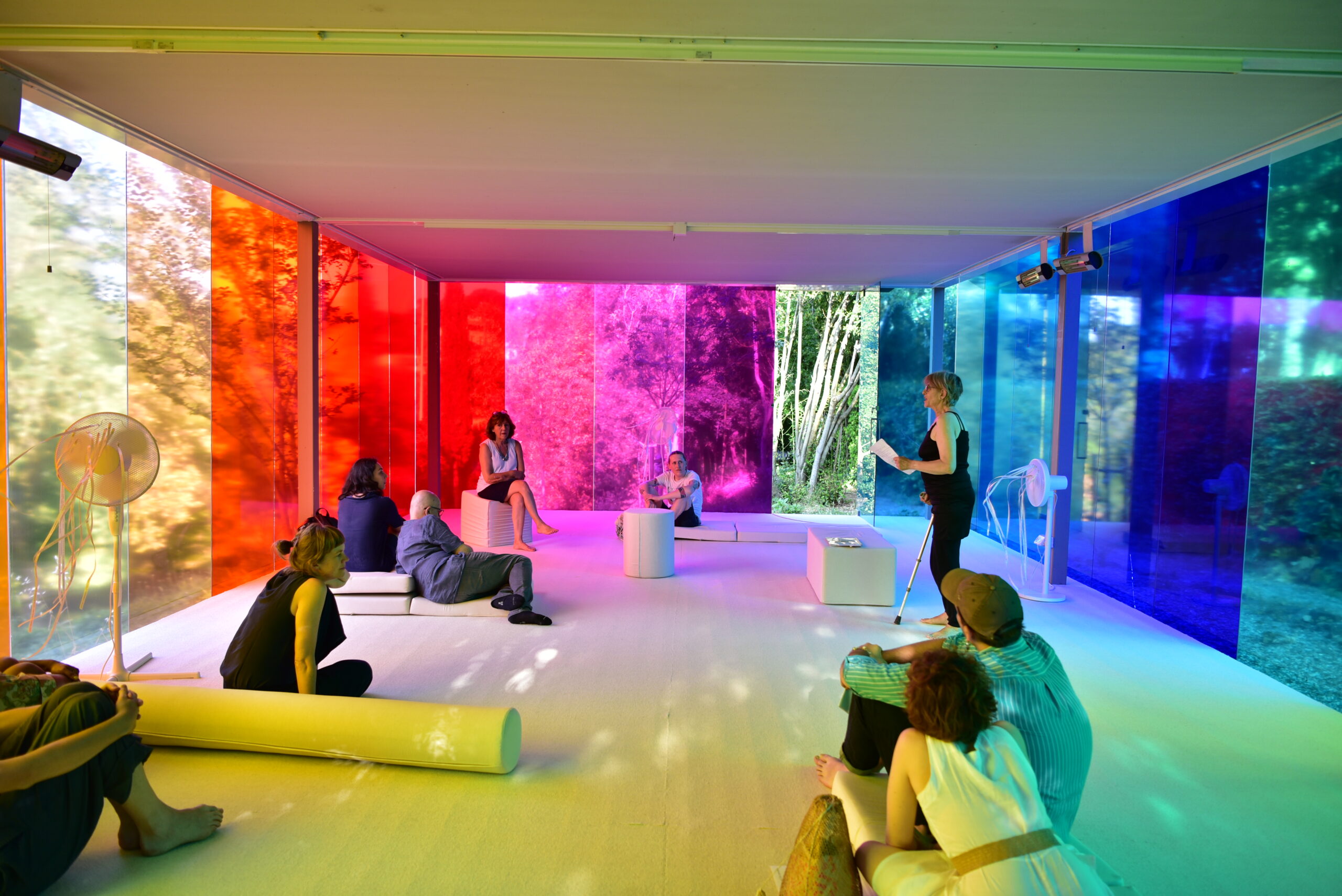
Silvia Guasti (in Italian)
imagesPUBLIC PRESENTATION
CampoBase
Exhausting Until Blossoming

The different aspects of daily life are nowadays crossed by a certain kind of fatigue, an affective tonality in which we are immersed while we continue to move. From the work environment to the experience of public life, we are constantly driven by the logic of hyper-productivity and hyper-mobility. For MANIFESTIAMO at Villa Romana, CampoBase proposes a three-day workshop dedicated to the theme of exhaustion. In a moment in which people, resources and energy are being fully drained, how can we see the issue of exhaustion as an opportunity for action and not just as a limiting factor? Starting from these questions, CampoBase temporarily extends the collective and incorporates members from different disciplinary fields with the aim of triggering a collective reflection on the meaning and value of the term exhaustion. The research workshop sessions will lead to a third moment of shared discussion, open to the public. The contribution produced will be an attempt to imagine new ways through which exhaustion can become a creative technique that challenges or alters the redundant rhetoric that ‘there is no alternative’.
CampoBase is a multidisciplinary curatorial collective composed of researchers, philosophers, curators, mediators, art historians and writers that operates as an itinerant platform. CampoBase adopts discursive practices and experimental approaches in the realization of artistic events and projects, aiming to activate collective processes of knowledge through the creation of open environments that favour public occasions for meeting and dialogue. Its research is focused on several topics, including the condition of displacement, the transformative power of affection, the mechanisms of formation of temporary communities in the contemporary cultural context, exhaustion as a psychic, political and social condition of contemporaneity. The member of CampoBase are Irene Angenica, Bianca Buccioli, Gabriella Dal Lago, Ginevra Ludovici, Federica Torgano, Stefano Volpato. The collective has a fluid and inclusive nature: it expands and contracts, welcoming new members who become part of it for specific projects in a process of permanent self-constitution.
ADCF (AFRICAN DIASPORA CINEMA FESTIVAL)
CINEMA FESTIVAL
Wednesday 15/ Thursday 16/ Friday 17/ Saturday 18
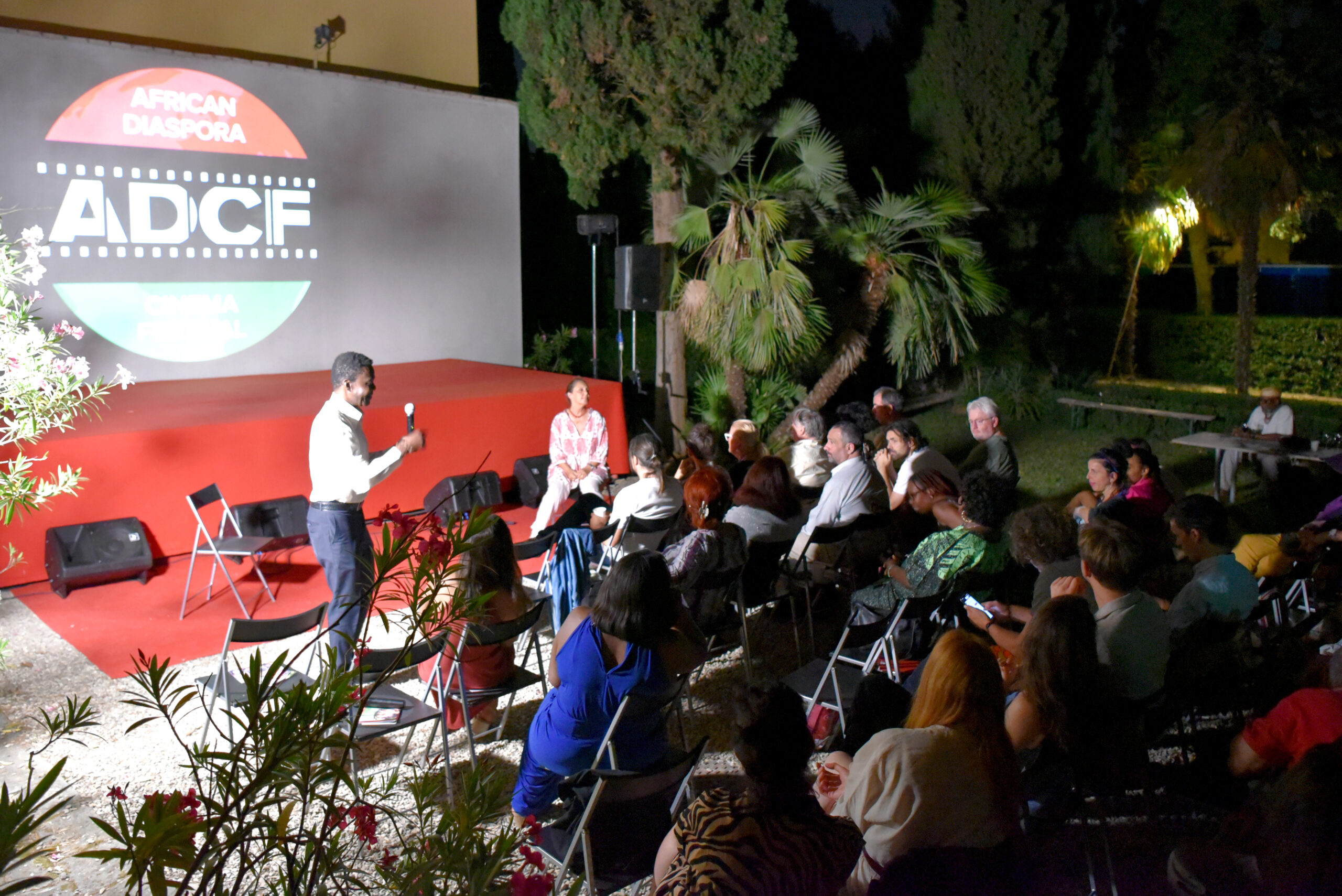
Villa Romana is pleased to present the 7th African Diaspora Cinema Festival.
Since 2013, the African Diaspora Cinema Festival (ADCF) has become an international beacon for the African diaspora film and arts communities. Every year the ADCF attracts to the city of Florence filmmakers, artists, and unique craftspeople from over 40 countries across the globe to showcase their work and talent. Thus, the ADCF has become a celebration of African Diaspora cultures in Italy.
Annually, the ADCF continues to receive hundreds of high-quality Black films from the U.S., Africa, the Caribbean, South America, Europe, the South Pacific, Canada, and Asia. Established in 2013 by Fide Dayo a filmmaker and African Movie Academy Award nominee (Ben Kross, Minister), the ADCF is a non-profit organization that has remained dedicated to the promotion of Black stories and images through the exhibition of film, visual art, and other creative expressions.
The ADCF presents films from and about Africa and the African diaspora that focus on heterogeneity, mobility, and global cultural and infrastructural interconnections. The selection of 20 finalist films for the 2022 edition of the African Diaspora Cinema Festival – out of a total of about 140 works in competition – brings together not only works by African or global diaspora filmmakers but also by international filmmakers.
The festival will open its doors with a screening of Little Satchmo directed by John Alexander, in the presence of leading lady Sharon Preston-Folta, daughter of Louis Armstrong. In Little Satchmo the director tells the story of the jazz genius’s secret daughter through footage, old period images, Sharon Preston-Folta’s memories and, of course, Armstrong’s music. A secret daughter he had by dancer Lucille Preston and who was kept hidden from the world. Little Satchmo is the nickname by which the trumpeter called little Sharon. Based on an autobiographical book, the film chronicles the presence and long absence of a father, a search for truth and identity.
Admission to the screenings will be free. The detailed program of the event will be available on the Villa Romana website www.villaromana.org and on the ADCF website www.africandiasporacinemafestival.com.
For information contact office@villaromana.org
Program
Free Admission!
Wednesday 15.6.
Villa Romana
GARDEN ROOM
18.00
Films’ presentation by Fide Dayo
18.05
FILM SCREENINGS
Tomas Kamphuis, Art Chooses Us (Netherlands), 13’ 10”
Denise Alder, Mablo Micasso’s Dream (United Kingdom), 6’
Anna de Manincor, ZimmerFrei, Trio (Italy), 21’ 41”
GARDEN
20.00
Official festival opening by Fide Dayo & Antonella Bundu
Presentation of the team “Little Satchmo“ & Sharon Preston Folta, the daughter of Louis Armstrong
20.15
Live performance
Levy, Jazz Singer from Chicago, 15’
20.30
Video archives
The ADCF Journey by Antonella Bundu & Fide Dayo
21.00
Concert
Blip Trio
Justin Randolph Thompson, guitar and voice, Francesco Amadio, drums, Simone Falcone, bass (Florence)
22.00
FILM SCREENINGS
John Alexander, Little Satchmo (United States), 61’
Q&A in presence of the director John Alexander
Thursday 16.6.
Villa Romana
GARDEN ROOM
17.00
FILM SCREENINGS
Florent Mahoukou, Face to Face (Congo), 19’ 54”
Valerio Lopes, The Africologist: Chronicles of Africa (Tanzania), 72’
Olivier Kancel, „Hide and Seek“ (Guadeloupe), 12’ 50”
Adrian L. Burrell, The Game God (United States), 19’
Ibrahim Ebrima Faal , Don´t Kill my Dreams (Sweden), 9’ 30”
GARDEN
20.25
Presentation of Sartoria migrante Kirikuci by Fide Dayo & Antonella Bundu
21.10
Antonella Bundu presents Andrea Searle, Kalbelia dancer
21.40
FILM SCREENINGS
Ken Schneider / Marcia Jarmel (PatchWorks Films), The Brothers (Cuba), 80’
Kita Bauchet, Saint-Louis on the Move (Senegal), 32’
Friday 17.6.
Villa Romana
GARDEN ROOM
17.00
FILM SCREENINGS
Sibongile L. Nene, Iyeza Medicine Biopiracy (South Africa), 21’ 17”
Thierry Michel, Empire of Silence (Belgium), 110’
GARDEN
20.30
Book presentation
Antonella Bundu presents the book, IL Mondo è Servito by Frida Nacinovich, guest: Delisia Essono
21.30
FILM SCREENINGS
Alexander Wadouh, Borga (Ghana), 107’
Junadry Leocaria, Imprenta (Netherlands), 18’ 10”
Saturday 18.6.
Villa Romana
GARDEN ROOM
17.00
FILM SCREENINGS
Christian Carroll, Out of Breath (United States), 98’
Morad Mostafa, Khadiga (Egypt), 19’ 55”
GARDEN
20.20
Concert
Daniel Kollè, percussion, vocals (Milan)
21.30
FILM SCREENINGS
Gisella Gobbi, Senza Nome (Italy), 10’
Jillian Reeves, Broken (United States), 14’ 39”
Nathan Rice, The Road Less Cycled (South Africa), 100’
23.45
Awards Presentation
15. – 18.6.2022
FESTIVAL BAR
Villa Romana
The bar will be open for snacks and drinks from 6.30 pm.
BENEATH IMAGE AND SCRIPT. ON COSMOGONY AND CONFLICT IN IMAGE SYSTEMS
PRESENTATIONS, DISCUSSIONS
With contributions by Tom Holert, Els Lagrou, Esther Leslie, Bárbaro Martínez-Ruiz, Erhard Schüttpelz, Carlo Severi, Maria Stavrinaki, Ulrich van Loyen, David Wengrow, Matthew Vollgraff, Armin Linke, Serge Gruzinski, moderated by Anselm Franke
A collaboration between Haus der Kulturen der Welt (HKW), Berlin and Villa Romana
Registration necessary: office@villaromana.org
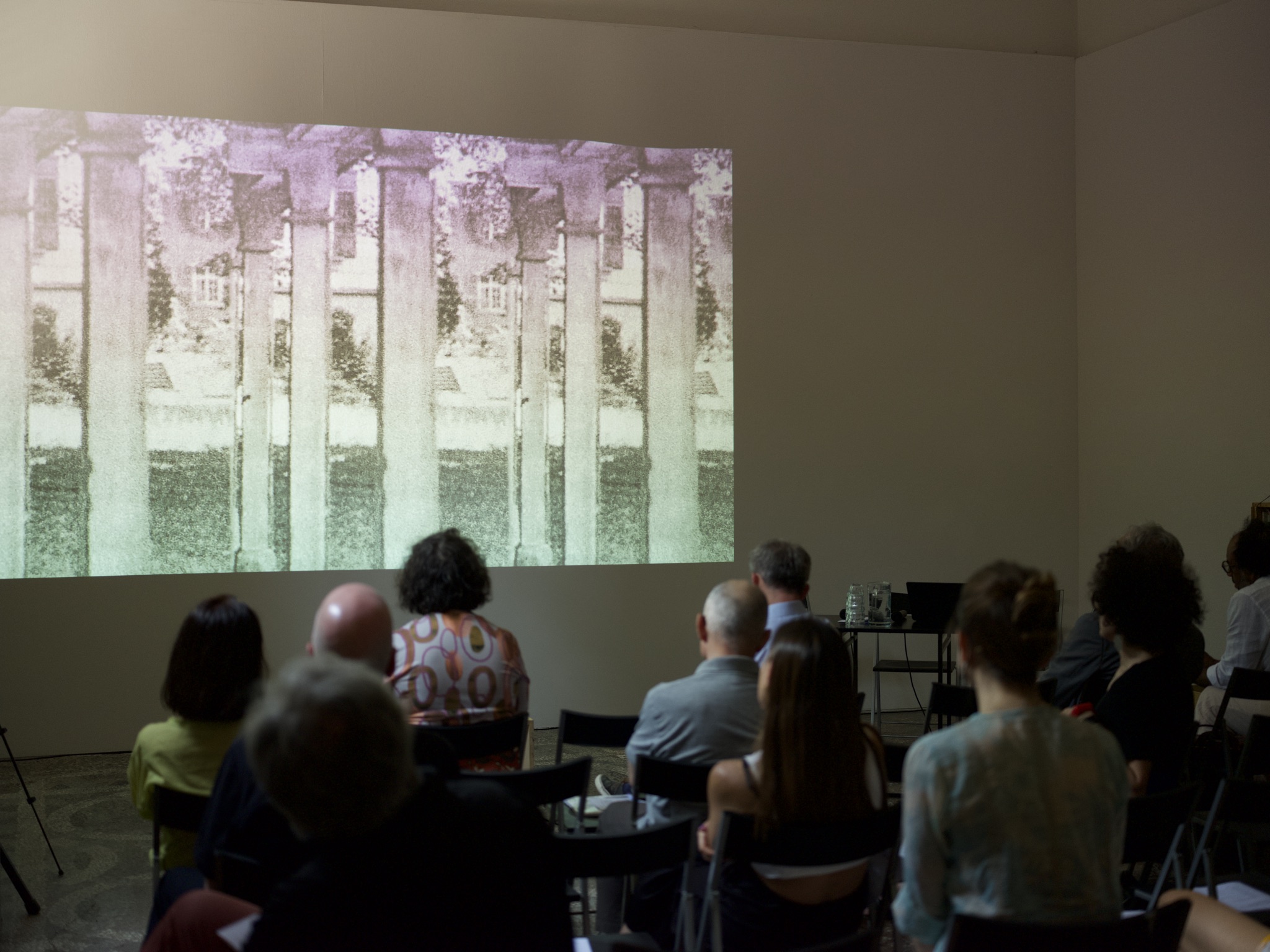
What role do images play in the creation of social worlds? On the intercontinental histories of art and culture, based on Aby Warburg.
What are the consequences of distinctions between “literate” and “oral” societies, between “image” and “script”? New research approaches undermine the colonial and Eurocentric classifications that impeded the fulfillment of Warburg’s promise of an intercontinental art history and image theory. The discussions center on a new way of understanding “image systems.” Archeologist David Wengrow describes them as the symbolic organization of social worlds that enabled specific cultural techniques and ways of life. In talks and presentations, theorists and artists develop new methods for understanding such systems.
ON ALLIGATORS, FISHING INDUSTRY AND RHIZOMATIC PROCESSES
LECTURE / INSTALLATION
Eva Sauer
Toxic colonisation

The term ‚toxic colonialism‘ commonly defines the trafficking of toxic waste from rich countries to former colonies, or, more broadly, the occupation of territory by the ‚lower echelons‘ of the economic hierarchy through the illegal dumping of production waste from strong economies.
Behind this reality lies a network of white-collar workers in the service of corrupt governments, fixers, unscrupulous transport companies and, finally, mafias. As we follow the flow of raw materials and waste to and from the South, we come face to face with the harsh reality that much of this waste is considered environmentally toxic in the West, while corrupt or blackmailed African governments do not pass any laws to stop these dangerous ‚goods‘ at the border.
The lecture aims to list the many negative aspects of toxic neo-colonialism, linked to the fiercest global neo-liberalism, largely responsible for the problems that lead, among other reasons, to the mass migrations that spill over to a West increasingly struggling with its economic and social fabric.
Eva Sauer, artist, photographer, born in Florence, lives in Duesseldorf and Florence
PERFORMANCE
Judith Raum
Les Primes
French bonuses for industrial fishing standards in Senegal and other colonial crop games
Lecture Performance, 40 min, engl language
co-performing: Ludivine Gragy
The event will be streamed live on the Facebook page of Villa Romana.
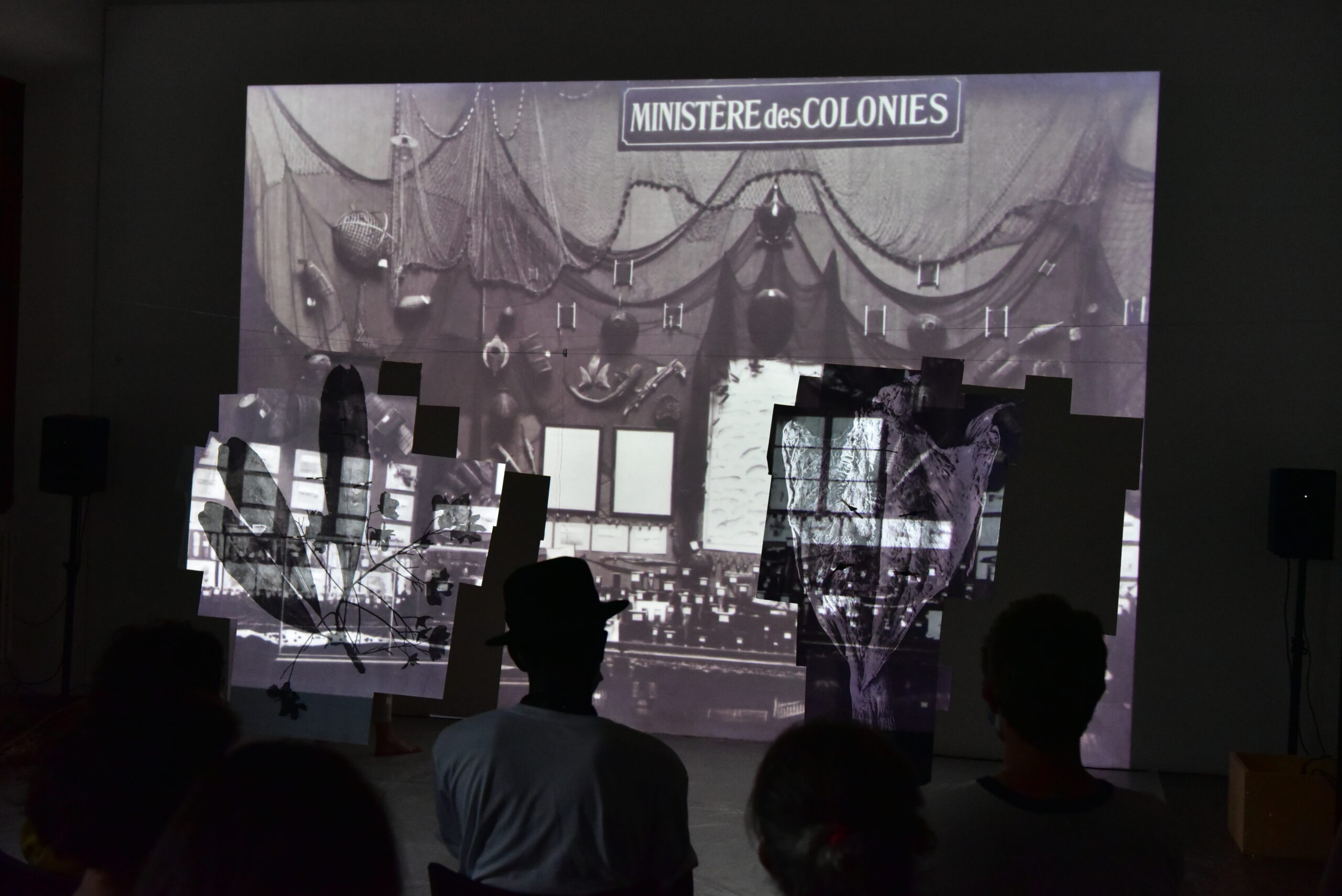
While researching in the archives of the Musée National d’Histoire Naturelle in Paris, Berlin-based artist Judith Raum unearthed documents on the history of fishing on the Senegalese coast in French colonial times. These show that the current fish shortage on the African west coast, one of the reasons for many people leaving their homeland, has its origins in the establishment of systematic large-scale fishing at the end of the 19th century. At that time, European entrepreneurs and scientists tried to organize a greater supply of protein for people in Europe, and also in African countries, – and destroyed nature to do it.
In her lecture performance, Judith Raum traces the lines of this organized exploitation in a kind of sculptural ritual using original texts, archive images and sculptural actions.
Judith Raum, artist, Master in philosophy, psychoanalysis and art history, lives in Berlin. Villa Romana Fellow 2015.
SCREENING
Nico Joana Weber
Tropic Telecom (2020)
No Longer A Single Root (2021)
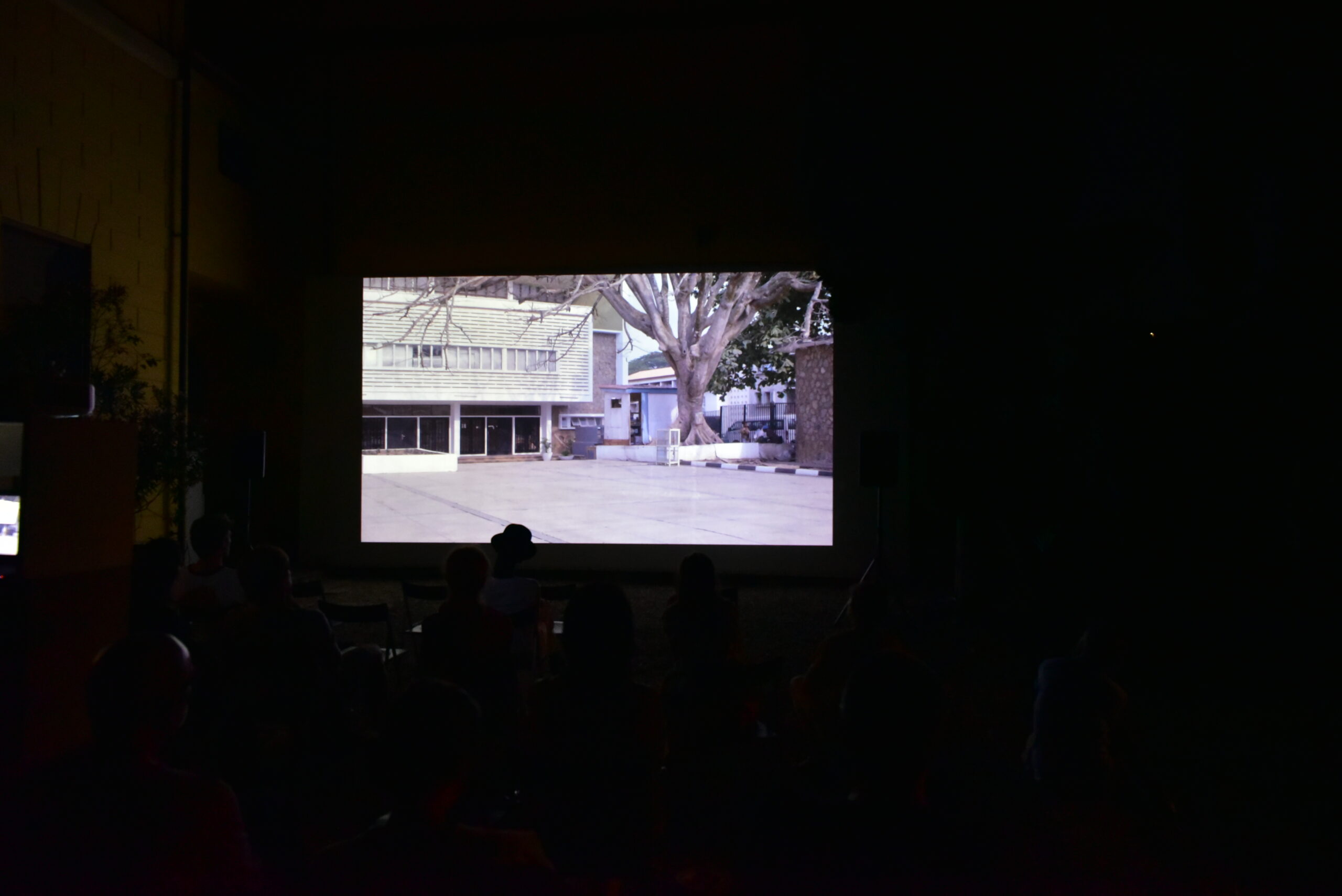
Tropic Telecom (2020)
Tropic Telecom reflects contemporary Paris in its hybrid post-colonial reality. The work develops from the Palais de la Porte Dorée, which opened in 1931 on the occasion of the Paris Colonial Exhibition. A crocodile basin is to be found in the still accessible aquarium of the palace that was used to showcase fish from the tropical colonies. As the film proceeds, an albino alligator embarks on a surreal journey. It leads the viewer through sites of French colonial and migration history, as well as large brutalist and post-modern housing estates on the outskirts of Paris that were built from 1970 onwards and stand for the residential utopia of a postcolonial Paris.
No Longer A Single Root (2021)
In his work Poetics of Diversity, the French writer and poet Édouard Glissant reflects on the concept of identity which is, for him, both ‘factor and result of a creolization’, a rhizomatic process, ‘no longer a single root, but a root reaching out to other roots.’ Glissant’s reflections can be understood as the film’s conceptual backdrop as it narrates this entanglement through three examples of building culture in Nigeria which were all informed by transcultural endeavours in different historical and political circumstances.
Nico Joana Weber, artist, lives in Ludwigshafen, Villa Romana Fellow 2016
LECTURE
Vera-Simone Schulz
Central African Raffia Weavings, Anatolian Pile Carpets and Renaissance Paintings. Transcultural Connectivity and Art History
The event will be streamed live on the Facebook page of Villa Romana.
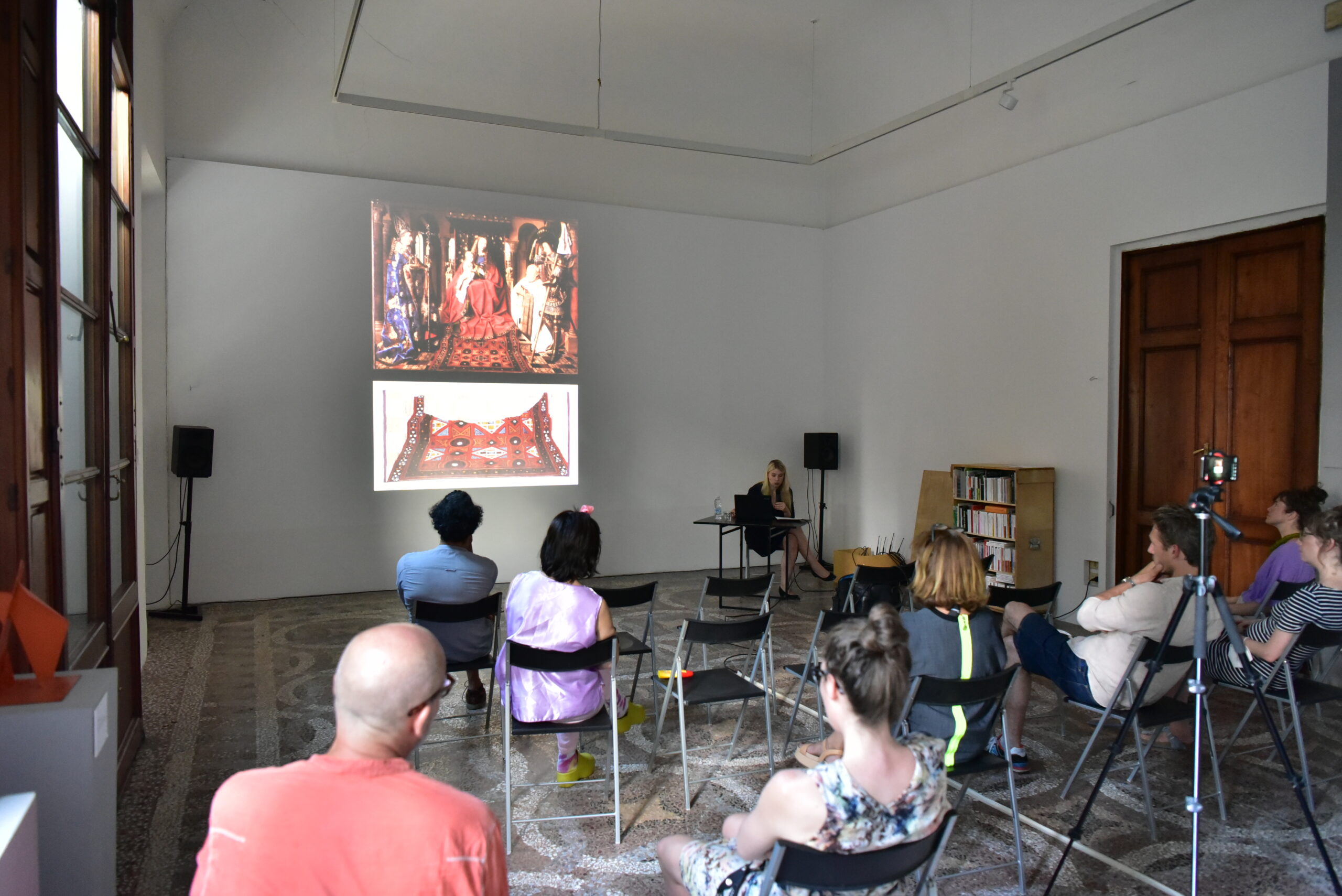
This talk focuses on an interconnected group of images and objects ranging from Central African raffia weavings to carpets from Asia Minor and Italian, Spanish and Portuguese Renaissance paintings, as well as on the trajectories of their multi-layered entanglements through the centuries up to the present. It will illustrate the need to consider these images and objects together in order to gain new insights about complex intersections between images and objects across time and space in the early modern period. It will also further illuminate the necessity to provincialize Europe and Italy within the discipline of art history, and to overcome traditional notions of centre and periphery. The talk will propose new ways to move beyond common East-West stereotypes and paradigms. By tracing and interrogating the intersected dynamics of this group of images and objects, it will shed light on image-object-interrelations beyond the boundaries of traditional categories such as Islamic, European, and African art histories. It will show what is to be gained from a wider perspective beyond ‘fine art’ versus ‘decorative art’ hierarchies. And, by taking a fresh look at the images and objects themselves, at their multiple interrelations across media, materials, and geographical areas, and at the repercussions of their entanglements, the talk will highlight transcultural dynamics and issues of connectivity and resistance that will take us – quite literally – across the globe from the early modern period up to the present.
Vera-Simone Schulz, art historian and postdoctoral research associate at the Kunsthistorisches Institut in Florenz – Max-Planck-Institut
TALK / FILM
Antje Majewski
The shell. Conversation between Issa Samb and Antje Majewski

A conversation with the artist and philosopher Issa Samb in his yard in Dakar. Issa Samb talks about our responsibility to help objects move in the world, while respecting their history and origin, even in the tiniest object made in China. The charge that objects carry derives ultimately from the same force that also fills us. In the second half of the film, Issa Samb unexpectedly tells Antje Majewski to listen to a big shell that she had brought with her, and guides her into a trance in which she describes the inside of the sea and hears a voice singing in the shell. The video is part of a series of philosophical conversations about ‘talking’ objects, conducted by Antje Majewski for The World of Gimel, Kunsthaus Graz 2011.
An introduction by the artist will be given on Zoom before the film screening.
HD-Video, colour, sound, 58 min, 2010.
Produced by Kunsthaus Graz / Weltkulturen Museum, Frankfurt
© Antje Majewski 2010
Cast: Issa Samb, Antje Majewski
Crew: Direction, Sound, Editing Antje Majewski
Cameras: Antje Majewski, Kalin Lindena, Aboudleye Bâ
Sound mixing assistance: Christoph Ulbich
Translation: Antje Majewski
Subtitles: Katrin Meyberg
Curator: Clementine Deliss
Production: Weltkulturen Museum Frankfurt, Kunsthaus Graz
Credits: Clementine Deliss, Issa Samb, Abdouleye Bâ, Adam Budak, Peter Pakesch
Antje Majewski, artist, living in Berlin and Himmelspfort, professor for painting at Muthesius Kunsthochschule in Kiel.
PERFORMANCE
Autumn Knight
YES + NO
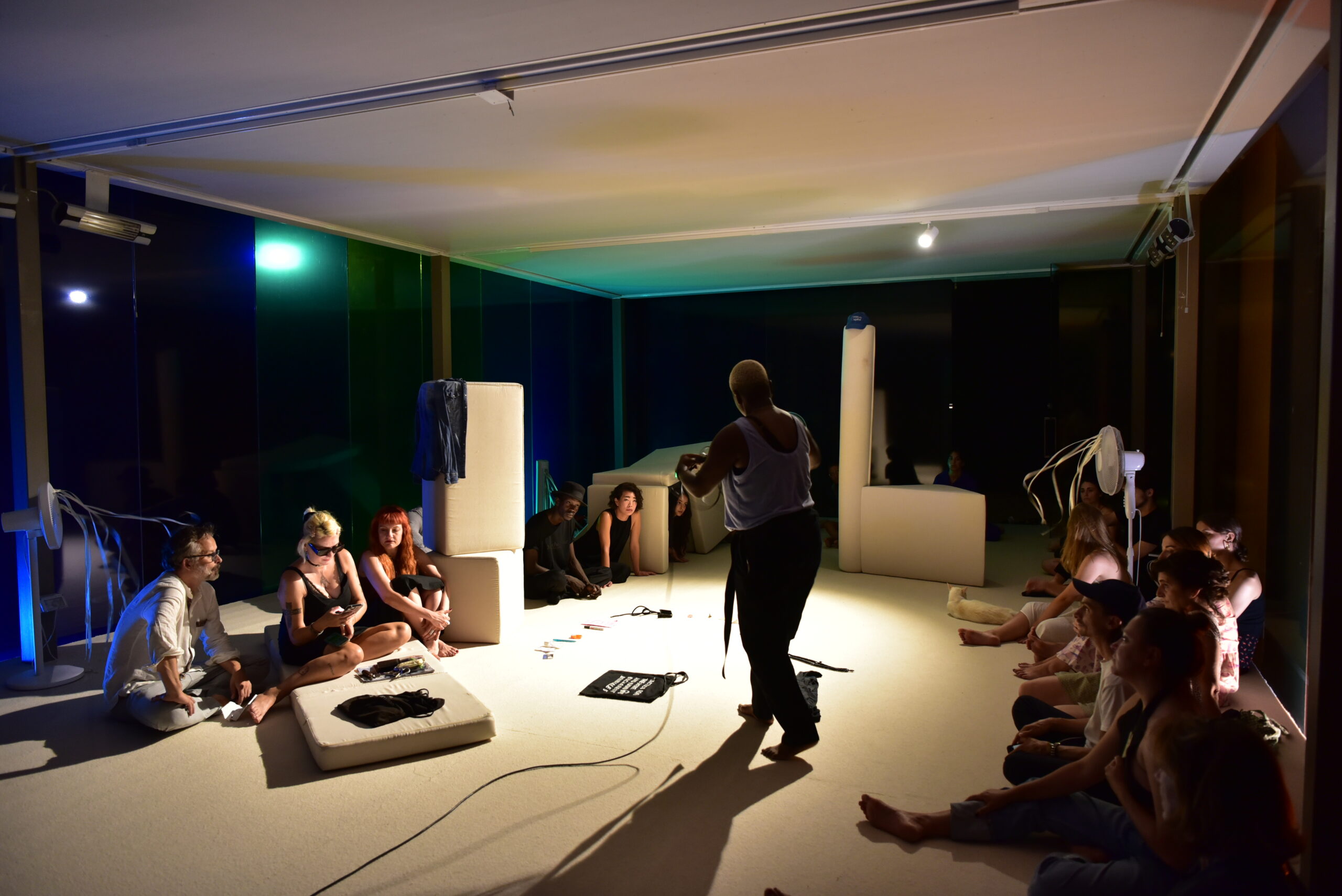
Yes+ No is a solo performance by current Rome Prize fellow Autumn Knight. This is an engaging performance utilizing loosely related gestures and sparse language to communicate a series of ideas on certain aspects of joining, one-ness, me-ness, and typical systems of group behaviour. Part 1 uses text, light persuasion, and vocalization to think about the construction of collective thought, action, and belief. Part 2 is a lecture about cognitive dissonance. Examining collective identity based on geopolitics, breaking apart /down behaviour, Black women in positions of authority globally.
In collaboration with The Recovery Plan and The American Academy in Rome
Autumn Knight is an interdisciplinary artist working with performance, installation, video and text. Her video and performance work have been viewed within several institutions including the New Museum (NYC), Western Front, (Vancouver, Canada), Akademie der Kunste (Berlin), On the Boards (Seattle), The Whitney Museum of American Art and The Kitchen (NYC). Her performance and video work is held in the permanent collection of the Studio Museum in Harlem. Knight is a recent recipient of The Nancy B. Negley Rome Prize.
PUBLIC TIME. MONUMENTS AND GHOSTS IN FLORENCE: A WALK AND A CONVERSATION
LECTURE
Eleni Kamma
Taking Place: Parrhesiastic Theater as a Model for Artistic Practice
The lecture will be held at the Kunsthistorisches Institut in Florenz—Max-Planck-Institut: Via Giuseppe Giusti 44, 50121 Florence
Registration (participation in person): Julia.Biel@khi.fi.it
Registration (participation via Zoom): https://zoom.us/meeting/register/tJMofuqoqzsvHNYhFmCbKFFHtoV10YtDsHJM
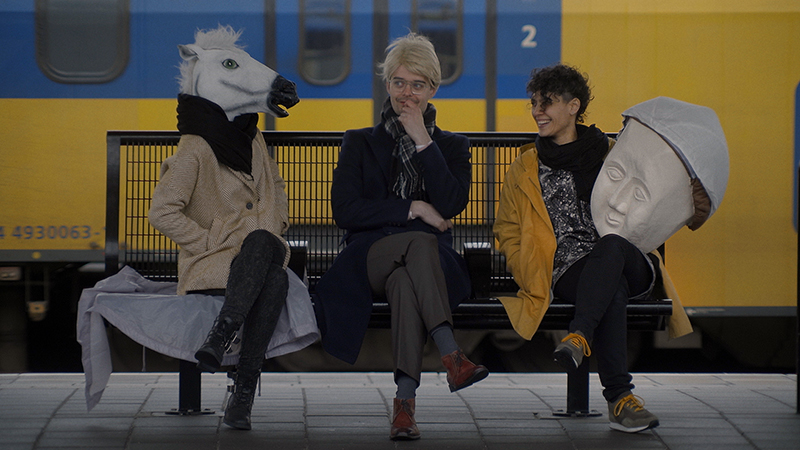
Kamma’s research project examines how local and traditional European forms of parrhesiastic theatre relate to and provide new insights into critical artistic practices today and how tensions between the roles of individual and group, ‘I’ and ‘we,’ artist – audience – institution, may open up a parrhesiastic space for critical artistic practices. Parrhesiastic theatre takes place in public view and incites the spectators’ agency to speak their minds.
Eleni Kamma (Athens, 1973) is a visual artist and researcher. She holds a PhD Doctoral degree from Leiden University Academy of Creative and Performing Arts (2016-2021). Kamma is a member of Jubilee, a Brussels-based platform for artistic research and production. She lives and works in Brussels and Maastricht.
Europa is…, 2021, 02 min 3 sec,colour, stereo sound, 16:9, 2021
Written by Joep Vossebeld; performers: Joep Vossebeld, Shila Anaraki, Margo van de Linde; cinematographer: Vincent Pinckaers; sound recording & sound mix: Laszlo Umbreit, color grading: Miléna Trivier. Shot at Maastricht Train Station in 2019.
PUBLIC WALK AND CONVERSATION
Public Time, Monuments and Ghosts in Florence: A Walk and a Conversation
With Roberto Budini Gattai, Leone Contini, muSa Michelle Mattiuzzi, Caroline E. Murphy, Esper Postma, Vyjayanthi V. Rao, Neda Saeedi et al.
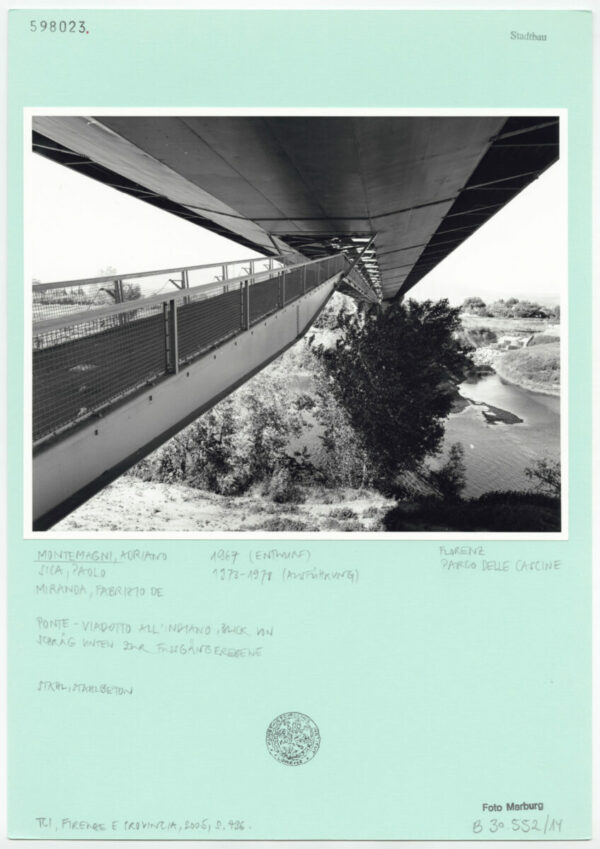
Path: Quartiere Isolotto, Southern bank of the Arno river, Ponte all’Indiano, Monumento all’Indiano, Manifattura Tabacchi
Meeting point: 9.00 am in front of Parrocchia della Beata Vergine Maria Madre delle Grazie all’Isolotto, Piazza dell’Isolotto
Participation only with pre-registration until 29 June, please send a message to: office@villaromana.org. The number of participants is limited.
What do we consider a monument in a city where the historic centre is labelled and marketed as the ‘Cradle of the Renaissance’? Do we expect monuments? Do they expect us? How have they changed their meanings over time? Who ascribes meaning to them? What has never become a monument, but still ghosts through the ages as a witness? How does a city open up and seal itself in time? Is there a ‘public time’? A time that becomes public? In which a city can be ‘read’?
Walking together through the western periphery of the city, we observe and discuss a zone on both sides of the Arno: The Isolotto neighbourhood with its gardens, built in the post-war period as a model of social housing, the Ponte all’Indiano, a cable-stayed bridge over the Arno built in the 1970s, and the Le Piagge neighbourhood, which – built in the 1960s – was at times a social hotspot. A small branch leads to the Monumento all’Indiano in the Cascine Park, built in memory of the Indian Prince Rajaram Chuttraputti, Maharajah of Kolhapur, who died suddenly in Florence in 1870 at the age of 21 on his way back from London.
The event results from a three-year cooperation between the Kunsthistorisches Institut in Florenz – Max- Planck-Institut and Villa Romana, which since 2019 jointly invited ‘International Research Fellows’ and thus initiated an intensified dialogue.
Kunsthistorisches Institut in Florenz – Max-Planck-Institut / Foto Marburg, 2003
ROUND TABLE
Public Time, Monuments and Ghosts in Florence: A Walk and a Conversation
With Roberto Budini Gattai, Eleni Kamma, muSa Michelle Mattiuzzi, Esper Postma, Neda Saeedi, Vyjayanthi V. Rao, in conversation with Hannah Baader, Costanza Caraffa, and Angelika Stepken

What do we consider a monument in a city where the historic centre is labelled and marketed as the ‘Cradle of the Renaissance’? Do we expect monuments? Do they expect us? How have they changed their meanings over time? Who ascribes meaning to them? What has never become a monument, but still ghosts through the ages as a witness? How does a city open up and seal itself in time? Is there a ‘public time’? A time that becomes public? In which a city can be ‘read’?
Walking together through the western periphery of the city, we observe and discuss a zone on both sides of the Arno: The Isolotto neighbourhood with its gardens, built in the post-war period as a model of social housing, the Ponte all’Indiano, a cable-stayed bridge over the Arno built in the 1970s, and the Le Piagge neighbourhood, which – built in the 1960s – was at times a social hotspot. A small branch leads to the Monumento all’Indiano in the Cascine Park, built in memory of the Indian Prince Rajaram Chuttraputti, Maharajah of Kolhapur, who died suddenly in Florence in 1870 at the age of 21 on his way back from Lon-don.
The event results from a three-year cooperation between the Kunsthistorisches Institut in Florenz – Max- Planck-Institut and Villa Romana, which since 2019 jointly invited ‘International Research Fellows’ and thus initiated an intensified dialogue.
The discussion will take place at Villa Romana, Via Senese 68, 50124 Florence
Participants:
Roberto Budini Gattai, architect and urban designer, Florence
Eleni Kamma, artist, international guest artist at Villa Romana 2010/11
muSa Michelle Mattiuzzi, artist, International Research Fellow KHI / Villa Romana 2021
Esper Postma, artist, International Research Fellow KHI / Villa Romana 2020
Vyjayanthi V. Rao, Anthropologist, New York
Neda Saeedi, artist, International Research Fellow KHI / Villa Romana 2022
Introduction: Angelika Stepken, director Villa Romana
Moderation: Hannah Baader, art historian, Permanent Senior Research Fellow at the Kunsthistorisches Institut in Florenz—Max Planck Institute, and leader of the Research Group Transregional Art Histories. Spaces, Actors, Ecologies
Costanza Caraffa, art historian, Head of the Photothek at the Kunsthistorisches Institut in Florenz—Max Planck Institute
Kunsthistorisches Institut in Florenz – Max-Planck-Institut / Foto Marburg, 2003
CONCERT
Gea Brown, Live Set
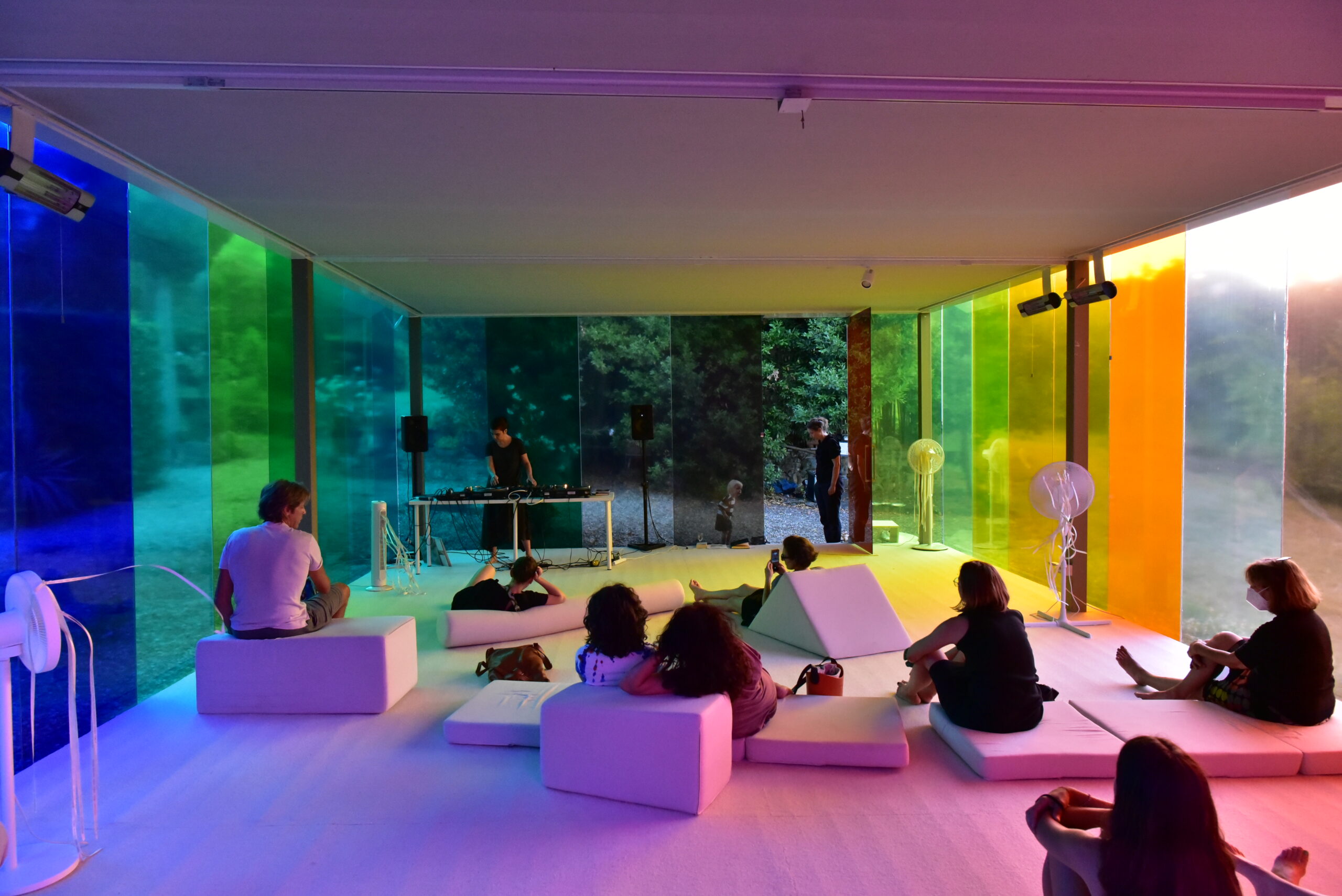
STATAL POLITICS – ARTISTIC LICENSE
SYMPOSIUM
With Ronny Heiremans & Katleen Vermeir (Brussels), Jeremiah Day (Berlin), Ana Texeira Pinto (Berlin), Jörg Heiser (Berlin), Daniel Baker (London), Lucrezia Calabrò Visconti and Justin Randolph Thompson (ART WORKERS ITALIA)
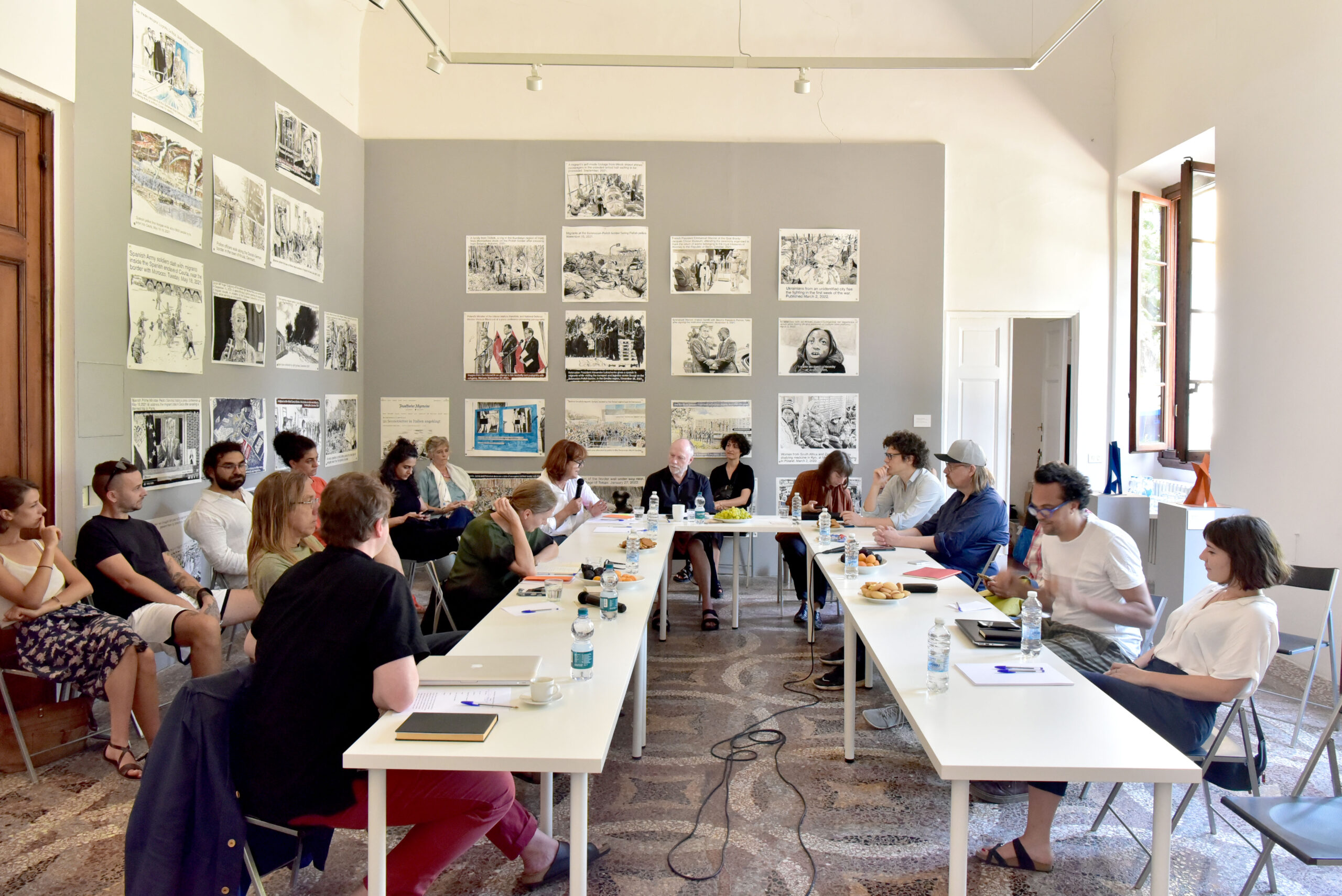
The relationship between state policy and artistic license is a tense and often unspoken one. In the Federal Republic of Germany, it is currently being debated whether culture should be enshrined as a state objective in the Basic Law. This would mean that the state must protect and promote cultural institutions, art, scientific research and teaching, education and artistic activity. But what does that mean? And how nationally is art negotiated then? What ‘protection’ do artists need from the state? And could this end up in a state of dependency and subjection? What is the role of legal agreements for artists? When is a non-German artist considered ‘worthy of protection’ and ‘worthy of promotion’? What rights does the state have in publicly funded institutions? These are questions that come up again and again in concrete terms in the practice of an artists‘ house. Not to mention artistic freedom of entry, which is often blocked by opaque visa practices. Or the need to find project funding for transnational collaborations that are not dictated by political programs …
How do artists and the state negotiate with each other in the first place? How are artists heard? In Italy, the first autonomous and impartial association Art Workers Italia was founded in 2020, to provide legal, fiscal and administrative advice and protection to art workers and to make the art sector more inclusive, sustainable and transparent. In Egypt, after the suppression of the so-called ‘Arab Spring’, many artists have since left the country to save their skins, in the direct literal sense. William Wells, who founded the legendary Townhouse Gallery in downtown Cairo in the 1990s, is no longer allowed to enter Egypt. The gallery was closed again and again after 2012. Artists from Herat in Afghanistan contacted us with cries for help after the Taliban’s transfer of power last summer. Despite numerous letters from us, it is not possible to see whether they were ever put on the German list of people who deserve protection. They have been hiding now for many months to save their lives. And how and where do contemporary artists of Roma heritage, as a non-state community, articulate their need for protection and support? How can a trans-national artistic solidarity be formed?
Ronny Heiremans & Katleen Vermeir, artists, co-founders of Jubilee, Brussels
Jeremiah Day, artist, Berlin
Ana Texeira Pinto, writer and cultural theorist, Berlin; lecturer at the DAI (Dutch Art Institute)
Kerstin Stakemeier, writer and educator; professor of art theory and -mediation at the Academy of Fine Arts, Nuremberg
Daniel Baker, artist/curator, London
Jörg Heiser, author, curator, director of the Institut Kunst im Kontext (art in context) UdK Berlin
Lucrezia Calabrò Visconti, independent curator and co-founder of CLOG, Turin (ART WORKERS ITALIA)
Justin Randolph Thompson, artist, curator and co-founder and director of the Recovery Plan
FINALE
PODCAST LISTENING
Gian Piero Frassinelli. Pensare e vivere la radicalità dell’architettura
(in Italian)
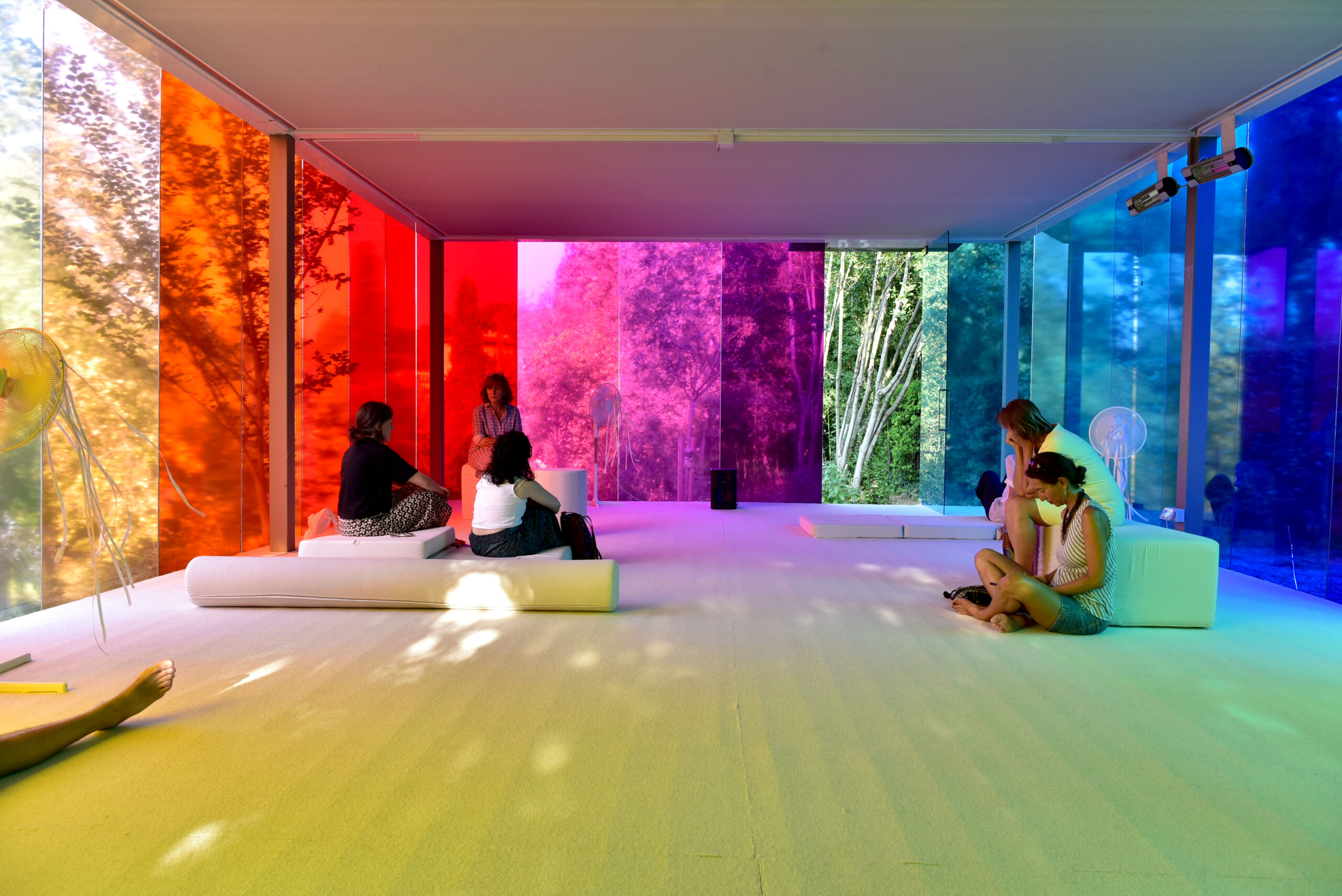
In spring 2021, the archive of the radical Florentine architecture group Superstudio was handed over to MAXXI Museum in Rome.
What happens when documents and works that are central to the history of art and architecture are no longer in the hands of their producers, but become part of institutional archives?
In the 1960s – during the student movement and after the Great Flood – Florence was a dynamic center of so-called “Architettura radicale”, Radical Architecture, in Italy. Architects and collectives such as Superstudio, Archizoom, UFO, Zziggurat, 9999 and Gianni Pettena questioned architecture as a discipline, and urged radical reforms for the present and future. In 1972, the radical Florentine architects took the Museum of Modern Art in New York by storm with the exhibition Italy: The New Domestic Landscape.
In the 1980s and 1990s, Superstudio’s conceptual and innovative work was temporarily forgotten. But around 2000, the Centre Pompidou in Paris showed interest in their archive and acquired a large number of works for its collection. Since then, researchers and international institutions have paid tribute to Superstudio’s critical and theoretical projects, most recently the CIVA Museum and Research Centre in Brussels with its major exhibition Migrazioni.
Meanwhile, Florence has forgotten about its contemporary architects for years. Many important archives of 20th century art and architecture have now left the city forever. In the end, Superstudio’s archive was handed over to MAXXI Museum in Rome in spring 2021.
In this three-part series, Gian Piero Frassinelli – a member of Superstudio since 1968 – talks about architecture as a conflicting space, Superstudio’s extraordinary work, and its archive, which he curated for many years.
imagesRECITAL
Felicita Marcelli
E il popolo canta
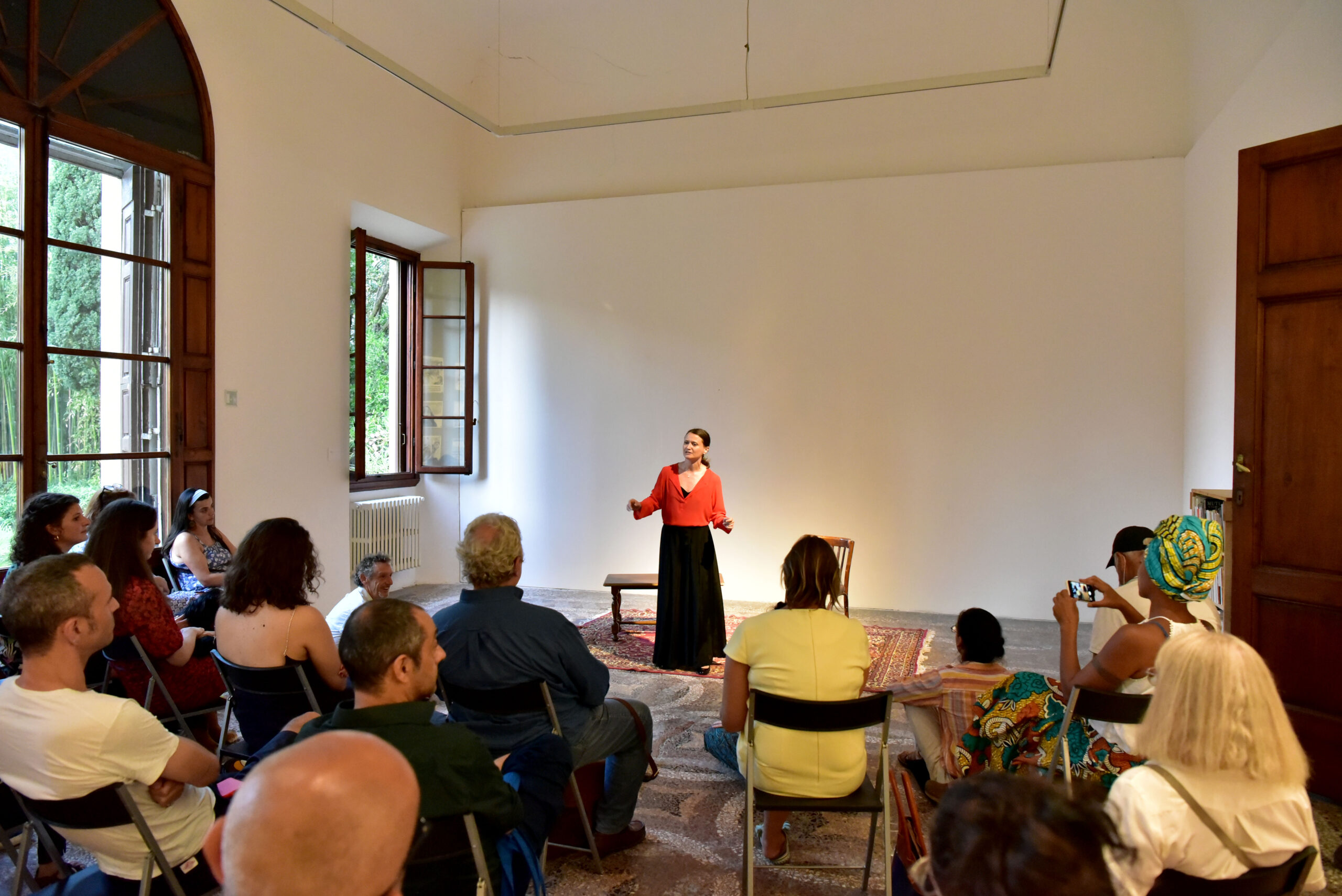
‘It was a kind of nightmare, in which we saw all around us Italy destroying itself and disappearing. Now we are perhaps waking up from this nightmare and looking around us, we realise that there is nothing more to be done’. (P.P. Pasolini)
E il popolo canta (And the People Sing) is an investigation in the form of a recital into traditional songs from central and southern Italy and their relationship with the poetry of Pier Paolo Pasolini. It takes us back to a world that no longer exists, to a musical landscape of oral tradition that has now disappeared from the living culture of the people, and is mostly forgotten. Not just a concert, but an evocation of that human and sound world, in an attempt to revive it for a few moments, as in an imaginary memory. Interwoven with the song, Pasolini’s verses ask us about the legacy of the epochal changes that took place in Italy after the Second World War, of the rapid development that in just a few years led to the disappearance of those ‘various ways of being human that Italy had historically produced in such a differentiated way’. The songs that make up this work, in various dialects of the centre-south, come from archive sources recorded between the 1940s and 1960s, the result of ethnomusicological research carried out in Italy and among communities of Italian emigrants in the United States (by, among others, Colacicchi, Nataletti, Carpitella and Lomax).
Accademia dell’incompiuto
E il popolo canta was produced by: Fondazione Teatro della Toscana.
With: Felicita Marcelli
Directed by: Mario Biagini
Duration: 60’
We would like to thank Mr. Emiliano Migliorini, Scientific Director of the Valle dell’Aniene Museum of Rural Life, for his advice. Poetic texts by Pier Paolo Pasolini taken from the collections, published by Garzanti, Le ceneri di Gramsci and Poesia in forma di rosa.
images
PUPPET THEATER
Performance Desperately in Need of an Audience
The Arab Puppet Theater Foundation
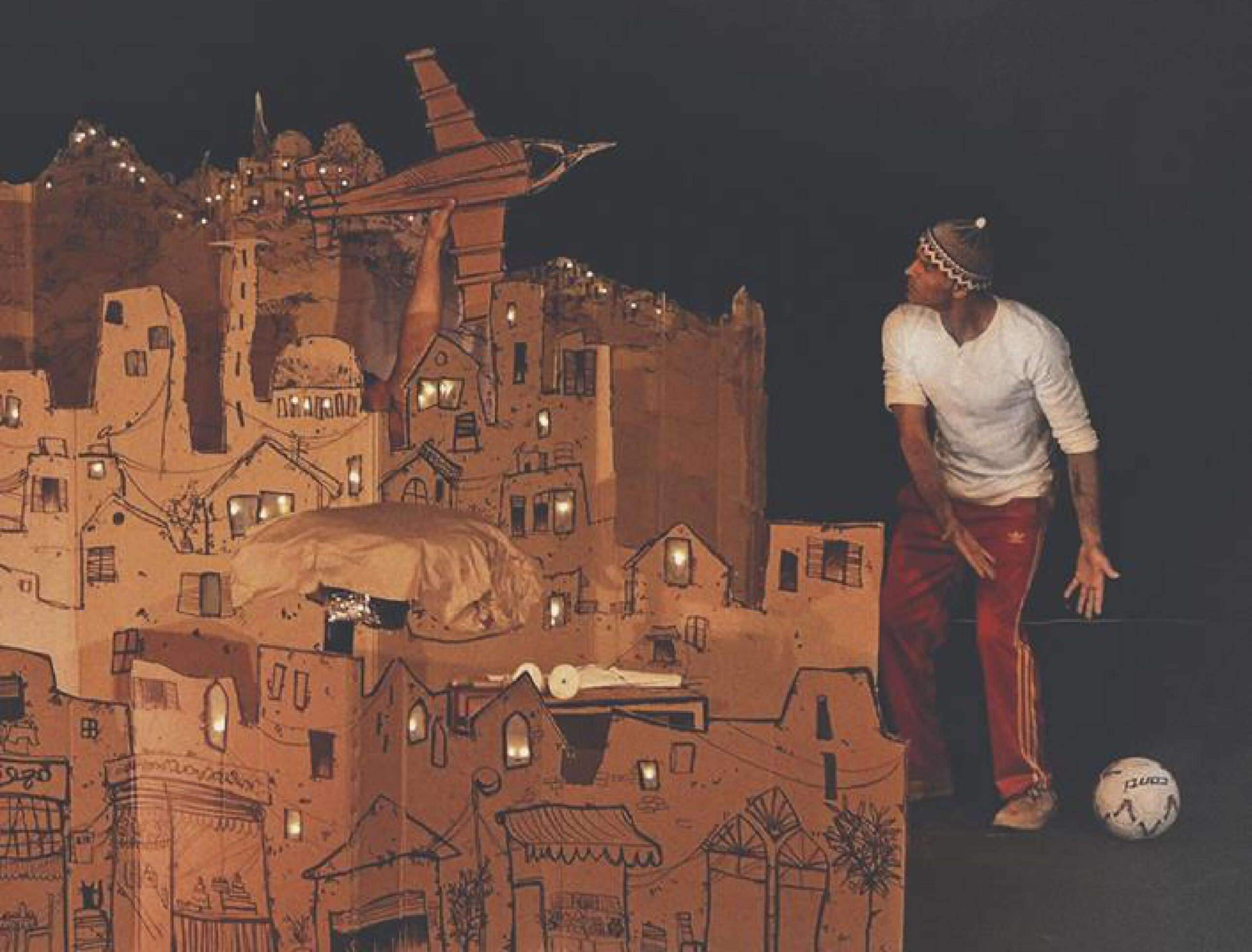
Produced and performed by Arab Puppet Theatre’s full-time team, this fast-paced show was conceived in 2015 and has been touring ever since. It uses comedy and satire to tell a story about migration and has toured cities across the world in countries including Tunisia, Lebanon, Doha, Sweden, Denmark, Germany, Belgium and the United Kingdom.
The Arab Puppet Theatre Foundation (APTF) was founded in 2008 as a non-profit organization with the mission to encourage puppetry practices throughout the Arab world and advance new developments in the field whilst simultaneously functioning as an established puppetry school and theatre.
APTF was born out of a need for a space in the Arab world for curious and passionate students interested in the art of puppetry. The initiative is the very first of its kind and provides a vital platform to revive, advance, continually challenge and rethink puppetry in the Arab world whilst encouraging and supporting the professional development of any artists interested in puppetry practices.
HAPPENING / LA GRANDE GRIGLIA
Giacomo Zaganelli
La grande griglia

Giacomo Zaganelli works as an artist, curator, and researcher at the border between art, architecture, and space – meant as resultant of landscape, environment, and territory – operating with a site-responsive approach and engaging local people during the process.
images